'A' through 'Kor'
|
|
|

|
George Adams - (c1709/09-1773) London, England. George Adams was a Sciemce writer and Mathmematics Instrument Maker to His Royal Highness, George Prince of Wales and later George III. Adams was best known for A Treatise Describing the Construction and Explaining the Use of New Celestial and Terrestrial Globes (London: 1766). His unique design using a thin blade to keep the arms aligned when closed. The only other Maker that used this technique was Thomas Heath.
In 1748 he produced a 12 inch brass circular slide rule with a spiral scal and 10 windings.
|

|
Robert Adams - Enfield, South Australia. Collector. Member of the Oughtred Society,
Graduated with a Electro-Technology Diploma from the SA Institute of Technology in 1970, using
a slide rule (Thornton P221) and with a Engineering Degree in 1979 using a electronic calculator
(HP25). Joined the Electricity Trust of South Australia in 1968 and worked in a variety of
distribution, transmission and generation fields. Managed the Test and Investigation Department
of the Electricity Trust of South Australia and currently works as the Principal Strategist in
Asset Strategies for ElectraNet SA. Started collecting slide rules approximately 10 years ago
and has currently 400+ rules in the collection. A main focus of the collection is Electro
slide rules and rules that have hyperbolic functions.
|

|
Peter Alfeld - Salt Lake City, UT. Collector. Member of the Oughtred Society,
Mathematical Association of America, and American Mathematical Society. Professor of
Mathematics at University of Utah. He studied at the University of Hamburg for three years
and then moved to Dundee,Scotland to do graduate work. After marrying a California wife, they
moved to Salt lake City, Utah. Peter's favorite slide rules Faber-Castell 2/83N and Aristo Hyperlog.
His website at U of U.
|

Note: Ahrend celebrated 100 years in
1996, and was given permission to carry the predicate 'Koninklijk' (Royal).
The company established the Jacobus Ahrend Fund in 1997 in his honor.
|
Jacobus Ahrend - (1875-1956) Netherlands. Founder of The N.V. Wed. J. Ahrend & Zoon
(The Widow J. Ahrend & Son, Ltd) in 1896 at the age of 18. He first started an office stationery shop at
Singel 24 in Amsterdam, under his mother's name. A tricycle was his first truck. Ahrend soon expanded
the range of goods carried
to include drawing tables, drawing requisites, collotype machines (a precursor of the photocopier)
and water levels. In the 1920s, Ahrend started to sell office furniture and soon saw a rapid
increase in the numbers sold. The initial furniture was all made of wood, but it was not long
before steel furniture was added to the range. Steel furniture was later banned because of WWII.
After the war he founded the Amsterdam Trade association in 1947. In 1948 Ahrend was
restructured and changed its name to Sun. J. Ahrend & Zoon's. Ahrend were no instrument makers
as can be seen in the ISRM galleries where rebranded Ahrend slide rules
were made in Japan and Germany.
.
|

|
E. Charles Alvarez - United States. Educator and author of electronic books used
in junior collegs, including Using the Slide Rule in Electronic Technology (1965) and
Fundamental Circuit Ananysis 1983. After service in the U.S. Navy and Merchant Marine,
Alvarex graduated from San Fernando State College and later became an associate professor at
Pierce Colleg in Woodlandhills, California in 1955. First class FCC license and was a member
of Institute of Radio Engineers and contributor Industrial Electronic Engineering.
|

|
George Anderson - United States. Collector of slide rules and transits. Friend of ISRM. Graduated from the USAF Academy in 1964. Served 22 years in the USAF as a pilot and Aeronatical Engineer. Earned his Masters degree in Aeronatical Engineering in 1973 from USAF Technology School.in Wright-Patterson AFB, OH. Served as the director of the Travis Air Museum and supervised the recovery of 27 historic aircraft from around the world. Worked at TRACOR Aeospace and later with United Airlines as a staff engineer. In 1995 he worked as an investigator for the National Transportaion Safety Board (NTSB) in Washington, DC.Most recent employment was with Titan Corp, as a Senior Systems Engineer. Gearge helped in develope a search startegy for finding Amelia Earhart's missing Lockheed aircraft. George is active in the ISRM weekly social meetings.
|

|
Albert John Anido - (1883-1949). Great Britian. Inventor of 'The Anido Slide Rule',
British Patent: GB 195,286 March 29, 1923.
Known history: Albert John Anido was Born in Montevideo, Uruguay (1883). Mentioned as an elected student in the Journal of the Institution of Electrical Engineers, Volume 40 (1907-1908) page 411. Graduated B.SC.(Eng) at the University of London in 1909. The 1914-1919 roll of service includes an Albert John Anido (sn 73845) of the Jerseymen of military age who fought in the First World War and the 21 March 1916 London Gazette lists the London Electrical Engineers: Corporal Albert John Anido to be Second Lieutenant (on probation) working with the anti-aircraft corps. His last profesion was as an Engineering Tutor. Besides his slide rule patent, Albert Anido obtained GB 260,497 Indicating ringing of bells to operators in 1926.
|

|
Erhard Anthes - Markgroeningen, Germany. Member of IFHB, Oughtred Society, Scientific Instrument Society. Retired professor of didactics of mathematics, Ludwigsburg University of Education Germany. Publications about mechanical calculators found at Museum mechanischer Rechenmaschinen and some about slide rules. Collector of mathematical instruments.
|
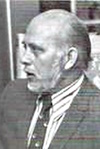
|
Stanley (Stan) Arlton - (1925-2007) South Dakota, United States. Co-founder of Arlton Workshop in Lennox, South Dakota,
consisting of three brothers. In 1959, Stan designed and produced the Arlton "Cadet" circular pocket slide rule and the Arlton Conversion Slide Rule.
He attended Mitchell Public Schools and received his undergraduate degree from Augustana College in Sioux Falls, S.D., and his masters degree in math
from Western Connecticut State University. During WWII, he was inducted into the U.S. Army as a high-speed radio operator.
Supposedly, only by heresay from a post of one of his H.S. students, his circular conversion slide rule was flown on the first Apollo moon mission as a computer backup.
His first teaching position was at Tripp High School in Tripp, S.D., where he taught math, physics,
chemistry and English while also serving one year as the school principal, and later taught at Hillcrest Academy.
|

|
Isaac Asimov - (1919-1992) United States. Author of Science fiction novels as well
as math books including An Easy Introduction to the Slide Rule (1965). Slide rules
were mentioned in many of his futuristic 'Robot' novels.
Born in Russia, and immigrated to the United States at age 3.
Asimov attended New York City Public Schools, including Boys' High School, in Brooklyn,
New York. Graduated from Columbia University in 1939, returning to earn a Ph.D. in biochemistry in 1948.
During World War II he for three years working as a civilian at the Philadelphia Navy Yard's Naval Air Experimental
Station. After completing his doctorate, Asimov joined the faculty of the Boston University
School of Medicine, with which he remained associated thereafter. From 1958,
in a non-teaching capacity, he turned to writing full-time. Asimov's personal papers
from 1965 were donated to the university's Mugar Memorial Library.
|

|
John Vincent Atanasoff - (1903-1995) Theoretical Physicist and Electrical
Engineer. Father of the First Digital Computer, the Atanasoff-Berry Computer or
the ABC, built by John Atanasoff and Clifford Berry at Iowa State University
during 1937-42. Atanasoff had developed a photographic film based slide rule
(approximately 100 feet long) which would give him computational accuracies of
6 to 8 significant figures for solving gas constants. Although he used many
index marks to help correct errors in the expansion of the film, the medium
was hard to control. Frustrated with not finding a solution to this problem,
he contemplated an alternative to the slide rule and the rest became history.
(reference: John V. Atanasoff II, Boulder, CO) Scans of his three slide rules
at ISRM were provided by the Iowa State University Library,
Atanasoff Archives.
.
|
Top
A
B
C
D
E
F
G
H
I
J
K
L
M
N
O
P
Q
R
S
T
U
V
W
X
Y
Z
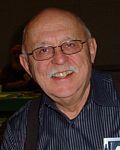
|
Bruce E. Babcock, Phd - Amanda, OH. Principal Illustrator, Journal of the Oughtred Society.
Fellow of the Oughtred Society. Eclectic Collector of oddities. Mechanical Engineer in heavy industry.
|

|
Colin Barnes - (1940-2016) Fordham, Cambridgeshire - England.
Collector. Oughtred Society Award 1996. Member of UKSRC and contributing author to
The Gazette and Slipstick. Helped put together the display at the
National Museum of Computing at Bletchley Park. Colin Barnes started his working life as an
apprentice in the shipyard of Vosper Ltd. in Portsmouth, England. He moved to the West Indies
where he was the manager of a small shipyard before setting up his own construction and design
business specialising in steel framed buildings and private housing. On his return to England
he started an architectural and industrial model making business which he ran until retirement.
He started collecting slide rules nearly 20 years ago and joined the Oughtred Society in 1993
becoming an Oughtred Society Award winner in 1996. As a founder member of the U.K. Slide Rule
Circle he produced the Circle's first newsletter as Hon. Editor in 1998, a post he continues to
hold. Colin also started producing the Slide Rule Gazette in 2000 with his co-editor, Peter Hopp
Colin was a contributor of slide rules to ISRM.
|

|
Benjamin B. Bauer (originally Baumzweiger) - (1913-1979) was a Russian-born American acoustic engineer, who worked as Chief Engineer for the Shure microphone company and produced over 100 patents. His early work in acoustics lead to the development of modern sound technology via the Uniphase Electrical Principle. This principle is the source of the famous Unidyne Microphone's name and functionality. Introduced in 1939, the Shure Unidyne is arguably the most recognized microphone in the world He is the inventor of the Shure Brothers Reactance Slide Rule. In 1957, Bauer joined CBS where he helped develop stereo quadrophonic sound.[12] He went on to become the vice president and general manager of the CBS Technology Center in Stamford, CT, where he lived until his death in 1979. More at wikipedia
|

|
Dr. Bancroft Beatley - (1894-1992). Educator. Inventor of the K&E Beatley I-Q Slide Rule. Beatley was
a 1916 Harvard graduate and served in the
U.S. Army from June 1917 to January 1919, attaining the
rank of first lieutenant. On returning to Harvard he earned
his doctorate in education in 1923, taught at Harvard, and
rose to associate professor before leaving in 1933 to become
president of Simmons College, a Boston technical school for
girls. He remained at Simmons until 1955 when he retired. It was during the writing of his thesis in 1922 that he copyrighted the design of the Beatley I-Q Slide Rule, the year before he earned his doctorate. The slide calculator is an unusual single-purpose
device for determining Intelligence Quotient (IQ)
given a youngster's physical age and his mental age (apparently
determined by a standardized test). More specifically,
the rule is designed for use in calculating the IQ of young
people from ages 3 to 18 with IQs ranging from 30 to 170. It was produced briefly by K&E and marketed by Edward E. Babb & Co., a distributor of educational supplies.
|

|
Thomas Belcher - (1796-1855). Born in Yorkshire, England. The son of the English rule maker, Zachariah Becher I, began making rules in New York in 1821 and was joined by his brother, William, in 1825. Around 1831, another brother, Charles, joined the firm, and the company's name was changed from T. & W. Belcher to Belcher Brothers. Around 1843, manufacturing of rules moved to New Jersey and the firm went by the name Belcher & Bros. Around 1853 some of the men's sons joined the firm, and the name was changed to Belcher Bros. & Co. The company had become the largest American manufacturer of rules, but it was surpassed by Stanley in the second half of the 19th century. Belcher stopped manufacturing rules around 1877.The picture is when he was 37. He died in New Jersey, USA.
|


|
Auguste Beghin - France. Produced his Rèle des Escoles in France in 1907.
This had a displaced scale by √10 and, with the Mannheim rule, became another
standard used by a number of manufacturers. He also produced his Rèle à Calculs in 1898.
|
_th.jpg)
|
Mayer (Maeir) Berlin - Milano, Italy. An engineer who founded of TECNOSTYL in 1948, a
slide rule and technical instrument company in Milano, Italy. Mayer Berlin's sons, Gino and Guido
Berlin, still operate the company today.
|

|
Carl M. Bernegau - President of K&E from 1942 to 1945. Carl was a son-in-law of the K&E founder married
to Louise Keuffel. His influence stimulated company growth during
the difficult Depression years. Under his leadership, K&E achieved true stature as an instrument manufacturer,
and built a tough, relilient production team, tempered by the rigorous demands of war, ready to meet the new
demands of peace after WWII.
|

|
Giuseppe Bianchi - Capannori, Lucca Italy
|
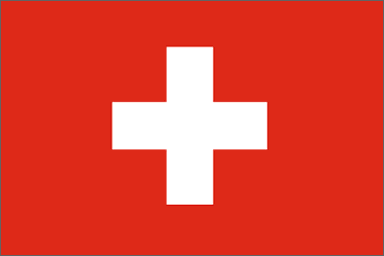
|
Julius Billeter - (1828 - 1914) Zurich Switzerland. Inventor, Designed the Calculating Roller, a cylindical slide rule
that was patented in France in 1891, Gemany in 1893 and in the US in 1894. The company was later renamed National Rechenwalze.
|

|
Calvin Collier Bishop - Pasedena, CA. Author/Inventor/Teacher. Professional Electrical Engineer.
and teacher. Graduate of Syracuse University. Taught at the Buffalo Technical High School, University of Buffalo,
the YMCA Institute of Technology, and the Engineering Society of Buffalo. In 1955 he retired
from California Institute of California. Best known for his text Slide Rule, A practical Guide to its Use also know as
The Slide Rule and How to Use it published by Barnes and Noble. Also wrote Electrical Drafting and Design
and Alternating Currents for Technical Students. Co-authored US Patent #1945140 Surgical Electrode issued Jan 30, 1934.
His slide rule book is downloadable in the ISRM library.
|

|
Donald Black - Talent, Oregon. Co-editor, Journal of the Oughtred Society.
Handles mailings for the Society.
|

|
James R. Bland - (1898-1984) Math Professor. Co-Developed, along with Frank Adorney, a new slide rule, the Hudson 8, which became the
Deci-Lon 68-1100 for K&E in late 1960 and early 1961. James Bland had a long history with K&E. He shared
authorship of the manuals for the K&E 4080-3 and 4081-3 with Lyman M. Kells (his senior) and Wills F. Kern; all were math professors at the U.S. Naval Academy
in 1937. Bland is pictured in the
1928 USNA yearbook
with other Mathematics professors.. Bland also shared the patent for the Power Trig Slide Rule (K&E 4110) in 1942. In 1947
Bland had a patent of his own for the new scale set for the N4080-3 and N4081-3 released by K&E in 1947. Even though
K&E lost a lawsuit defending the patent, this scale set with a little modification became the mainstay of the K&E slide rule
line until the Deci-Lon arrived Professor "Pop" Bland, was assigned to the Mathematics Department, U.S, Naval Academy, and his purpose
was to make slide rule use easier for students. More: JOS article V19.2 p39-44
|
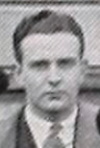
|
Willis Frederick. Kern - (1903- ????) Mathematics Professor and Author. He became an associate professor at the U. S. Naval Academy at Annapolis, MD, and is pictured in the
1928 USNA yearbook with other Mathematics professors..
While on staff at the U.S. Naval Academy, he collaborated with Lyman M. Kells and James R. Bland to write the slide rule
instruction manuals for Keuffel & Esser of Hoboken. New Jersey.
Those manuals would continue to be used for most every model of slide rule survive until the demise of K&E in the late 1970's.
He was author or co-author of several books used by the Academy, including Piloting and Maneuvering of Ships, by Lyman M. Kells, Willis F. Kern and James R. Bland
Spherical trigonometry, with naval and military applications, by Lyman M. Kells, Willis F. Kern and James R. Bland and Navigation by Lyman M. Kells,
Willis F. Kern and James R. Bland [McGraw-Hill 1943. In total he published 37 works and co-authored many with James R. Bland.
|

|
Rick Blankenhorn - Fallbrook, CA. Dealer. Fellow of the Oughtred Society.
Owner of The Gemmary, source of
slide rules and other antique instruments.
|

|
Hans Bloemen - Germany/Netherlands. Collector. Member of the Dutch Circle of
Historical Calculating Instruments (KRING - Rekenlinialen). His collection at
Calculator Museum
is focused on early Electronic calculators as well as slide rules.
Hnas writes: "I collect early electronic calculators since beginning of 2001. At first I started to collect old computers and all calculators I could get,
but space ( I had over 1600 different calculators) forced me to decide that I had to specialize myself. The key collection is the early
nixie tube desktop calculators, early pocket calculators of the brands Hewlett Packard, Texas Instruments, Litronix and the
russian brand Elektronika. Besides those brands I also search for calculators of calculating devices, which are special or
are the start of a new era in calculating"
|
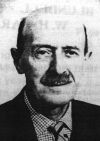
|
Henry Alison Blundell - (1896-1990) Grandson of Henry Blundell, the founder of the
family business, Blundel Brothers Limited. Henry took a personal interest in the company's fledgling
slide rule line and with the help of an employee and German immigrant, Fritz Hammelburger,
designed an innovative process for making inexpensive slide rules.
They co-authored the British patent # GB602286.
|

|
Allan J. Boardman - (?-?) Allan received a B.S. degree from MIT in Aerospace Engineering. He was hired by Pickett Industries from 1956-1959, as a staff assistant to John Pickett (Pres) and Milt Patrick (VP). During this time, when Pickett was transitioning from Magnesium to aluminum stocks, he instituted improvemnts in the quality control processes, worked on design improvements, modernized packaging, helped put in place and monitor a program for improved manufacturing efficiency, developed new product ideas, gave class room demonstration and worked trade shows. He left Pickett and spent 40 years in the space business, retiring in 1996 from the Aerospace Corporation as Group Vice President for Engineering and Technology. His time at Pickett is documented in this 2007 Journal of the Oughtred Society article
. Recollections of a Pickett Industries Employee. During his retirement in Woodland Hills, California, he has become well known as an avid woodworker making intricate puzzles. He is the only craftsman who makes miniature puzzles that will fit into a one-half inch (13 mm) or less cubic space. He calls himself a microxylometagrobologist.
|

|
Wilfred J. Boos - United States. (1934-1989) Became president of Acu-Rule Mfg Co. in 1946.
Lived in Clayton, Missouri circa 1949. Inventor of record of U.S. Patent 2,594,857 (files 1949, issued 1952) which was
assigned to the Acu-Rule Manufacturing Company, St. Louis, Missouri. An
implementation of this patent is the Charvoz-Roos 105D. A later Boos patent. US 2.701,687 (1955) showed the finger holes that were on the early magnesium Acu-math slide rules. It is believed that Boos operated
Acu-Design for a short time, independant of the Acu-Rule Company, to provide scale artwork
to other slide rule manufacturers.
|
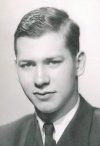
|
Bernard (Bernie) Carter Boykin - (1921-2011 ) Born in Ruxton, Maryland. He earned
a BS degrees in Chemistry from Williams College in 1942/43 and another in Chemical
Engineering from John Hopkins University in 1954. During World War II he was a
radar officer in the United States Navy. Bernard manufactured the Boykin RotaRule
from his home in Ruxton, Maryland. His design was started in 1957, with manufacturing
commencing in the early 60's. Though based on the expired patent of Dempster's
RotaRule, last built in 1948, Boykin improved the slide rule with better materials
and scale arrangements. One change was dividing the scales using decimal degrees rather
than minutes and seconds. About 200 units were sold prior to 1973. He owned Boykin
Electro Tech and in 1991 founded the Whitby/Brewer (Yacht) Association. As of 2009
he was active at age 85 and enjoyed sailing with his wife Carolyn.
|
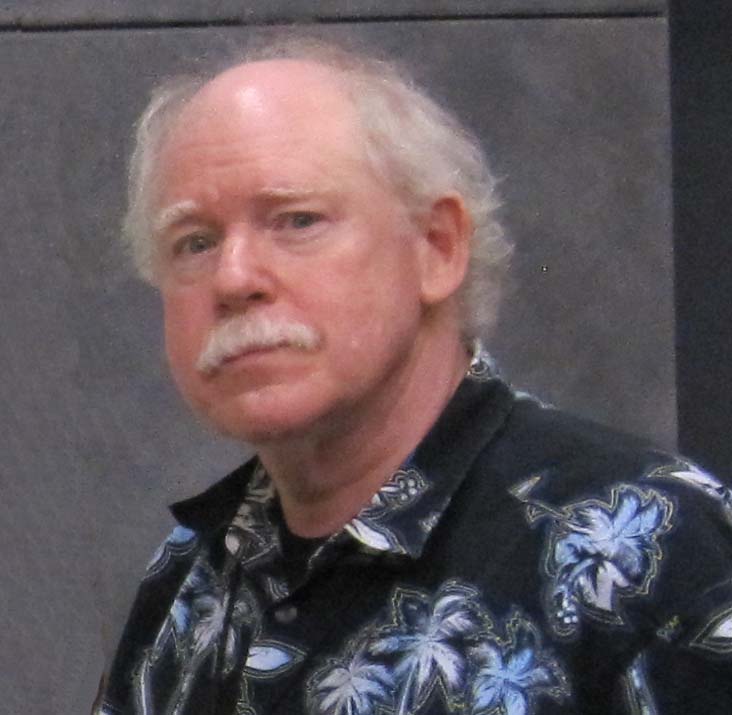
|
James (Jim) Marshall Bready - Seal Rock, Oregon. California Polytechnic State University (Cal Poly). Collector Editor of the Journal of the Oughtred Society. OS Fellow..Contributor of slide rule scans for the ISRM Slide Rule Instructions Preservation project. He tirelessly spends considerable effort in assisting in dispursing of collections from OS Members.
|

|
William Edwin Breckenridge - (1869- ????) United States. Author of many early slide rule
instruction manuals for the Mannheim and Polyphase (1924) and Polyphase Duplex (1924, 1938, 1944, 1954), Log Log Duplex (1932)
slide rules for the Keuffel & Esser Company. He also wrote "War problems in mathematics" c1918, "Shop problems in mathematics" c1910.
Associate in Mathematics, Columbia University, New York City.
|

|
Giovanni Breda - Italy. Collector and contributor of European slide rule scans for the ISRM galleries. The Italy gallery is comprised mostly of his collection
. His maintains an extensive website at sliderules.it.
|
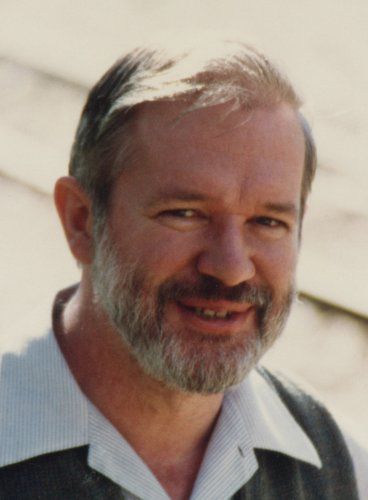
|
Allan G. Bromley - (1947-2002) Australia. Australian historian of computing who became a world authority on many aspects of early computing and was one of the most avid collectors of mechanical calculators.
His work on understanding Charles Babbage's calculating engines is Allan Bromley's greatest legacy. The October-December 2000 issue of the IEEE Annals of the History of Computingwas dedicated to him for the quality of his research on this subject.
His studies of the Antikythera mechanism led to the first working model of this ancient analog computer. Allan Bromley was an associate professor at the University of Sydney. His main academic interest was the history of computers.Many of specimens from his collection can
be seen at the Powerhouse Museum.
|

|
Joost (Jobst) Bürgi (Buergi) - Lichtensteig, Switzerland . (1552-1632) Swiss clockmaker
and mathematician. He invented logarithms independently of John Napier, since his method is
distinct from Napier's. Napier published his discovery in 1614, and this publication was
widely disseminated in Europe by the time Bürgi published in 1620, at the behest of
Johannes Kepler. There is evidence that Bürgi arrived at his invention as early as
1588, six years before Napier began work on the same idea. By delaying the
publication of his work to 1620, Bürgi lost his claim for priority in historic
discovery. Bürgi was also a major contributor to prosthaphaeresis, a technique for
computing products quickly using trigonometric identities, which predated logarithms.
The lunar crater Byrgius is named in his honor.
|
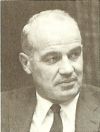
|
Alfred E. Busch - President of Keuffel & Esser from 1961. Alfred was a grandson of the K&E
founder (His mother was Ottilie Keuffel Busch). K&E experienced its most rapid
growth under his presidency. It was a period marked by emphasis on science-oriented technology,
a diversification of product lines, a strengthening of market position in the united States and overseas.
Perhaps the most significant event during his reign was hi direction of the company toward public
ownership in 1965, with the new attitudes and flexibility which this step created.
|

|
Edward Dean Butler - United States. Collector. Member of the Oughtred Society. Michigan State University In March 1983, Butler quit his job at Procter & Gamble and opened LensCrafters,the world's first one-hour-service optical store. Within four years, there were more than 400 LensCrafters stores across the country; it was the largest optical retail business in the world. In the late 1980s, Butler sold LensCrafters to U.S. Shoe Company and took his 'glasses-while-you-wait' concept overseas. He began opening stores in England, Australia and Italy. The first overseas store,Vision Express opened on Oct. 13, 1988, in Australia. Today, he has the number one optical retail business in Russia, with more than 100 LensMaster stores in operation. All told, he has had optical stores in 28 nations. He collects slide rules and open-wheeled race cars in retirement.
|
Top
A
B
C
D
E
F
G
H
I
J
K
L
M
N
O
P
Q
R
S
T
U
V
W
X
Y
Z

|
Florian Cajori - (1859-1930) Emigrated to the United States from Switzerland
in 1875. Educated at Wisconsin University and John Hopkins and later was Dean
of mathematics at Colorado College in Colorado Springs, Colorado from 1889 through 1918. Cajori received his doctorate from Tulane University.
He is best known amongst slide rule historians for his book History of the
Logarithmic Slide Rule (5.6MB PDF) published in 1909, in which he described 256
designs of slide rules since 1800, 90 of which were produced in the first nine
years of the 20th century. Florian Cajori was one of the founding members of the Mathematical Association of America
and served as its second president in 1917. The Colorado College Mathematics Department first hosted a MAA Rocky Mountain Section meeting in
1920 and has done so seven times in the 20th century.
More Cajori history from Colorado College
|

|
Olivier Cassou - ( - 2017) Bordeaux, France. Agronomist. and farmer by profession. Member of the
Federation Nationale des Syndicats d'Exploitants Agricoles (FNSEA) and
of the Chamber of Agriculture. Collector of curiosities. Contributor of
scans to ISRM.
|

|
Guillermo Castarés - Argentina. Collector. Started collecting slide rules and some
electronic calculators in 2002. He is the webmasters of the first spanish written sliderule site, now renamed
"INSTRUMENTOS DE CALCULO - COLECCION CASTARÉS" (www.idccc.com.ar) and member of ARC (Spanish Speaking
Slide Rule Forum). Website
|

|
Clayton (Clay) Castleberry - (1927-2021) Oroville, California, USA. Collector, Fellow of the Oughtred Society.
Contibutor of scans to ISRM and donor of slide rules to the ISRM Loaner program for schools.
Retired county engineer/director of public works. Collection is focused on K&E, Pickett
and Gilson. Favorite SR is his K&E 4081-3 from went he attended Oregon State College.
(now OSU) in Corvallis, Oregon.
|

|
Trevor J. Catlow - Southeast England. Collector. Member of the Oughtred Society. Retired computer software specialist. Trevor bought his first slide rule, an Aristo Scholar,to use at school, and his second one about 2007. Since
then his collection has grown to about 80 rules, but he still has the
Scholar. Contributing author to the Journal of the Oughtred Society.
|

|
Cyril B. J. Catt - Australia. Collector. Fellow of the Oughtred Society. Was
captivated by the magic of the slide rule in grade school. Used a 5 inch FC addiator
model through RAF radio school, Bachelor's ( Agric. Science; Farm Management; Dunelm)
and Master's (Economics; UNE) degrees. As farm management adviser in Western Australia,
and regional farm management research economist in New South Wales, he favoured shirt
pocket portability of Concise circular rules for field work. Serious researcher and
collector since 1995, now with an eclectic mix of some 300 slide rules. Particularly
interested in history of Australian slide rules. Frequent contributor of information
to International Slide Rule Group and to the ISRM.
|

|
Jim Cerny - New Castle, New Hampshire, USA. Fellow of the Oughtred Society.
Creator of the Oughtred Society?s original website, advanced slide rule researcher and
collector; has premier collections of 10 cm slide rules, Logarex slide rules,
and Faber-Castell slide rules with addiators on the back. Helped the ISRM
curator in the early stages of collecting.
|

|
Edwin J. Chamberlain - Etna, NH. Collector/Author/Arctic Engineer/Conservationist.
Fellow of the Oughtred Society and on its Board of Directors. Specializes in collecting "long scale"
and "decimal keeping" slide rules and their histories. Ed has written many articles about these slide
rule types and welcomes new data concerning them. Also interested in slide
rules dating before the early 1900's including early K&E and Lenoir/Tavernier/Gravet slide rules.
|

|
Charvoz, André (Andre) and Angele R. - (1892-1969). New Jersey. United States Manufacturer. Born in France. Became president of Manufacture Francais de Compas of Ligny en Barrois, in France. Later immigrated to the U.S.A. and was a founder of Charvoz, Inc in 1939 and with his wife Angele, were partners with another family, the Gottheimer's, in the Roos Company which manufactured slide rules in New York and distributed re-branded drafting tools made by Ecobra throughout the United States. André's wife, and business partner was Angele Charvoz (1900-1982, died Clifton, New Jersey).
The Roos Company and Charvoz Inc. were merged into Charvoz-Roos Corporation in 1946.
|

|
Henri Chatelaine - (c.1878) Paris, France. Instrument maker. Designed and manufactured the
Calculigraphe, a pocket watch style slide rule,based on the Boucher's System.
|

|
Marvin Clarence - Jakarta, Indonesia. Collector. Advisor to the ISRM curator as head of public enlightenment. Assists the curator in researching slide rule ephemera in multiple language platforms.
|

|
Henry Coggeshall - Inventor of the Coggeshall slide rule in 1677. It was intended to facilitate measuring the dimensions, superficies, and solidity of timber. With his original design and later improvements, Coggeshall's slide rule brought the tool its first practical use outside of mathematical study. It would remain popular for the next few centuries.
Coggeshall first described this apparatus in a paper he released in London. After improving the design, he republished his work under the title A Treatise of Measuring by a Two-foot Rule, which slides to a Foot (1682). He released a highly modified version in 1722 titled The Art of Practical Measuring easily performed by a Two-foot Rule which slides to a Foot. By 1767, seven revised editions had been released.
|

|
Marc-Yvon Comeau - Montreal, Quebec, Canada. Collector. Member of Oughtred Society. Marc-Yvon spent 27 years with Nortel Networks working in Product Development, Manufacturing and Test Engineering, and Installation and Commissioning.Became Director of Engineering and Product Development for ComSonics. Marc-Yvon has 36 years of diversified experience in the telecommunication and test equipment industries.
|

|
Nelson Magor Cooke - (1903-1965) was a leader in developing electronic schools of the United States Navy, the recipient of the Navy Commendation Medal and Medal for Humane Action, a post-war engineering entrepreneur, and an author of books on applied mathematics and basic electronics. He enlisted in the U.S. Navy as an Apprentice Seaman on 22 November 1920, and progressively rose in rank through Petty Officer and Warrant Officer to Lieutenant Commander before retiring on 1 May 1951. After leaving the Navy, he formed and operated the firm Cooke Engineering. in Alexandria, VA and later San Mateo, CA. His company was bought by Dynatech in 1968. Cooke began professional writing in 1934, and continued with multiple-edition technical books throughout his life. He developed the Cooke Radio Slide Rule (K&E model 4139) which was produced by K&E from 1942-1967.
Wikipedia Entry
|

| -->
Martine (Tina) Cordon - United Kingdom. Collector. Graduate Electronics Engineer working as a Geophysical Wireline Logging Engineer for an oilfield service company. Currently working in the rainforests of Gabonand has worked in 37 different countries so far. Favourite slide rule is the Hemmi 153.. Slide rule collection may be seen at
Tina's Page
|
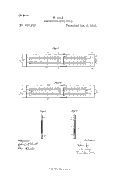
|
William Cox - England. British citizen William Cox received U.S. patent number 460,930 for a duplex "Engineer's Slide-Rule" on October 6, 1891, and immediately assigned the patent to the Keuffel & Esser Company of New York. Author of many early slide rule instruction manuals for the
Mannheim (1891-1915) and duplex slide rules for K&E. Need a picture of Willian Cox
|

|
Guus Craenen - The Netherlands. Collector/Author. Wrote two books about the Nestler Company,
Albert Nestler: Innovation und Qualit? Part I and Part II. He charted on how the slide rule developed and
evolved from 1787 to 1905 and the cooperation between the leading German makers of that era: Dennert & Pape based
in Hamburg and Albert Nestler based in Lahr. In 2009 this researched was published in the book Rechenschieber im Wandel der Ziet 1787-1905
(Slide Rules through Time).His wife, Anjo Craenen-Pprincé;ee allowed the book to be translated in 2022 into English and Spanish
by Jose G. Fernández.
Download in English:Slide Rules through Time 1787 - 1905 or
Spanish (Españnol) La Regla de Cálculo ente 1787 y 1905.
|

|
Allan Reginald Cullimore - (1884-1956) United States. Author/Speaker/Educator. Wrote the The Use of the Slide Rule
(see ISRM K&E and Books Libraries to download) published by Keuffel & Esser in 1915,
while the dean of the college of Industrial Science at Toledo University. Cullimore wrote several slide rule instruction manuals for
Eugene Dietzgen Company as director of The Newark Technical School (founded in 1881) in New Jersey.
Later renamed, New Jersey Institute of Technology. He was president of NJIT from 1920
until 1949 and was responsible for the development of the Newark College of Engineering in 1930.
Honorary Doctorate by Rutgers College on June 14, 1943. 1951 Benjamin Garner Lamme
Award from the American Society for Engineering Education. Major in the First World War. Graduate of Massachusetts
Institute of Technology. Who's Who of America. Today, the New Jersey Institute of Technology issues an annual award named for Cullimore
and there is a Cullimore Hall named in his honor..
.
|
Top
A
B
C
D
E
F
G
H
I
J
K
L
M
N
O
P
Q
R
S
T
U
V
W
X
Y
Z

|
Philip Dalton, LTJG. - (1903 - 1941) United States Military Scientist best known
for his invention of several slide-rule flight computers the most famous being
the E-6B Dead Reckoning Computer. a circular slide rule with
a slide used as an aid in aviation navigation and pilotage. As a graduate of Cornell University
and serving as a US Naval Reserve Pilot, Dalton took an interest in slide-rule flight
computers. His first models were designed in the early 1930s but it was not until
1932 that the first revision of the E-6B, originally known as the "Dalton Dead
Reckoning Computer", came into existence. He died in a plane crash soon after going
on active duty as a flight intructor. More Biography.
|

|
Andrew D. Davie - Hobart, Tasmania, Australia. Collector. Fellow of the
Oughtred Society. Oughtred Society Award 2001. Founder of the Slide Rule Forum
discussion group on his Slide Rule Trading Post website, predecessor of the
International Slide Rule Group, who began internet communication among the world
slide rule community. Famous for his Java Slide Rule, now called
UniVirtual Slide Rule Emulator
|

|
David A. Davis - Collector. First created a website in 1996. He specializes in
Relay/ Ricoh OEM slide rules and their variouse rebranded models.
|

|
Richard Davis - Las Vegas, NV. Collector. Fellow of the Oughtred Society.
Retired Electronics Engineer in the semiconductor industry. Collects most all slide
rules, has a comprehensive collection of Reiss mill finish aluminum slide rules,
but prefers the spiral scale cylindrical versions. Favorite is the Rotarule.
Richard organized the 2008 and 2009 west coast OS spring meetings. Contributor
to the ISRM SR Loaner program. Chairman and host of the new OS Winter Meeting
which was held February 2008/2009.
|

|
Philippe Deau - ( - 2016) Versailles, France. Member of the Oughtred Society. Prefer saying
to be first a Slide Rules Lover and then by consequence a collector. Actively monitors the
ISRG message forum. Originally worked in Electronic Engineering, and later as a Sales and
Marketing Manager in technical software activity (C compilers for embedded applications).
|

|
Robert De Cesaris - Granite Bay, California. President of the
Oughtred Society and very advanced collector of slide rules and mechanical
calculators. Expert on pocket watch slide rules and Fuller slide rules.
|

|
Richard Delamain - 1631 - Student of William Oughtred and tutor to King Charles I of Great Britain, invents the circular slide rule, which he describes in his book, titled Grammelogia or the Mathematical Ring, dedicated to the King. His Majesty King Charles I would later give him "...the liberty to teach the use of the instrument in the city of London and elsewhere."
|

|
Oscar de Leon, Sr - (1917-1994) Distributor. Founder of Odelco, De Leon Import & Export Corporation, in the Phillipines which was incorporated in 1952. In 1948
Odelco became the Pacific Rim distributor for Hemmi slide rules. Hemmi
designed the Odelco logo and imprinted it on rules shipped to them.
Oscar De Leon established the ODELCO housing subdivision around 1965,
which is a community in Quezon City, and the school was named for him. Portrait provided by his son, Oscar de Leon, Jr, who was the president of ODELCO. Jr.
|

|
Oscar de Leon, Jr - ( - ) A graduate of Sophia University (1974) and the National Defense College (1987) in the Philipines. In 1977, he took over as president of Odelco, De Leon Import & Export Corporation, in the Phillipines which was incorporated in 1952 and founded by his father Oscar De Leon, Sr. In 1948 Odelco became the Pacific Rim distributor for Hemmi slide rules. Hemmi designed the Odelco logo and imprinted it on rules shipped to them. Oscar De Leon established the ODELCO housing subdivision around 1965, which is a community in Quezon City, and the school was named after him. Oscar de Leon, Jr, is the current president and his son Oscar Ramoncito De Leon IV, Vice President and COO is managing daily operations of ODELCO (the grandson of the founder). Three generations active in the business.
|

|
John (Jack) R. Dempster - (1903-1964) Designer and manufacturer of a
sophisticated circular slide rule in Berkeley, California from about 1928 through
1948*. John graduated from the University of California at Berkeley in 1925 with a
degree in mechanical engineering. He patented (US patent 01849058) and manufactured
two models of his slide rule, starting with the model A and finishing with the model
AA and produced 2500 of these slide rules from his home in Berkeley. Dempster slide
rules carried some 23 scales, including 50 inch spiral C and D scales some models had
surveying stadia scales. These slide rules are quite rare with some 25 known specimens
in the hands of collectors. *Excerpted from "The Dempster RotaRule" by
Rodger Shepherd, JOS Vol 7, No 1, Spring, 1998.
|
|
|
George Dennert - (1900-1992) Grandson of Johann Christian Dennert,
the co-founder of Dennert & Pape, and son of Richard Dennert. Became joint
owner of D&P, along with his cousin Christian Dennert (1896-1944) son of
Jean Dennert, after death of their parents, Jean (1916) and Richard (1924)
in 1924. Created the brand name DUPA for the slide rules.
|
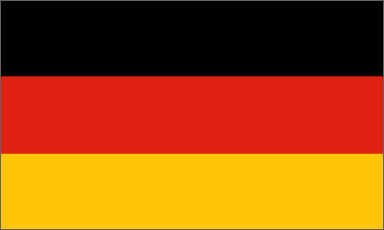
|
Hans Dennert - (1926-2000) Born in Hamburg Germany to George
Dennert, and great-grandson of Johann Christian Dennert, the co-founder of
Dennert & Pape, later Aristo. Graduated from Darmstadt University with an
engineering degree, and one year later he took over the company from his
father in 1952. Aristo became one of the largest slide rule manufacturers
in the world, but ceased production in 1978. Hans continued to provide
assistance to slide rule collectors and was a highly sought after lecturer
up until his death in 2000.Oughtred Society Award 2000.
|

|
Irene Dennert - (1927-2022) Germany. Member of RST. Oughtred Society Award 2000.
Along with husband, Hans, helped in preserving, organizing and sharing the
extensive Dennert/ARISTO archive and collection with museums and collectors,
and intensively supported, published and presented studies of the history of their company.
Obituary (in German) courtesy of Peter Holland and Werner Rudowski.
|

|
Johann Christian Dennert - (1829-1920) co-founded of the firm
Dennert & Pape (D&P) in 1862. Patented (DRP 34583) celluloid scales laminated
on wood slide rules in 1886. Became the sole owner of D&P when Martin Pape
died in 1884. Children Richard (1865-1924) and Jean Dennert (1869-1916)
join (1869-1916) join the company as managers in 1904. J.C. Dennert worked
until age 80 in 1908, died in 1920.
|
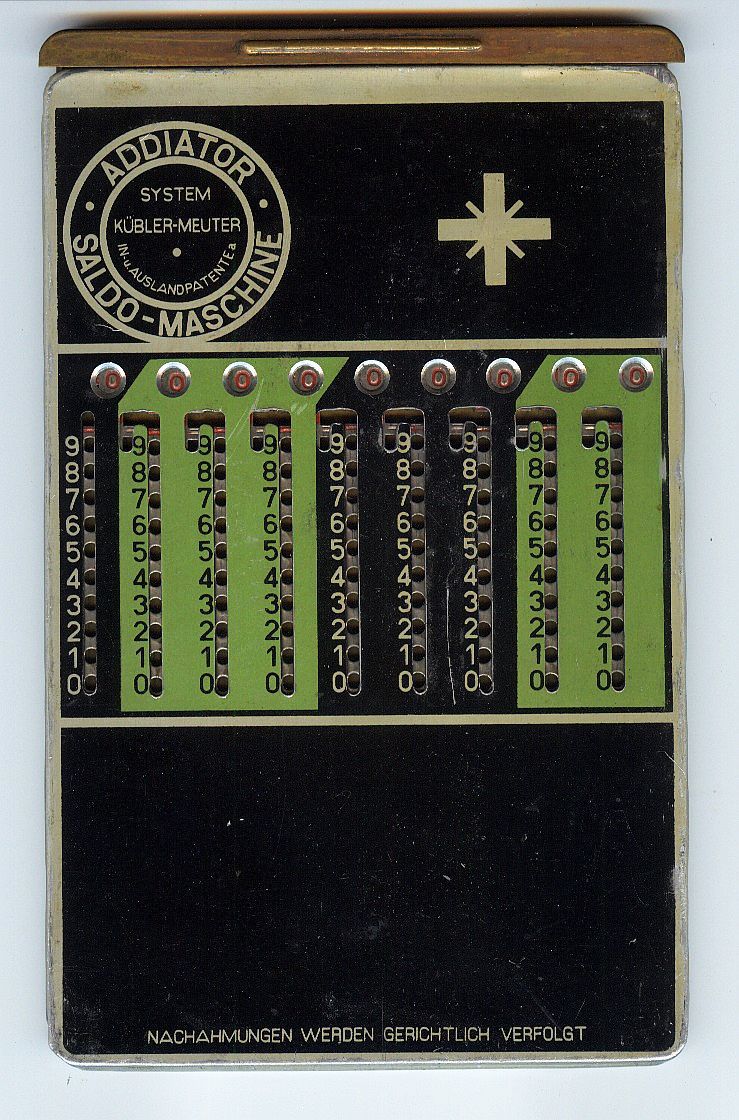 |
Friedrich Diestelkamp - Munich, (Bavaria) Germany. Collector of Addiators.
His Addiator.de website (in German) has the best history of the company
Addiator Gesellschaft founded by Carl Kübler in 1920. Frederick was able to visit
with Margot Schaffhirt-Kübler, the grandaughter of the founder, and to obtain first hand biographical data.
When Friedrich got a Walther WSR160 from a friend he started to collect mechanical
calculators. When he saw first electronical calculators disappearing from market he started
to collect pocket calcs. "When my cupboard crashed down I decided to collect small calcs instead of
big ones.", he said. Friedrich donated most of his collection of mechanical calculators to
HNF Heinz Nixdorf Museums Forum
the world's biggest computer museum in Paderborn, Germany.
|

|
Eugene Dietzgen - (1862-1929) Born in Uckerrath, Germany he immigrated to America between
1878 and 1881 at the wishes of his father Joseph, a socialist philosopher, in order to escape the
draft of the Kaiser as well as to hide some of his father's socialist literature. Eugene settled
in New York where he worked for Keuffel & Esser, as their Midwest sales rep. He subsequently
founded his own engineering supply house in 1885, as both a dealership and manufacturers'
representative in Chicago, Illinois under the name of Luhring & Dietzgen. This later became
just Eugene Dietzgen Compnay and was incorporated 1917. Eugene was very working-class conscious
and provided his factory workers with many amenities not found in the mid 19th century. He died
in Chicago on December 1, 1929. His son, Joseph E. Dietzgen, continued to work in the company.
|

|
Joseph E. Dietzgen - Son of Eugene Dietzgen, who was founder of Eugene Dietzgen Company.
Joseph E. Dietzgen, continued to work in the company after his father's death, residing in Winnetka, Illinois,
and had a U.S. Patent #2,369,819 issued in 1945 for a Log Log Duplex slide rule and later
U.S. Patent #2,543,313 in 1951 for a belt clip for a slide rule sleeve. The business moved
into manufacturing Diazo drafting media. In 1968, Joseph E. Dietzgen, president of Eugene Dietzgen Co.
presented a talk at the annual IABPAI (now IRgA) convention encouraging the industry to
embrace the growing digital computer graphics technology for drafting (i.e. Computer Aided Drafting or CAD).
|

|
Tom Dilatush - San Diego, CA. Collector. Member of the Oughtred
Society. Contributor of scans to ISRM. Practicing software engineer ex-executive.
Enjoys collecting computing devices and documents them on his
website hosted by ISRM.
|

|
Philbert_Maurice_d'Ocagne - (1862-1938) France. French engineer and mathematician. He founded the field of nomography, the graphic computation of algebraic equations, on charts which he called a nomogram.
In 1894 he became a professor at the Ecole Nationale des Ponts et Chaussées. In 1891 he began publishing papers on nomography.In 1901, he was appointed deputy director of general survey of France. Ten years later, he became chief of maps and plans and precision instruments for the Department of Public Works. He was appointed chief engineer in 1908. In 1912 he was appointed professor of geometry at the Ecole Polytechnique, and became Inspector General of roads and bridges in 1920. In 1893, he joined the faculty of the Polytechnic School, first as instructor of astronomy and geodesy. In early 1912, he became chair of geometry. In 1901, he became president of the Mathematical Society of France. In 1922, he was admitted to the Academy of Sciences. ref:wickipedia
|

|
Hubert van Dongen - Netherland. Collector. Member of the Dutch Circle KRING (Rekenlinialen). Associate of ISRM.
Hubert specializes in collecting and document Faber-Castell slide rules on his website
My Faber-Castell slide rule collection which is hosted on ISRM with other associates.
|

|
Deborah Douglas, PH.D. - Cambridge, Massachusetts. Fellow of the
Oughtred Society. Curator of Science and Technology, MIT Museum. Deborah is
cataloging the K&E company slide rule collection. Member of the Oughtred Society
|
Top
A
B
C
D
E
F
G
H
I
J
K
L
M
N
O
P
Q
R
S
T
U
V
W
X
Y
Z

|
Arthur Frederick Eckel - (1894-1960) United States. Inventor and
manufacturer. Originally of Chicago. Cofounded R.C.Pickett & A.F. Eckel Company in 1943 with Ross C.Pickett to make aluminum slide rules.
while residing in Evanston, Illinois. He left the company in 1948, which was then renamed P&E.
A U.S. 1949 patent #2.466,983 was issued to A.F. Eckel with Louise Pickett being the assignee.
Has several United States patents (eg #2615630) and his wife Myrtle Elizabeth (Scott) Eckel is
shown as the attorney. Eckel later formed Precision Scale Company located in Phoenix, Arizona,
producing all-metal slide rules to limited markets. George Washington University in Washington D.C. shows an
A.F. Eckel as having graduated there in 1922. His estate sale in Phoenix produced several
unfinished slide rules.
|

|
Gunnar Englund - Sweden. Collector. Member of the Oughtred Society.
Long time avid researcher and collector of slide rules. Electrical Engineer 1960. Swedish Army 1961. ASEA Vasteras, Sweden/Paris, France (now ABB) 1962 - 1964. Siemens Erlangen, Munich, Stockholm 1965 -
1974. CEJ Johansson 1975 - 1977. GKE Elektronik AB (Gunnar's own company) 1978 onwards. Gunner and his son work together in GKE doing analogue/digital equipment for steel
and paper works. www.gke.org website (Swedish).
Began collecting after retirement and now has over 400 slide rules. The IWA System WERN disks are his favorite
as he had met both Carl and George Wern, the two brothers that created this tool in the mid 1950's.
|

|
Dr. Ovid Wallace Eshbach - (1893-1958) United States. Co-authored (with H. Loren Thompson) most of the modern post-WWII era Dietzgen Instruction manuals. Began as an assistant professor of electrical engineering at Lehigh University, then Eshbach was hired to aid in student recruitment and placement for AT&T and MIT (1925).
Eshbach's diligence in organizing and administering the program was most evident during the Depression years of 1932 to 1937. When no work was available for the students participating in the MIT co-op program, he began the "Eshbach Handbook" project emplying young men, who had been laid off, to work on the project. The result was the Handbook of Engineering Fundamentals published in 1936 as one of the Wiley series of handbooks. Later President of the Western Society of Engineers. The Ovid W. Eshbach Award was established in 1948 by the first graduating class of what was then the Technological Institute, and was named in honor of the first dean (1939) of the institute. The picture is from 1952 where he is enjoying a conversation with Dr. Lillian Gilbreth and Dot Merrill of the Society of Women engineers during a dinner at the 1952 American Society of Civil Engineers Centennial of Engineering in Chicago, Illinois.
|
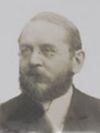
|
Hermann Esser - (1845-1908). Hoboken, New Jersey, United States. Hermann Esser
and Wilhelm J. D. Keuffel were partners in the firm of Keuffel & Esser which was founded in July 1867.
The firm was incorporated in New Jersey in February 1889 and became Keuffel & Esser Company.
They first manufactured surveying instruments in 1885. Hermann was born at Wuppertal-Elberfeld, Germany in 1845.
He retired from Keuffel & Esser Co. in 1902. He was back in Bad Godesberg am Rheim, Germany in April of 1902
and died there in April 1908, the same year as Wilhelm Keuffel.
|

|
Walter Richard Evans - (1920-1999), Inventor, Author. Evans was a noted American control theorist and the inventor of the root locus method in 1948. He received his B.E. in Electrical Engineering from Washington University in St. Louis in 1941 and his M.E. in Electrical Engineering from the University of California, Los Angeles in 1951. Evans worked as an engineer at several companies, including General Electric, Rockwell International, and Ford Aeronautic Company. He was the recipient of the 1987 American Society of Mechanical Engineers Rufus Oldenburger Medal and the 1988 AACC's Richard E. Bellman Control Heritage Award electrical engineer who developed the "Root-Locus Method" for designing automatic control systems. He then invented the Spirule to help "nail down specific points on the locus - to establish the gain to use and the exact natural frequency and damping that will result". This device was manufactured by Evans's company in the 60's, and 100,000 of them were actually shipped before personal computers took over. He wrote "Control System Dynamics" published by McGraw Hill in
1954. Source, wikipedia and Nathan Zeldes, History of Computing
|

|
Artur Ewert - (? - ?) Germany (GDR). An engineer working for the Reiss company in Leipzig, and
designed the Reiss Duplex 3227 slide rule (1965). He wrote a book "Modernes Stabrechnen" (modern use of the slide rule)
which was published in Leipzig in 1969.
|
Top
A
B
C
D
E
F
G
H
I
J
K
L
M
N
O
P
Q
R
S
T
U
V
W
X
Y
Z

|
Anton Wilhelm Faber - (1758-1810) The second generation of the company, Faber-Castell, was known as A.W. after Kaspar's son Anton Wilhelm who took over in 1784. The little family firm flourished; Anton Wilhelm was able to buy land and increase the rate of production. This was a phase of expansion. Picture donated by A.W. Faber-castell Co. (copyrighted)
|

|
Georg Leonhard Faber - (1788-1839) Georg Leonhard Faber headed the pencil factory, of what is now faber-Castell, from 1810. These were very difficult times, politically and economically, and he was unable to prevent business from falling off. Picture donated by A.W. Faber-castell Co. (copyrighted)
|

|
Kaspar Faber - (1730_1784) Original founder of what is now Faber-Castell. The cabinet-maker Kaspar Faber produced his own pencils in Stein and sold them in the market at Nuremberg from 1761. This date is considered to be the founding of the company.
|
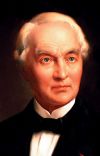
|
Lothar von Faber - (1817-1896) Following the death of his father Georg in 1839, Lothar Faber took over the pencil factory of A.W. Faber in Stein at the age of 22. After gaining experience by working for stationers in Paris and London, the major international trading centres of the day, he began to put the family business on quite a new footing. It was he who developed the modern quality pencil, defined standards for length and grades of hardness that still apply, and was also the first to make hexagonal pencils. He marked his pencils with the name A.W. Faber - and so the world's first branded writing implement was born.
Lothar traveled to all important European countries and visited the New World, founding his first sales company in New York in 1849. There followed subsidiaries in London (1851) and Paris (1855) and agencies in Vienna (1872) and St. Petersburg (1874). By acquiring a graphite mine in Siberia in 1856, he secured the company a source of the best graphite then available. Five years later he celebrated the centenary by opening a factory in Geroldsgrun in north Bavaria. This originally made school slates but later became one of the world's major producers of slide rules.
Picture donated by A.W. Faber-castell Co. (copyrighted)
|

|
Baroness Otillie von Faber - (1877-1944) In 1898 Wilhelm von Faber's eldest daughter and designated heir Ottilie von Faber married Count Alexander Alexander zu Castell-Rudenhausen, a member of one of Germany's oldest noble families. Her grandfather Lothar had stipulated in his will that all his successors must bear the name Faber. And so the new company name Faber-Castell came about. Count Alexander took over the business in 1900.
Picture donated by A.W. Faber-castell Co. (copyrighted)
|

|
Wilhelm von Faber - (1851-1893) Son of Lothar von Faber, his only child, Wilhelm entered the company A.W. Faber in 1873 and was designated successor in 1877. He lost his two sons Lothar and Alfred Wilhelm at the ages of three and four. Wilhelm, a sensitive and artistically inclined person, suffered greatly from this loss and himself died tragically young at the age of just 42. He left a widow, Bertha, and three daughters: Ottilie, Sophie, and Hedwig. His elderly father Lothar again had to take over control until his own death in 1896. Then the A.W. Faber company was run by Lothar's widow Ottilie until the turn of the century.
Picture donated by A.W. Faber-castell Co. (copyrighted)
|

|
Count Alexander von Faber-Castell - (1866-1928) In 1898 Count Alexander Alexander zu Castell-Rudenhausen, a member of one of Germany's oldest noble families married Wilhelm von Faber's eldest daughter and designated heir Ottilie von Faber. Her grandfather Lothar had stipulated in his will that all his successors must bear the name Faber. And so the new company name Faber-Castell came about. Count Alexander took over the business in 1900.
In 1905 Count Alexander introduced the famous green Castell 9000 pencil. As a symbol to a new high quality that would hold its own against all comers, he chose the picture of the 'jousting knights' of the pencil. In stylized form they are again part of the Faber-Castell trademark.
Picture donated by A.W. Faber-castell Co. (copyrighted)
|

|
Count Anton Wolfgang von Faber-Castell - (1941-2016) Current President of Faber-Castell.
Count Anton Wolfgang von Faber-Castell took over in 1978, and the same year began producing
wood-cased pencils for the cosmetic industry. The next two decades saw the founding of a series of foreign subsidiaries and factories, including Malaysia (1978), which has since become the world's largest india-rubber eraser
factory (1980), a production plant in Indonesia (1990), and a logistics centre in the
Czech Republic (1996). Picture donated by A.W. Faber-castell Co. (copyrighted)
|

|
Count Roland von Faber-Castell - (1905_1978) After the death of Count Alexander in 1928, his son Roland succeeded as head of the company. In 1931/32 Faber-Castell took over the Johann Faber pencil factory that had been founded by Lothar von Faber's brother Johann, and with it the Brazilian subsidiary Lapis Johann Faber in Sao Carlos.
It was under Roland's watch that all slide rule and calculator manufacturing ceased in 1976. Picture donated by A.W. Faber-castell Co. (copyrighted)
|

|
Jorge Fábregas Zazza - Spain. Collector. Electronics engineer. Jorge founded his popular and extensive Spanish slide rule
site and forum reglasdecalculo.com and in 2008 he created the ARC Association
Amigos de las Reglas de Cálculo Foro, (Slide Rule Friends Forum) a Spanish
Speaking Slide Rule Forum and collector group which gathers together frequently. Jorge Fáberegas is Spain's counterpart to ISRM and its members are contributors to the ISRM galleries.
|
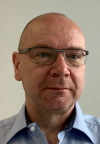
|
Andreas Fassbender - Germany. Collector. Contributor to ISRM. Mechanical engineer. Currently working in the product management of a grease manufacturer. His passion for collecting slide rules began in 2019 with a No 20 "Kiel" and instructions from Albert Nestler, which he found in his father's estate.
|

|
Wayne E. Feely, PhD - (1931-2011) Rydal, Pennsylvania. Collector. Member of the Oughtred Society and
contributor to the JOS. Wayne was born and raised in Brooklyn,
New York where he graduated from high school. He was a graduate of
the Polytechnic Institute of New York University in Brooklyn and received his doctorate in chemistry
from the University of Rochester in 1957. He served in the United States Army, being honorably discharged in 1962
after reaching the rank of First Lieutenant in the Chemical Corps. Wayne worked for 36 years as a research
chemist for Rohm and Haas, a multi-national chemicals manufacturing company in Pennsylvania, until his
retirement in the early 1990's. He accumulated 21 U.S. Patents during his career. Wayne is best known amongst slide rule
collectors for his expertise on Fuller and Thacher cylindical slide rules.
Wayne outlived his wife Jeanette, They had 3 children, Bennett, Susan and Janet and two step-sons
Chuck and Chris, and at his death at age 79, eight grandchildren.
|

|
Gabriel Felsenthal - (1856-1925) Original founder of G.Felsenthal & Sons, which created a novelty company. The sons, in the name, obtained US Government contracts, during WWII, to build plastic Dalton Dead Reckoning Computers and other slide rule related products. They made the bulk, aproximately 70% of all Aviation slide rules used in WWII. The family evolved the company into Felsenthal Plastics. It ended in 1977. More at Made in Chicago Museum
|

|
Lester And Irving Felsenthal - Lester Felsenthal (1886-1948) And Irving Felsenthal (1888-1956) were the second generation sons of G.Felsenthal & Sons, founded by Gabriel (Gabe) Felsenthal (1856-1925), which created a novelty company. When WWII arrived the sons obtained US Government contracts to build plastic Dalton Dead Reckoning Computers and other slide rule related products. They made the bulk, aproximately 70% of all Aviation slide rules used in WWII. The family evolved the company into Felsenthal Plastics. It ended in 1977. More at Made in Chicago Museum
|

|
José Gabriel Fernández-Bañares - (1963- ) Santa Creus, Spain.
Collector. Member of the Amigos
de las Reglas de Cálculo (ARC). Friend of the ISRM. Has translated many slide rule documents
from Spanish and French to English, for the UKSRC and Journal of the Oughtred Society. Contributor to several IMs.
Jose received an electronics engineering degree in 1990 and started working in electronic products
development for the fire detection and alarm market. In 2000 he joined an American company Tier 1
in the automotive electronics market. His father bought him his first 'antique' slide rule at a flea market,
while Jose was attending the university. Jose writes "In those days I found very little information on slide
rules, even looking in the library at my university. I had to wait until the Internet was global to access
www.reglasdecalculo.com, E-Bay and specialized websites from other countries like UK, Germany and USA, including ISRM."
See his expanded JGF biography (PDF).
and his list of JGF original articles and translations (PDF).
|
|
|
Elmer Irving Fiesenheiser - (1906-1998) - Professor of Engineering, Illinois Institure of Technology. Principle author of the 1951 Post Versalog manual.
Co-authors R.A. Budenholzer and B.A,Fisher. He was born in South Bend, Indiana. studied civil engineering at Purdue University in West Lafayette after
graduating from high school , graduating in 1930 with honors for a Bachelor of Science , 1945 he received his Degree in Civil Engineering. In 1946
Fiesenheiser earned a Master of Science degree from the Illinois Institute of Technology in Chicago . He became a full-time instructor in
Mechanics in 1943, and promoted to professor of civil engineering.in 1951. In 1953 Elmer I. Fiesenheiser was appointed director of the civil engineering
department at IIT. He was one of the foremost United States civil and structural engineers of his day.
|

|
Robert (Bob) Finch - Albuquerque, NM. Collector. Member of the Oughtred Society.
Broadcast/Studio engineer. Collection is focused on whatever intrigues Bob, like electrical and
Vector/Log. Picketts are his favorite.
|

|
Anne Fisher (Mrs. Thomas Slack) - (1719 - 1778) Newcastle, England.
An English author and grammarian. A New Grammar, which appeared in 1745, made her the
earliest published female author on modern English grammar, Author of several elementary educational
works and wife of a Newcastle printer Thomas Slack (1723-1784) who was himself the author of several books
of mathematical character. Florian Cajori wrote in 1908 "The Arithmetic of George
Fisher, which is a pseudonym for Mrs. Slack, probably the first woman who
is the author of a popular arithmetic, contained rules for the use of the slide
rule. Her books were read in the United States."
|

|
Gary Flom, M.D. - Stockbridge, GA. Collector. Fellow of the Oughtred Society.
Active on of ISRG. Ear, nose and throat Doctor and head and neck surgeon. Recieved his
Bachelor of Mathematics from the University of Minnesota Institute of Technology, then
attended Chicago Medical School followed by post graduate studies at Mayo Clinic,
Rochester, MN and St Louis Univ. Gary has a wide range of collecting interests including
mechanical calculators. His favorite slide rules are pocket duplexes, pinwheel
calculators and abaci. Coordinator of the Swap Sheet Online, source of many new
ideas for Society projects and activities (including the new winter meeting in Las Vegas).
|

|
Foo Cheow Ming - Yishun New Town, Singapore. Collector. Originally a Civil Servant
and is now in practice as a private lawyer. Discovered
large caches of new-in-box old stock slide rules (over 20,000, mostly Hemmi, Faber-Castell, Aristo, and Flying Fish/Shanghai brands) in Singapore and Malaysia bookstores in 1997, which were gathered up and sold by Walter Shawlee. See this
web page on his finds. Contributor of scans to ISRM.
Foo writes: My first slide rule was a Staedtler-Mars 544DLL, a little beauty clad in a brilliant blue/white plastic casing. I first bought it in the early
seventies and kept it for the next 20+ years. But even after the advent of cheap calculators, I found my love for slide rules undiminished. I guess people
still love slide rules for the very same reason classic cars or antiques are so loved. In many ways they are reminders of a kinder, slower, more genteel past.
They are like the sceptres of the high priesthood of science and engineering. " His personal collection numbers around 300 slide rules.
|

|
John Fowler - (1721 - 1751 ) The Globe, Swithin (Sweetings) Alley, by the Royal Exchange, London.
Made Gaugers slide rules
|

|
Harold Fowler - (1879 - ? ) Son of William H. Fowler, participated in the development of Fowler's circular 'pocket watch' calculators. He was acknowledged in by his father in a Fowler's Universal Calculator manual: "To my son Harold Fowler, Wk Ex., A.M.I., Mech E., Whose co-operation through 25 years has contributed greatly to the succesful evolution of Acurrate Circular Calculators.".
|

|
William Henry Fowler - (1853 - 1932 ) Whit.Sch.,M.Inst.C.E,M.I.Mech.E., etc. Established the Fowler & Co.
in 1898 on Hampson Street, Manchester, England. Fowler made over fifty variations of circular 'pocket watch' calculators
with logarithmic slide rule scales. They continued manufacturing up to 1988.
See Fowler history Timeline
|

|
Peter Fox - Upperton Bonsail, Derbyshire, England. Collector. Member of UKSRC. Contributor of rare British slide rules scans for the ISRM galleries. Became a structural engineer in 1975, used a Faber Castell 1/92 and a 52/82 until the advent of electronic calculators. Worked at Imperial Chemical Industries (I.C.I.) beginning in 1976, then for British Coal Coking Division in 1981 heading up the Civil Engineering Design Office. Following the miners strike and the collapse of the British Coal Industry in 1984, Peter set up as a consultant. retired in 2008.
Collecting slide rules began when his father, an antiques dealer, gave an Everard Rule by Edward Roberts and now he concentrates on boxwood rules. Peter also enjoys astronomy and classic sports cars.
|

|
Dr. Paul W. Frame - Oakridge, Tennessee. Author/Curator of Oak Ridge Associated Universities On-Line Museum.
The purpose of the Oak Ridge Associated Universities (ORAU) Health Physics Historical Instrumentation Museum Collection is to chronicle
the scientific and commercial history of radioactivity and radiation. The Nuclear Slide Rules
is the most complete collection in the world and is the property of the not-for-profit ORAU Foundation.
It is located at theProfessional Training Programs (PTP) training facility in Oak Ridge, Tennessee.
|

|
Michael (Mike) Frey - New Hampshire. Collector. Retired. Nuclear Magnetic Resonance.
His website Freystuff.com
|
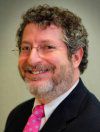
|
Dr. Sam Friedman - Columbia, S.C. Collector, Member of Oughtred Society. Radiologist with
specialization in Nuclear Medicine. He first became interested in slide rules at age 13, as part of
a Mathematics class unit in historical technology. After receiving a Bachelor's of Science Degree in Electrical Engineering at Rice University
in Houston, TX, Sam went on to receive his M.D. from Baylor College of Medicine, also in Houston, and
then completed a Radiology Residency and Nuclear Medicine Fellowship at UAB in Birmingham, AL. He
has been in private practice in Columbia, S.C. ever since. Sam began collecting slide rules in earnest
several years ago, and has concentrated on large, classroom-sized rules, which now completely cover
most open wall-space in his home office.
|

|
Sergei Frolov - Russia. Collector of Soviet Era slide rules.
|

|
Harold J. Frost - Hanover, New Hampshire. Collector. Educator. Teaches Materials Science, Mechanics and
Thermodynamics at Dartmouth College, Thayer School of Engineering, since 1981. His primary collection is planimeters
and Integrators.
|

|
Fuller, George, M. Inst. C.E. - (???? - ????) Ireland. Professor of (Civil) Engineering at the
Queen's College (now University of) Belfast in Northern Ireland. who designed the Fuller cylindrical
slide rule with spiral scales in 1878. It was patented as an "Improvement in Calculators" in 1879.
Its remarkable length permitted a high level of precision in calculations; calculations could be
made to 4 or 5 significant digits. The principal manufacturer of these slide rules was W. F. Stanley Hall
of London, who possessed the necessary dividing engine for such an undertaking. It was
marketed by Keuffel and Esser Co. in New York from 1895 to 1927. Stanley continued its production until 1972,
as until the introduction of the electronic calculator, it was preferred by astronomers and scientists.
|
Top
A
B
C
D
E
F
G
H
I
J
K
L
M
N
O
P
Q
R
S
T
U
V
W
X
Y
Z

|
João Roberto Gabbardo - Brazil. Collector and contributor of Brazilian SR scans to ISRM.
Professor at Escola Técnica Estadual Parobé State Technical School Parobé
Education Management industry.
|

|
C. de Galan - Netherlands. Author. He wrote "Hoe Werk Ik Met De Rekenliniaal?" (How do you Work with the Slide Rule?) in 1942 and was a popular textbook in Dutch schools. It was also translated into Indonesian "Bagaimanakah Kita Bekerdja dengan Mistar-Hitung dan dengan Tjakera-Hitung?" in 1950..
|

|
Darrell L. Geiger - (b.?-d.?) United States. Engineer, Auther. Senior Project Direct at the Cleveland Institute of Electronics.
Geiger wrote about a dozen instructional booklets on electronics and elementary mathematics in the 1950s and 1960s.
His patent "Slide Rule" (U.S. Patent 3,120,342 issued February 4, 1964) became the Pickett N515-T Electronic Slide Rule.
and is featured in the Electronics and Your Slide Rule" home-study correspondance course for CEI. He also wrote the book
Successful Preperation for FCC License Examinations (Prentice-Hall).
|

|
H. Joseph Gerber - (1924-1996) United States. Inventor/businessman. Gerber, a holocaust survivor, immigrated to Hartford, Conn., from Austria in 1940, and completed high school in two years while working full time.
1947 graduate from Rensselaer Polytechnic Institute. Gerber's first patented invention was the Gerber Variable Scale, which he conceived in 1945 while he was a college student. He built the product in his garage. Leaving his job a few years after graduating, he drove around America for months at a time to visit engineering departments of military and industrial organizations. He sold his existing products by day, and invented new ones at night. It was the first product to launch the Gerber Scientific Instrument Co. Gerber, who held nearly 650 patents, was awarded the National Medal of Technology in 1994, given to him by U.S. President Bill Clinton. Several of his inventions are on display at the Smithsonian Institution.
The story behind his invention The Inventor's Dilemma: The Remarkable Life of H. Joseph Gerber was written by his son, David J. Gerber. (Yale University Press, 2015)
|

|
Werner Girbardt - Greifswald, Germany. Member of Ougtred Society. Shares the 2009 OS
Award with Werner Schmidt for organising four international science and technology symposia at the Ernst Moritz Arndt University in
Greifswald, for setting up the
Rechentechnische Sammlung museum collection which includes an information rich on-line catalogue of the slide rules and other calculating instruments from the collection.
|

|
Herbert (Herb) Gold - Silverlake (Los Angeles), Ca.
Collector and member of Oughtred Society. Retired from Computer Project Management.
Collects all slide rules and mechanical calculators.
|

|
Louis Gotlib - West Chester, PA. Teacher. Member of the Oughtred Society.
Louis Gotlib is a native of Bangor, Maine. By the time he got to chemistry and physics
in high school slide rules were
out of favor and it wasn't until decades later that he picked a few up, started playing
with them, and began collecting. A graduate of The Johns Hopkins
University and the University of North Carolina at Chapel Hill,
Louis has been teaching chemistry for over 28 years and his collection of 1500 rules features many slide
rules and slide charts related to chemistry. He is the coauthor of a number of study guides
for standardized tests such as the GED, CLEP and MCAT. Louis has helped with hosting
past East Coast Meetings of the Society.
|

|
Gottheimer, Abel and Ethel R. - New York. Manufacturer. Abel
(1891-1979 - died Nassau, NY) and Ethel (?-1979) Gottheimer founded the Roos Company of 280 Madison Ave., New York, in a partnership
with Andre and Angele Charvoz, circa 1941, manufacturing
painted wood and laminated wood slide rules, presumably to fill the void caused
by import restrictions during WWII. A reasonable assumption was that Gottheimer
manufactured the slide rules and Charvoz handled marketing, as by 1945, The Roos
Company was distributing "Charvos" [sic] drawing instruments manufactured by
Andre Charvoz, under Charvoz, Inc. The Roos Company and Charvoz Inc. were merged
into Charvoz-Roos Corporation in 1946.
|

|
Alex E.S. Green - (1920-2014) - Professor Emeritus Univeristy of Florida. Fellow of the Oughtred Society. Before joining the UF faculty, Green had been a gunnery evaluation specialist and an operations analyst for the Army Air Force during World War II. He had developed specialized slide rules to solve technical issues faced by B-29 bombing raids, leading to his participation in one of the most dangerous B-29 missions that found the missing Japanese fleet, including the battleship Yamato. He remained an enthusiast of slide rules, making numerous presentations to various audiences around the world, and was a long-time member of the Oughtred Society. .Green became a graduate research professor at UF in 1963, where he headed the Interdisciplinary Center for Aeronomy and Atmospheric Sciences. Green's career encompassed 17 books, over 400 publications, and numerous patents and awards.
|

|
Edmund Gunter - London, England (1581 - 1626), Created a number line (the Gunter Scale) in 1620, in which the positions of numbers were proportional to their logs which graphically represented the work of John Napier. In 1623 he published a description of this scale that is composed of two scales of the logarithms from I to 10 placed end to end. Although Napier conceived of the logarithm allowing multiplication or division to be accomplished by addition or subtraction, Napier relied on look up tables.
|
Top
A
B
C
D
E
F
G
H
I
J
K
L
M
N
O
P
Q
R
S
T
U
V
W
X
Y
Z

|
Danforth (Danny) W. Hagler - Inventor/Executive. In 1960, Danforth W. Hagler, who's
family ran Georgia Iron Works, Grovetown, Ga., conceived and designed the GIW Hydraulic Slide
Rule. His brother Tom, wrote the manual. Before its invention, each engineer in the engineering
department had a large, thick notebook with about 100 pages of graphs. The slide rule incorporated
many hydraulic pump and pipeline formulas. One side of the slide rule contained engineering
formulas involved with performance of a pump while the other side contained everything necessary
for pipeline and production calculations.
|

|
Chris Hakkaart - Netherlands. Chairman of the Dutch Circle
for Historical Calculating Instruments (KRING).
|

|
Joseph Halden - Manchester, England. Founder of J. Halden & Co. Maker of
drawing and Surveying Instruments. In the 1870's he worked as a stationer at Gleave Street in Liverpool.
Partnered with A.G. Thornton in 1878 as a wholesale drawing material importer and mounting paper
manufacturer. After a few years they split apart. He retired in 1892 and the company was taken over by his son.
Joseph had two patents which wer e issued around 1900. The company considered its
Calculex circular calculator to be about the cheapest and most
serviceable model available.
|

|
John Lionel Halden - ( - 1966) Manchester, England. Grandson of Joseph Halden. Became technical director of
J. Halden & Co. Maker in 1941 and held that position for 24 years.. He took an active part in research and development and
patented photographic ammonia developing apparatus. Under his guidance, the company continued to
prosper. The works were extended in the 1960s to provide an enlarged engineering
department for the manufacture of photocopying machines and a warehouse for drawing
office supplies. J. L. Halden died in August 1965 at the age of 49. He had recently been appointed
chairman of the company. The firm continued until it was taken over by the Ozalid Group at the beginning of 1969.
|

|
Prof. Dr. Christian (Chris) M Hamann - Berlin, Germany. Member of RST. Professor at Beuth University of Technology, Berlin. Practice Areas: Former head of the Laboratory for Artificial Intelligence, Application of expert
systems, Evolution strategies and genetic algorithms, Simulation of Neural Networks, Positional Logical
Algebra, Fuzzy logic.
Website
|
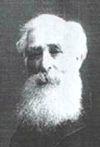
|
John Caulfield Hannyngton, Major General - (1807-1886) Tyrone,UK. Inventor of the Hannyngton Slide
Rule used in astronomical computations. Son of Thomas Knox Hannyngton of Dungannon
and father of John Child Hannyngton. Fellow of the Institute of Actuaries. His best known and largest work
is a Table of Haversines, Natural and Logarithmic, used in computing distances for the
Nautical Almanac. Image from the
South Kensington Science Museum
|

|
Mort Hans - Collector. Member of the Oughtred Society. Contributor to the Journal of the Oughtred Society. He has a B.Sc. in Physics and a M.Sc. in Operations Research. From 1959 to 1982, he worked primarily in the maritime field. His projects included, the Trieste bathyscaphe, NR-1 nuclear research submarine, vessel traffic systems for the Port of Rotterdam, the Suez Canal and the Straits of Malacca, the Coast Guard's National Data Buoy Project and submarine and ship simulators for the Navy and the U.S. Merchant Marine Academy. Earlier, he carried out computer studies of fighter ejection seat mechanisms, aircraft carrier arresting cable systems and airport take-off and landing traffic sequencing concepts for the FAA.
From 1982 to 1996, he was involved in information and telecommunications technology applications for the municipal bond industry.
Since 2000 he has been a volunteer in the flight simulation group of the Cradle of Aviation Museum. His amateur radio call, W2OTS, dates from March,1946.
EDN Slideshow - Slide Rules and charts
|

|
Prof. Maurice Leslie Hartung - (1902-1993) United States. . Studied Mathematics at Cornell College, Iowa, and in
September 1926 was accepted as a member of the American Mathematical Society. He received his PhD in 1931 from the University of Wisconsin
for his thesis "On a Family of Integral Equations with Discontinuous Kernels". He joined the University of Chicago School of Education as associate
professor, then was appointed Professor of Mathematics and Education. He was the primary author of the widely used New Math textbook series,
"Seeing Through Arithmetic", published by Scott Foresman. In 1977 he received the Distinguished Life Achievement Award of the Illinois Council of
Teachers of Mathematics. Prof Hartung wrote most of the manuals for Pickett slide rules and may have been the inventor of the DFM and DF/M scales.
In retirement he contributed to professional journals and worked on logic and geometric puzzle games.
|

|
Wayne Harrison - Mississauga, Ontario, Canada. Retired, collector of Slide rules, abaci, and mechanical calculators. Member of Oughtred Society, and the UKSRC. Wayne also makes replica scales for cylindrical and other rare slide rules. A couple of these appear in the ISRM archives. More can be found on his site: Wayne Harrison's Slide Rules
|

|
Thomas Heath - (18thC(early) - 18thC(late)) United Kingdom. Maker (1721-1747) of "Mathematical Instruments Contrived & Made in Metal, Ivory or Wood According to the Latest Observations of Philosophers and Practitioners of Mathematical Sets at the Hercules next the Fountain in ye Strand, London". (from British Museum)
|

|
David Hecht - Alexandria, VA. Collector. Member of the Oughtred Society.
Donor of slide rules to ISRM and its SR Loaner Program. David's first
SR was a circular Pickett 101-C, which he acquired in high school. His
interest led his parents to give him a K&E 68-1210 as a graduation
gift. After college, David worked fifteen years for the U.S. Navy as a contracting
officer and is now retired from Civil Service. His slide rule collection specializes in Picketts
and he enjoys traveling to board game conventions.
|

|
Stefan Heimann - Berlin, Germany. Member of Oughtred Society. Professor of Hydraulic Engineering for Civil and Environmental Engineers. Beuth Hochschule für Technik Berlin. Enjoys Collecting slide rules for hydrology.
|

|
Robert Anson Heinlein - (1907-1980) Prolific author of science fiction books about space travel
that inspired many of us. His books were strewn with mentions of slide rules, used in plotting courses through
space as well as engineering applications. His personal slide rule was most likely a K&E 4081 as the 20 inch
long version was specifically mentioned in Have Space Suit Will Travel and as a Navy midshipmen,
graduating with a bachelor's degree in Naval Engineering from the Naval Academy in Annapolis, he was probably
issued a K&E there as well. Science Fiction Writers of America made him the first 'Grand Master of Science
Fiction' in 1975.
|

|
Jiro Hemmi - (1878-1953)
Jiro Hemmi is the father of Hemmi slide rules. He was born in Tokyo and graduated in 1890 from
primary school in Chiba Prefecture. At the age of 13 he became
artisan in Nakamura measuring instrument workshop where he started making scales. He started to
study slide rule fabrication at age 17 (1895). After many tries, Jiro Hemmi made his first slide rule
using Moso bamboo plywood, a species of bamboo found mainly in Japan.He got passionate about his
work, and when he was asked to make copies of a Mannheim slide rule, he was already the best
scale maker of his time in Japan.
In 1912, Jiro obtained a patent for the method to make slide rule with no defect using treated moso bamboo,
followed by patents in England and France (1917), and in the United States, China and Canada in 1920.
In 1917 the SUN mark is established as the Hemmi trademark. Being the symbol of Japan itself,
A fire badly damaged the wooden house used by Jiro Hemmi as a shop and workshop in Sarugaku district in
Tokyo in 1924. Hisashi Okura, an expert in international trade, visited Jiro Hemmi, who was in a difficult situation because of the fire,
and offered to participate in the business management. They founded the Hemmi Workshop as a partnership company in 1928.
They worked together to differentiate Japanese slide rules from those built in the US and Germany.
In 1933 Hemmi Worksop became a limited company. During the Second World War, Hemmi made slide rules used
for battleship artillery calculations and to design the battleship Yamato.
Jiro retired from Hemmi Slide Rule in 1941 for health reasons.
|
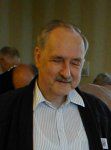
|
Herman van Herwijnen - (1929-2004) Dutch slide rule collector and author of the
Slide Rule Catalogue© and co-author of Calculating on Slide Rule and Disc with IJzebrand
Schuitema. Married to Diny van Herwijnen. Member of the Dutch Circle of Slide Rule
Collectors Graduated with Mechanical Engineering degree from Technical University
Delft in 1954. Spent two years in the Dutch Air Force followed by 13 years woking in
Venezuala for Dutch Royal Shell. Had his own firm, Infro Software, and lectured at
Shell and Technical University Delft up until his death. Herman last attended the
IM 2003 Swap Meet. Oughtred Society Award 2003.
|

|
Curt Herzstark - (1902-1988) Designed the CURTA Calculator in the 1930s in Vienna, Austria. By 1938,
he had filed a key patent, covering his complemented stepped drum, Deutsches Reichspatent (German Empire Patent)
No. 747073. His work on the pocket calculator stopped in 1938 when the Nazis forced him and his company to concentrate on
manufacturing measuring instruments and distance gauges for the German army.
Herzstark, the son of a Catholic mother but Jewish father, was taken into custody in 1943, eventually finding
himself at the Buchenwald concentration camp. Ironically, it was in the concentration camp that he was encouraged
to continue his earlier research which saved his life.
The Russians had arrived in July, and Herzstark feared being sent to Russia, so, later that same month,
he fled to Austria. He began to look for financial backers, at the same time filing continuing patents
as well as several additional patents to protect his work. The Prince of Liechtenstein eventually showed
interest in the manufacture of the device, and soon a newly-formed company, Contina AG Mauren,
(aka Contina Ltd Mauren) began production in Liechtenstein.
His patent rights provided a modest income while CURTAs were being manufactured.
|

|
John B. Heywood - United States, Professor of Mechanical Engineering, MIT. Sc. D. Cambridge, Doctor of Technology, Gotenberg Univ,.Fellow of the American Society of Mechanical Engineers, U.K. Institution of Mechanical Engineers, Society of Automotive Engineers. Has a collection of 40 slide rules dated from 1785-1960. His father Harold heywoood collected old scientific instruments in the mid-1940's. His father's collection went to the Whipple Museum of Scientific Instruments in Cambridge, UK. Dr. Heywood's Research Interests
Energy and transportation interface, Internal combustion engines, Transportation fuels. Co-Author 5 books and wrote 220 papers. 1995-2015, 33 patents related to engines and fuels.
|

|
Masatoshi Hiroshi - Japan, circa 1912. Inventor of the bamboo slide rule
and recieved a Japanese Patent
|

|
Russel D. (Ace) Hoffman - United States. Oughtred Society webmaster (2018-present), Owner, programmer and animator for The Animated Software Company. Technologist with nearly three decades of computer programming experience. Writer, environmentalist and lecturer. His software is used in a couple of thousand universities in over 100 countries, and many thousands of other places, such as pump manufacturers, law offices, hospitals, several military forces around the world, and countless homes and schools.
|

|
Peter Holland - Germany. Collector. Oughtred Society Award 2010. Member and webmaster of the
GermanRechenschieber
Sammler Treff (RST). Fellow of the Oughtred Society. Hosts the ISRM Slide
Rule Loaner Program in Europe.
|

|
Flemming Holme - Vonge, Denmark. Recent owner of UTO, a Danish company, founded by
Kal Kruuse and Poel Larsen that made slide rules
and continues to make modern slide charts.
|

|
Peter M. Hopp - UK. Collector/Author. C.Eng. MBCS. Fellow of the Oughtred Society.
Member of UKSRC and co-editor the Slide Rule Gazette. Oughtred Society Award 1999. Wrote the
reference book on slide rules
Slide Rules Their History, Models and Makers.
|

|
Mr. Huang - San Diego, California. Collector. He obtained a B.S. degree in Physics
from Taiwan's National Tsing Hua University in 1971. Not only did he take German language classes
along with his native Chinese, but he also became fluent in English, coming to the United States
in the 1970's. He graduated with a Masters of Science degree in Physics from the University of
Utah. His love for computation has encouraged him to build a collection of slide rules, HP and
TI calculators, as well as abacuses. ISRM was the recipient of his collection and many specimens
may be seen in ISRM galleries. His daughter, is a Civil Engineer in Tempe, Arizona.
|

|
Richard Smith Hughes - Ridgecrest, California. Collector. Fellow of the Oughtred Society. Member of UKSRC. Retired Electrical (analog) engineer. Prolific author of technical slide rule articles and researcher of antique Egyptian coffins. Appreciates unique general purpose slide rules, favorites being
the RotaRule, FC Statifix, 2/84, 2/84N, and hyperbolic.
|

|
Ted Hume - San Angelo, TX, USA. Oughtred Society Award 2010. Fellow of the Oughtred Society and past OS director.
Retired structural engineer. In the past, when actively collecting and selling,
Ted specialized in Post slide rules, his favorite being the Versalog.
Co-author, Post Slide rule Archive
hosted on the Slide Rule Universe website. Editor and contributing author of the The Oughtred Society
Slide Rule Reference Manual. Editor of Joe Soper's book K&E Salisbury Products
Division Slide Rules. In late 2009, Ted became an associate editor of the
Journal of the Oughtred Society (JOS). Advisor to the curator at ISRM.
|
Top
A
B
C
D
E
F
G
H
I
J
K
L
M
N
O
P
Q
R
S
T
U
V
W
X
Y
Z
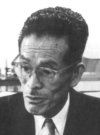
|
Kiyoshi Ichimura - Japan ( 1900-1968). Founder of Ricoh Co., Ltd. Born the son of a poor farmer
in the Saga Prefecture Miyaki, went to Chuo University (law department) 1920, became director of the
Daito Bank in Beijing, China, returned to Japan. Riken Kankoshi Co., Ltd., formed in 1936 to make and market
sensitized paper which became Riken Optical Co. in 1938.in 1946 Ichimura was appointed president (until his death in 1968).
Ichimura's first major innovation was the RicohFlex III camera. Introduced in 1950, this was the world's first
mass-produced twin-lens reflex camera (1957). The company expanded into copiers and watches, as well as slide rules.
|

|
Wolfgang J. Irler - Italy. Collector of slide rules and mechanical calculators.
Vimeo blog
|
Top
A
B
C
D
E
F
G
H
I
J
K
L
M
N
O
P
Q
R
S
T
U
V
W
X
Y
Z

|
Robert (Rob) A. James - Piedmont, California. Collector, Member of the Oughtred Society. Partner in the law firm Pillsbury Winthrop Shaw Pittman LLP. where his work focuses on energy project development and acquisitions. Author of "The Deaths of the Slide Rule" (JOS 2014), "Humanity and the Big Dipper: A History of Our Species in Relation to Seven Stars" (Amazon/Kindle Books 2020) and "Future Reckoning: Calculating Devices in the Golden Age of Science" Fiction" (forthcoming). Interests include the International Geophysical Year 1957-1958 (IGY) and the history of the slide rule industry. Favorite rule the Faber-Castell 12.5 cm 62/83N. His honors and awards include The Legal 500 U.S., Project Finance (2016-2020) and Construction (2013, 2019); Chambers Global, Projects, USA (2012-2013), Energy: Oil & Gas (Transactional), USA (2007-2011)
|

|
Marten C. Jensen - Redlands, California, USA.
Donor of personal SR's and others in his collection to ISRM.
Born in New York City in 1932, he fought in the Korean Conflict Veteran (U.S. Air Force)
after High School. 1958 BS degree in Electrical Engineering New Mexico State University.
Marty used the Pickett 4-T (in the gallery) quite extensively during college with the
Pickett 800-T as a backup. He remembers carrying the Pickett 120 or the Aristo 89 Reitz
pocket rules in his breast pocket at his first few jobs out of school. His first position
out of college was with El Paso Natural Gas Company as a power engineer used the T&T Motor
Calculator (which was issued to him by the company) for laying out lighting and electric
motor circuits at natural gas pumping and processing stations. Marty was then given a small
Concise circular calculator when he was employed at GE Defense Systems in Syracuse, NY.
The rest of the SR's he owned (now in the galleries at ISRM) were used during his 20
years at Motorola Semiconductor in Phoenix, AZ, where he was employed as a reliability
engineer. His last job was at TRW Systems Integration Group (in San Bernardino, CA), where he was
responsible for overseeing the work of guided missile contractors and parts suppliers,
and used only computers and electronic calculators. Marty has been retired since 1998.
|

|
Dieter von Jezierski - (1927-2013) Stein, Germany. Collector/Author. Fellow of the Oughtred Society. Honorary member of UKSRC. Oughtred Society Award 1997. Expert on Faber-Castell slide rules; retired
long time employee of Faber-Castell; frequent attendee of the Society?s west coast
meeting. In 1977 wrote and published Slide Rules: A Journey Through Three
Centuries, the first modern book on the history of slide rules. Author of more than 30 articles in JOS, Gazette, Skid Stick and RST1997. recipient
of the Oughtred Society Hall of Fame. Picture is from an IM 2001 meeting in Munich. Dieter died at the age of 86.
|

|
Paul Lee Jones, Jr. - (1896-1945) Manufacturer. Founder of The Festus Mfg. Co. in Festus, Missouri in 1938,
which later became the Acu-Rule Mfg. Co. and later, Acu-Math. His first career was working in his father's real estate
business. Inducted into the Army in 1917 he served in France in the Infantry and the Signal Battalion as a sergeant
with the American Expeditionary Force. Paul married in 1928 and raised a family of two children. On the 1930 census
he stated he was a manufacture of toy airplanes. By 1938 at age 42 was associated with the Waggener & Bros Lumber Company
located at 318 West Main St., Festus, MO., which had recently acquired machinery for making window sashes. Jones used
the machines to develop a slide rule, using paper scales applied to the wood stock and used the name Festus Manufacturing
Company. The company moved to St. Louis in 1940 where it became Acu-Rule.
Jones wrote most of the instructions manuals at the beginning. He died June, 1945 at the age of 49.
He was the president of the company at the time of his death.
His wife, Mrs. Jones stayed as Vice President and Secretary until 1947. See George Keanne's Acurule webpage
hosted on ISRM for the history of this company.
|

|
Heinz Joss - Zurich, Switzerland, Oughtred Society Award 1998. Member of Oughtred Society and
Rechenschieber Sammler Treff (RST). Retired Dällikon architect in and now the proud owns over 2600 different Rechenschiebern (slide rules). Favorites are the Loga cylindrical slide rules. Wrote many articles, some appear in German at www.rechenschieber.org
|
Top
A
B
C
D
E
F
G
H
I
J
K
L
M
N
O
P
Q
R
S
T
U
V
W
X
Y
Z

|
Johann Kaeser - Germany. Collector. Member of Rechenschieber Sammler Treff (RST)
|

|
Lawrence J. Kamm - (c1918-????) San Diego, California. United States. Electro-Mechanical Engineer. The Decimal Keeper scale was invented by Lawrence J. Kamm of Silver Spring, MD, "Automatic Decimal Point Slide Rule" U.S.Patent #2,893,630, July 7, 1958, which is on the Pickett models 115 and 904. Kamm received a bachelor's degree from Columbia University in 1941, and a Master's from . He held Professional Engineer Licenses from New York, Maryland, and California and hold 38 patents. He worked for 25 years for General Dynamics and as an entrepreneur, he started Numerical Control Corporation, Devonics, Inc., Typagraph Corporation, and as a teacher of design
theory and practice, and as a consulting engineer and inventor. Lastly, Kamm was the President of Mobot Corporation to design industrial robots. He resigned in March 1985, when he failed to achieve his dreams of competing against the large corporations in the robot industry. Consulting as a Trial Expert Witness (analyzing accident reconstruction and defective products), and writing was his last activity. He lived in San Diego.
Lawrence J. Kamm is the author of Designing Cost-Efficient Mechanisms in 1993, Understanding Electro-Mechanical Engineering: An Introduction to Mechatronics in 1996, Successful Engineering
(republished by IEEE Press as Real World Engineering).
|

|
George Edward Keane - (1933-2020) Festus, MO, USA. Historian. Recipient of the 2012 Oughtred Award. During hi retirement, George compiled the history of the Festus Mfg. Co. and its successor The Acu-Rule Mfg. Co. (1938 - 1969). He was a donor of Acu-Math slide rules to ISRM's
Slide Rule Loaner program. Before his retirement he was a senior analyst-programmer for Ralston-Purina in St. Louis and formerly worked as a chemist for Roman and Haas Co. in New York City. He had also taught high school chemistry in Carlinville, Ill. George was a veteran of the U.S. Army, serving in Korea as a combat engineer with the 13th Engineering Battalion.
George's Acurule website is hosted by ISRM. The library in Festus, MO has a historical display that he created on Acumath Company slide rules.
|

|
Karl Keller - President of K&E from 1946 to 1949. Karl was married to Margarete Keuffel, a daughter
of the K&E founder. Karl set about reorienting the company to a new technical
and industrial environment. Company operations were decentralized. Manufacturing functions were regrouped to take
advantage of specialized facilities at a number of locations. At the same time, K&E initiated a long-term
program of product diversification.
|

|
Lyman Morse. Kells - (1888-1980) Mathematics Professor and Author. Kells was born on 6 April 1888 in Melrose, Stearns Co. He fought in the Great War (WWI) and later
graduated from Columbia University. He married Eva M. Clark in 1921. He became an associate professor at the U. S. Naval Academy at Annapolis, MD, and is pictured in the
1921 USNA Yearbook at age 33, with other Mathematics professors..
There is also a graphic of a slide rule under the group photo. By 1943, the USNA yearbook
listed him as having achieved the degrees of A. B., M. A., and Ph.D. [ B.A., University of Minnesota; M. A., Ph.D., Columbia]
While on staff at the U.S. Naval Academy, he collaborated with other Instructors, James R. Bland and Willis Frederick Kern (1903- ) to write the slide rule
instruction manuals for Keuffel & Esser of Hoboken. New York. Both Kern and Bland join Kells for the first time as asociate professors in the
1928 USNA yearbook. Kells was 41 by now.
Those manuals would continue to be used for most every model of slide rule survive until the demise of K&E in the late 1970's.He last appears in the USNA 1950 yearbook at age 62.
He was author or co-author of several books used by the Academy, including Piloting and Maneuvering of Ships, by Lyman M. Kells, Willis F. Kern and James R. Bland
Spherical trigonometry, with naval and military applications, by Lyman M. Kells, Willis F. Kern and James R. Bland [McGraw-Hill 1942] and Navigation by Lyman M. Kells,
Willis F. Kern and James R. Bland [McGraw-Hill 1943. His book on Elementary differential equations went through six editions from 1932 to 1965.
|

|
Willis Frederick. Kern - (1903-1959) Mathematics Professor and Author. He served as an ensign in the U.S. Navy then became an associate professor at the U. S. Naval Academy at Annapolis, MD, and is pictured in the
1928 USNA yearbook with other Mathematics professors..
While on staff at the U.S. Naval Academy, he collaborated with Lyman M. Kells and James R. Bland to write the slide rule
instruction manuals for Keuffel & Esser of Hoboken. New York..
Those manuals would continue to be used for most every model of slide rule survive until the demise of K&E in the late 1970's.
He was author or co-author of several books used by the Academy, including Piloting and Maneuvering of Ships, by Lyman M. Kells, Willis F. Kern and James R. Bland
Spherical trigonometry, with naval and military applications, by Lyman M. Kells, Willis F. Kern and James R. Bland and Navigation by Lyman M. Kells,
Willis F. Kern and James R. Bland [McGraw-Hill 1943. In total he published 37 works and co-authored many with James R. Bland. Willis F. Kern is buried in the Arlington National Cemetary.
|

|
Billy Ray Kerr - (1929-2023) of Texas. Collector and Oughtred Society member. Law degree from the University of Texas. Served in the U.S. Army in Anchorage, Alaska and Stuttgart, Germany in Counter Intelligence. Practiced law in Texas for over 50 years, including legal aspects of the construction of the Atsrodome. Married for 62 years to Helen Spearman. Devoted Christian. His interests ranged from cameras of every vintage, to clocks and watches, to mathematical slide rules of every size and shape. Billy took great pleasure in the hunt for rare examples of the objects that so fascinated him. For his children, growing up in the Kerr household was normal, but for visiting friends, it was akin to living in a museum.
|

|
Adolf W.(Ot) Keuffel - Ot was the younger brother of Carl W. Keuffel and was a director of K&E from 1941
until he retired in 1964 as Vice President and Secretary of the Company.
|

|
Carl W. Keuffel - President of K&E from 1950-1961. He was the son of the 2nd cousin
(Wilhelm L.E. Keuffel of Texas) of the founder Wilhelm J.D. Keuffel. As president he gave impetus
to an extensive research and development program. His scientific and engineering background enabled him
to make valuable contributions to product design as well as R&D organization. Under his leadership, K&E
became active in new fields such as miniturization and optical metrology.
Carl W. Keuffel is credited
with perfecting during WWI the manufacture in the United States of optical glass when it became
impossible to procure it from Germany. This was critical for the U.S. war effort.
From "Partners in Creating - The First Century of K&E - 1867-1967". and Gerd Keuffel.
|

|
Gerd Keuffel - Bloomfield Hills, Michigan. Great grandson of Wilhelm J.D. Keuffel,
co-founder of Keuffel and Esser Company and one of the world's nicest people. His visit to the
OS west coast meeting was highly regarded by the attendees.
|

|
Wilhelm G. Keuffel - Son of the founder of K&E, W.J.D. Keuffel, Wilhelm was president from 1908 to
1942. His business policies were founded on his father's motto: "The best; first, last and always."
As president, he headed a team of K&E executives who led the company sucessfully through the Depression
and two world wars. In the same period, K&E expanded its product line to thousands of different items
and its distributor network to scores of cities in the U.S. and Canada.
|

|
Wilhelm Johann Diedrich Keuffel - (1838-1908). Inventor, entrepreneur
and holder of many U.S. Patents dealing with slide rules. Born at Walbeck in
Thuringen, Germany. Originally employed in the hardware business in Germany and
Birmingham, England he emigrated to Hoboken, NJ in 1866. Keuffel joined with
Herman Esser to become partners in the firm of Keuffel & Esser in July 1867
and sold imported drafting equipment. Wilhelm bought out Esser in 1902.
Wilhelm died in Hoboken, New Jersey in 1908, the same year as Hermann Esser.
|

|
Craig Kielhofer - New York, USA. Collector. Fellow of the Oughtred Society. One of the Moderators of the popular Yahoo Group Sliderule - The International Slide Rule Group.
|

|
Otis Carter Formby King - (1876- ?). United Kingdom. Electrical Engineer. Inventor of the
Otis King's Patent Calculator a handheld cyclindrical slide rule. Otis King calculators were
patented in the UK and the USA and manufactured for over 50 years from 1921-1972. Otis King was
born on February 11, 1876 at 1, Thorncroft Villas, Hammersmith, London,
Middlesex, England. Otis King biography by ancestor Susan Richards (2002)
|

|
Andrew Kinsman - Fairport, NY. USA. Collector . Andrew contributed a postscript file of a slide rule that ISRM vistors can print out fron the SR Scales gallery, and build their own slide rule. He writes "My collection started in 1972 when my father retired my K&E by giving me a hand-me-down HP-35 calculator as he traded up to an HP-45. My nearly 50 year old collection continues to grow."
He worked at Eastman Kodak for 30 years as a software engineer specializing in real-time microprocessor projects, designing and programing automated warehouses, blood analyzers, robotics, rotary microfilmers, copiers, computer controlled lens grinding machines, printers, cameras, cell phones and several interesting military projects. In retirement he helped the nearby FIRST robotics team with his brother who teaches high speed photography at a nearby college with all his computer projects.
|

|
Satoru Kimura - Ohtsu, Japan. Collector. Engineer.
Member of Keisanjyaku
the Slide Rule Lover's Group. His favorite slide rule is a Hemmi 160, Inductive
Statistics rule.
|

|
Prof. Karl Kleine - Germany. Collector. Member of Rechenschieber Sammler Treff (RST) .
Fellow of the Oughtred Society. Contributing author to the OS Bulletin.
Karl was given the 2014 Oughtred Award for his driving force in organizing in Germany many RST
meetings and the International Meeting IM2013, and for the editing and
publication of the Proceedings books of IM2013 and especially of
IM2004, being the most extensive Dennert & Pape - ARISTO book on the
firm's history, products, brochures, manuals etc.
|

|
Ron Knapp - Rancho Murieta, CA. Collector. Fellow of the Oughtred Society. Oughtred Society board of directors. Avid collector, buyer and seller of slide rules and calculators.
|
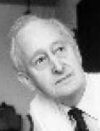
|
John Knott - Bolton, UK. (1919-2005) Collector and founding member of the UKSRC (and a
possible catalyst for its formation), and an early member of the Oughtred Society. He exhibited
his slide rules at his hometown Museum in Bolton in 1988 and 1996/7, in Salford Museum in 1989, and
in Manchester Science Museum in 1993. Retired from the General Railway Signaling Co of Rochester USA, working
in the UK near Manchester. where he had finished up as Manager of the Quality Control Department. Biography contributed by Colin Barnes, 2007 OS Bulletin.
|

|
Jochen Konrad-Klein - Germany. Collector. fellow of the Oughtred Society.
Treasurer and main OS contact for the "Rechenschieber-Sammler Treffen - RST" members.
He organizes the regular meetings and specializes in Aristo slide rules.
|

|
Michael V. Konshak - Louisville, CO. - Curator of the International Slide Rule Museum. Oughtred Society Award 2009.
Fellow of the Oughtred Society (previous OS webmaster) and member of UKSRC. Graduated from
Colorado State University - Pueblo, Mechanical Engineering (1981). Vietnam Combat veteran
US Navy (1965-1969). Product development engineer in the areas of computer mass storage
with 34 U.S. and world patents. for Digital, LMS/OSI, Optoech, StorageTek, Sun Microsystems.
Curator of ISRM. He was the CSU-Pueblo Outstanding Alumnus of the year in 2005.
Owned an inexpensive Pickett 140-ES in college and now enjoys researching and archiving
slide rules and related history. Mike's favorite SR for working ISRC problems is the K&E
Decilon, but favors the feel of the K&E 4081-5 and Post Versalog II for working math
computations. Appeared on BBC's and Nickelodeon's Robot Wars, Comedy Central's Battlebots,
and Discovery Channel's Robotica. Retired as of 2011. but has operated ISRM since 2003.
During the COVID-19 pandemic he wrote four fictional novels and completed the restoration
and preservation of 12,000+ pages of slide rule manuals
and published them in 22 volumes called the Slide Rule Instructions Library series on Amazon.
|

|
Rebecca A. Konshak - Louisville, CO. - Trustee of the International Slide
Rule Museum, LLC. dba ISRM. Becky received her bachelors Degree in Finance from UCCS
and a Masters degree from Denver Seminary. She currently serves on the ISRM Board of Directors as
Trustee and functions as the Secretary. Her High School slide rule is in the Concise gallery.
|

|
Dr. Robert Koppany, O.D. - (?-2022) Hawthorne, CA. - Collector. Fellow of the Oughtred Society.
Practiced as an Eye Care Specialist and owned his own clinics. Bob had written and published
eight books, was a leading scholar in the works of Frank Loyd Wright. He created the graphics
for the OS Slide Rule Reference manual and an editor of the
Journal of the Oughtred Society (JOS).
|

|
Hans Kordetsky - Cham, Switzerland - Collector. Fellow of the Oughtred Society and
Rechenschieber Sammler Treff (RST). Author of many articles for RST. One is a study and history of
Artur Ewert and Reiss Slide Rules (in German).
|

|
Prof. Bernhard Korte - Bonn, Germany. 2018 Oughtred Society Award.
Dr. Korte founded the ARITHMEUM museum for historical calculating instruments in Bonn, and made it a unique and outstanding institution world-wide, both with its collection and presentation. He is influential in the research in discrete optimization crucial for the design of modern electronic computers. With the ARITHMEUM and his Institute for Discrete Mathematics, Bernhard Korte shows us the past and points to the future of computation.
|

|
Klaus Krämer (Kraemer) - Berlin, Germany. Member of the Oughtred Society and
Member of Rechenschieber Sammler Treff (RST). Author of papers on slide rules on the RST
Rechenschieber-Brief.
|

|
Dr. H. John Krijnen - (1946 - ) Netherlands. Member of KRING. Contributor of scans to
ISRM. Retired Anesthesiologist and pain specialist who read Medicine at Leiden University. John bought his first slide
rule in 1960 (Sun Hemmi 66) and later used that and other slide rules in his practice to calculate dosages of
various drugs. In the photo, he carries a Pickett N3P behind the stethoscope. John published two books and
six articles on the Great War and maintains an interest in slide rules, photography, pistol marksmanship and painting.
|

|
Kal Kruuse - Vonge, Denmark. Co-founder of UTO, a Danish company, founded with Poel Larsen
that made slide rules and continues to make modern slide charts.
|
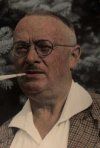
|
Carl Kübler (Kuebler) - (1875-1953) Berlin, Germany. Founder of the "Addiator" company.
He studied textile engineering until 1892/93, at the
textile school in Karlsruhe and worked his way up at textile factories in Elmshorn and Düsseldorf.
During this time he met his wife Schüder Martha and had applied for several patents in the textile sector.
With the patents he took off around 1910 and joined the textile factory in Fürstenberg an der Oder
(Eisenhüttenstadt). 1n 1925 he left this company over royalty disputes, and after a law suit,
he was awarded compensation. The young
family (the son Hans-Wolfgang was born in 1909, the daughter Margot in 1913) moved to Berlin.
Carl wanted to become an entrepreneur and searched for a
suitable product to manufacture. Around 1917, Carl Kübler bought a model of a slide adder which
was a registered patent of Otto Meuter (1892-1970). Carl paid Otto a small royalty and developed his famous Addiator based
on this design. In 1920 "Addiator" was founded and under his sole leadership
he produced various versions. With his son Hans-Wolfgang, he invented a combination of
slide adder and slide rule, which was produced together with Faber-Castell.
Immediately after the WWII, he gave the company to his daughter Margot and retired to his small house
in village Bliesendorf, west of Berlin, where he died at the age of 78.
|

|
Hans-Wolfgang Kübler (Kuebler) - (1909-2003) Berlin, Germany. Son of Carl Kubler,
the founder of the "Addiator GmbH". Hans-Wolfgang workrd on incorporating the Addiator into
Faber-Castell slide rules and during the war supported the military contracts of the Third Riech.
After his sister, Margot, was given control of Addiator GmbH, Hans-Wolfgang started a separate
business in 1950 making slide adders called Addimult in Donaueschingen.
|

|
Margot Kübler, later Schaffhiert-Kübler - (1913-2002) Berlin, Germany.
Daughter of Carl Kübler,
the ounder of the "Addiator". Margot was given control of the company just after WWII.
She married Carl Schaffhiert who died in 2001.
|

|
Ronald E. Kuc - Pennsylvania, USA. Collector/Dealer. Contributor of scans to ISRM.
Retired HVAC Designer. CADD Drafter, Teacher. Member of the Ohio State Teacher-Trainer Cadre.
PA Projects included: 3 Rivers Stadium, Heinz Hall, Benedum Center, Biotechnology and Bioengineering Facility.
National projects included: Detroit Renaissance Center, IBM Facility-Fishkill, Morgantown Energy Technology Complex.
Ron's collection includes 200+ slide rules, mostly POST and his personal favorite is the Versalog.
Received his first Versalog as a Christmas gift in 1961.
|

|
Walter J. Kudlaty - (1916-1994) Michigan, USA. Machine Tool Engineer. 51 U.S. Patents. Designed the Press Tonnage
Calculator slide rule in 1949 (see Misc USA gallery) while working for Warren Manufacturing Co. in Warren, Ohio, and helped design what was then the world's largest press brake for fabricating metal.
Later. as an engineer for Flick-Ready Corp., created his revolutionary pipe-sealing device in the mid-1950s. The Tru-Seal's key was tiny nuts, which were one-eighth-inch thick and a half-inch across. The Tru-Seal was used in 1957 on the satellite that the U.S. launched in answer to the Soviets' sputnik. It failed to enter orbit. Civilian Conservation Corps from 1934-36. He studied engineering at night and through correspondence courses. Served in the Army Air Force in World War II. Coauthored Hydraulics and Hydraulic Equipment in the 1950's and wrote his biography "The Greatest Wonder of the World" in 1990. Married to Martha Avis Kudlaty (1917 - 2003) and had 4 sons.
|
|
'Kue' through 'Z'
|
|
|

|
Dr. Klaus Kühn(Kuehn) - Alling, Germany. Collector. Fellow of the Oughtred
Society. Member of Rechenschieber Sammler Treff (RST). Oughtred Society Award 2004.
Donor/Associate of the ISRM Slide Rule Loaner in Europe. Author of many articles about
slide rules and logarithms listed on Rechenschieber-Brief. Klaus's business is
provides consulting services in visualization, analysis and optimization of workflows
with the help of computer simulation as
The Institute of Applied Simulation.
|

|
Dr. Günter (Guenter) Kugel - Moers, Germany. Collector. Fellow of the Oughtred Society.
Member of RST. Dean of the German slide rule collectors. Trader and friend of slide rule
collectors around the world.
|

|
John Kvint (1934-2009) - Denmark. Collector, slide rule historian. Designer of slide rules,
and later slide charts, for the Danish firm LINEX. Made specially commissioned slide rules for UTO.
Renowned speaker and presenter of papers at IM2007 proceedings.
|
Top
A
B
C
D
E
F
G
H
I
J
K
L
M
N
O
P
Q
R
S
T
U
V
W
X
Y
Z

|
Poel Larsen - Vonge, Denmark. Co-founder of UTO, a Danish company,
founded with Kal Kruuse that made slide rules and continues to make modern slide charts.
|

|
George Lee Lawrence - (1901-1976) Born in Ottawa, Illinois. Founded Lawrence
Engineering Services in 1930 in Chicago, a family slide rule business, that had roots in his father's
photography business. In 1935, Lee uprooted and moved over 160 miles south to Wabash,
Indiana, then later to Peru, Indiana. His 2nd wife was Vivian nee Breyer (1916-1973) who divorced
Lawrence in 1947 and took the business, renaming it Engineering Instruments, running it
with her new husband Frank Bozarth. Preferring the name Lee, he went on to start a plastics company
AGP Corporation making plastic cursors for other slide rule manufacturers, like Acumath.
AGP became sucessful making plastic toys. His 3rd wife was Nellie Mowbray (seen in Photo when enlarged).
|

|
Dr. Chris Leech - Congleton, Cheshire, UK. Collector. Member of Oughtred
Society and UKSRC.
|

|
Helmar Lehmann - (1911) Leipzig Germany. Mathematics and Geophysics at Leipzig University.
He worked for some time as a meteorologist and in 1946 became a teacher of Mathematics and Physics at various institutions
including the Karl Marx University. In 1966 he published "Der Rechenstab und seine Verwendung" on the use of slide rules.
|

|
Gottfried Wilhelm von Leibniz - (1646-1716) Germany. Mathematician, physicist, philosopher,
theologian, historian and inventor, developed a calculator in 1694 that became the next generation of
the Pascaline. He introduces the use of a handle to multiply
and divide to store the results in calculators.Each turn make the cylinders turn one or part of a
revolution. Deep into the 20th century this principle will be used in calculators. Leibnitz also
wanted to develop a generalized symbolic language and an algebra to go with his machines, so that:
"the truth of any proposition in any field of human inquiry could be determined by simple calculation."
This quest was unsuccessful, but he did invent the calculus and devised and promoted much of modern
mathematical notation still in use today. On the subject of calculation, Leibnitz wrote in 1685:
"It is unworthy of excellent men to lose hours like slaves in the labor of calculation which could
safely be relegated to anyone else if machines were used."
|

|
Étienne Lenoir - (1744-1832) Paris, France. A French scientific instrument maker and inventor of the repeating circle. When hired by Jean-Charles de Borda around 1772 to work on the reflecting circle, he was about thirty years old and nearly illiterate. However, his intelligence and mechanical genius allowed him to perform work that few others could perform. He played a significant role in the improvements to the reflecting circle and later used this experience in inventing the repeating circle. As a result of this work, he became known as the pre-eminent maker of instruments for astronomy, navigation and surveying in France.
In 1787, the king of France appointed him certificated engineer to the king. He created the instruments used on all the major French geodetic surveying projects and major naval expeditions of the time.
from Museum Galileo
|

|
Noël-Jean Lerebours - (1761-1840) Paris, France. The first of the great opticians who helped make the French optical industry competitive with the English between the late eighteenth century and the 1820s. Spyglasses are an example. He began his career as a mathematical-instrument maker, but soon became famous for the perfection of his lenses. He also managed to produce better achromatic lenses than the English. After 1800, he was optician to the French Navy and the Bureau des Longitudes, as well as supplier to the Imperial family. He increasingly specialized in the production of large objectives.from Museum Galileo. His adopted son, Noël Paymal Lerebours, carried on his work in the optician's shop.
|

|
Frederic H. Leubuscher, CE - (1906-1995) President of K&E's Salisbury Plant in Lakeville,
Connecticut from 1951-1978. Also designed famous gardens at Duke University.
|
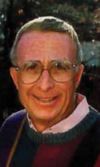
|
Richard M. Levin - (1925-2014) Co-founded Jason/Empire with his father Jake Levin. He served two and half years in the US Army and was wounded at the initial battle of Leyte, Philippines, in 1944, receiving the Combat Infantryman Award and the Purple Heart. He returned to college in 1945. Richard spent two years working in Chicago after graduating from the Wharton School in 1947. The Jason/Empire was co-founded in 1949 initially as "Jake and Son". Their early optics customers included jewelry stores along with then popular catalog showrooms. The name was soon shortened and formalized to "Jason" with headquarters offices in Kansas City, Missouri. Empire, which evolved as part of the firm's name, was a brand of products sold by the firm in its early years. Re-branded slide rules were added to their offerings during the 1960s. Richard was the CEO. The main products the company sold were binoculars, telescopes, microscopes and weather instruments; later the company specialized in tennis products. After taking the company public in 1969, Richard arranged the sale of Jason/Empire to the Carlson Company of Minneapolis in 1977 the Jason headquarters remained in Kansas City. The company ultimately ending up as part of Bushnell Optics.
Note: Richard Levin and his wife, Carol, collected of painting from unknown American artists. In 2015, one year after his death, A collection of 33 American paintings amassed over half a century sold for $2.32 million at an auction in Chicago, shattering presale estimates.
|

|
Murray I. Lieb - Edited the Sterling Plastics Instruction Manual for the Decimal Trig Log-Log Slide Rule. Currently Associate Professor of Mathematics at New Jersey Institute of Technology (NJIT). He has a PhD in Mathematics, New York Polytechnic Institute,
an MS in Mathematics, New York University,
an MS in Electrical Engineering, NJIT, and a
BS in Electrical Engineering, NJIT. He has received numerous honors and awards while on the faculty of NJIT.
|

|
Adolph Lietz - (1860-19351 or 1850-19232) Adolph Lietz was born in Leubeck, Germany. He immigrated
to San Francisco in 1879 and worked in several scientific instrument shops before opening
his own business. Lietz purchased the business of Carl Rahsskopff in 1880 and began his
own business in 1882. Lietz originally joint ventured with another maker, Gottlieb A. Mauerhan,
to form "Lietz and Mauerhan," a relationship that lasted for about a year. Following
Mauerhan's departure, Lietz paired up with Conrad J. Weinmann who had previously worked
for Carl Rahsskopff. The company was renamed A. Lietz & Co. and at that time produced
surveying instruments and related tools. According to the 1940 census, he had a son, Adolph Lietz, who was born in 1888, married a Mary, and was the President of an Engineering Instruments Company, presumed to be his father's company, at that time. They lived at 21 Yuba Buena Avenue, San Francisco.
1 1860-1935 per Francois "Bud" Uzes. Ref: Lantz, Kristy "Lietz, A History of the Company," Professional Surveyor, Frederick, MD, March/April 1984 at surveyhistory.org
2 1850-1923 per Tim Mack at surveyantiques.com
|

|
William (Bill) Lise - Japan. Collector/SR Historian. Member of Keisanjyaku, the Slide Rule Lover's Group
in Japan. Bill is the founder of Lise & Partners, Inc. and comes from a background in engineering and
provides patent translations and interpreting for US patent litigation involving Japanese entities.
Born in the US, Lise first came to Japan in 1967 as a language specialist for the US Navy. After returning
to the US and obtaining a BS in electrical engineering, he joined what was then Western Electric, and
worked in millimeter microwave and fiber optics laboratories.
|

|
Dr. Brian Beynon Lloyd - (1920-2010) Oxford, UK. CBE, MA, DSs. Emeritus Fellow of Oxford University's Magdalen
College and former chairman of the Health Education Council. Founding director of Oxford Polytechnic in 1970, which later became
Oxford Brookes University. He also served as chairman of the Health Education Council and in 1983, was made a CBE in
recognition for his work raising awareness of the dangers of smoking. Collector. Fellow of the Oughtred Society.
One of the earliest members of UKSRC (1994).
|

|
George L. Lockhart - Slide Rule, Designer, Manufacturer. founder of
Slide Rule and Scale Engineering, CO. in Laporte, Indiana in 1930,
and later New Carlisle, Indiana. SR&SE made custom slide wood slide rules,
such as the Concrete Quantity Calculator, as well as a standard Mannheim with
A-B-C-D-K & L scales. Rules were manufactured using magnolia
wood, finished white with an Ethyl-Cellulose base, then printed. A
transparent lacquer coating was then applied to protect the printing. In 1945 a
facility was built in Mt. Olive, Illinois. On February 14, 1947 the biggest fire in
Mt. Olive history destroyed part of the factory. Production resumed
in remaining buildings. On April 14, 1950 the company was declared bankrupt.
Nicholas Muschong, a Vice president of Acu-rule, filed to do business in
Illinois, and may have acquired the assets and copyrights. Similar in design and
construction to Lawrence Engineering Services and Festus (Later Acu-Rule)
Manufacturing. Other calculator models advertised in a 1940 flyer were Concrete
Block and Mortar, Brick and Hollow Tile, Lumber, and Galvanized Sheet Steel
Weight. Photo contributed by Mike Becktell, who's wife is the great-grandaughter of George Lockhart on her mother's side
|

|
Rodney Lovett - Addlestone, Surrey, UK. Collector. Member of UKSRC. Fellow of the Oughtred Society.
Oughtred Society Award 2007. Created an extensively used search engine for comparing past
eBay prices and other facets of slide rule information available on his Website
|

|
Millie (Mildred?) Ludwig - Owner of Grafton Plastics of Grafton, Wisconsin. A small injection molding company owned
by Millie Ludwig and her husband, that made two types of all plastic slide rules
starting after WWII in 1946. They rebranded the slide rules for Bruning (model 2401
and 2420), Dietzgen (1771 Redirule), Post(1444-P and 1452-P) and Compass (1018 and 1020). Not much is known about the company.
|

|
Prof. Dr. Jörn Lutjens - Hamburg, Germany. Collector and member of
Rechenschieber Sammler Treff (RST).
Teacher at the State Vocational School of Mechanical Engineering and Steel,
Seminar director at the National Metals Technology Institute
and as Professor of Professional Pedagogy and Didactics at the University of Hamburg.
His website, in both German and English is the
Jörn's Online Museum
|

|
Joel L. Lynn - (1943-2022) Washington D.C.. Collector. Member of the Oughtred Society.
He was born in 1943 in Philadelphia, PA to Edward and Frances Lynn. He graduated from Brown University after which he joined the Marines. Joel served
in Vietnam and was awarded the Purple Heart. He spent several years as a stockbroker before he decided to learn clock-making.
After school and apprenticeship, he opened his own clock repair business. He retired in 2016. Joel was an avid bicyclist,
motorcyclist, flyfisher, bird-watcher, tailor and sailor. His wife, JoAnn Lynn, gifted his collection to ISRM.in her husband's memory.
|

|
Richard F. Lyon - Los Altos, CA. Member of the Oughtred Society.
Authority and large collector of Otis King cylindrical slide rules.
See his Otis King Website
|
Top
A
B
C
D
E
F
G
H
I
J
K
L
M
N
O
P
Q
R
S
T
U
V
W
X
Y
Z

|
Andrew Alexander Mahoff - (1919-1989) United States. Aeronautical Engineer who helped design and write the instructions (Authero A.A. Mahoffor the Douglas Sky Rule Model, Pickett Model 100, Made for Douglas Aircraft Company. He was a 1940 graduate of Georgia School of Technology, where he was an honorary member of the Engineering Council and a member of the Institute of Aeronautical Sciences. worked as an instructor during 1942-1943 teaching Engineering Drawing and Mechanics. At the time the manual was written in 1951, Mahoff was an Assistant Aertodynamica Engineer for Douglas Aircraft Company's Testing Division in Santa Monica, California. The photo is from the 1940 Yearbook.
|

|
Andries J.M. de Man - Netherlands. Member of Oughtred Society. Recipient of the 2021 Oughtred Award at IM2021. Collector of Loga circular slide rules.. He wrote many papers on historical calculating machines and mathematical instruments. Most of them have appeared in Dutch in the "Mededelingen en Informatie voor Rekenlinialenverzamelaars" (MIR). website: Calculating History
|

|
Ronald (Ron) E. Manley - England. Avid collector. Member of the
Oughtred Society and United Kingdom Slide Rule Circle (UKSRC). Deciminator of slide rule prices, current
and in recent past and other slide rule information on
Ron Manley's Slide Rule Site
which has been around since 2000.
Ron's interests extend into climatology which can be seen at his website
Climate Data Information.
|

|
Victor Amédée Mannheim - (1831 - 1906). France. Mannheim entered the École Polytechnique in Paris in 1848 at the age of 17. He was a 19 year old student
when he proposed the application and labeling of A, B, C and D scales in 1850.
which slide rules of that type were later called Mannheim in his honor. He later
became a French army artillery officer and retired in 1901.
|

|
Eric Marcotte, Ph.D. - Canada. Collector. Neuroscience research background,
with expertise on new and emerging technologies. Eric's popular Slide Rule
website features his
personal collection, along with tips on cleaning and using slide rules.
|

|
Nicola Marras - Italy. Collector, promotes through exibits and educational courses the
memory of old calculating devices and ancient navigation systems.
Nicola wants young people to understand that the world as we see now, skyscrapers, highways,
atomic power, space exploration and the electronic computer, was possible because of simple tools like slide rules.
His main event every year is the exibit at Cagliari festivalScienza.
His goal is the construction of a permanent museum of calculus.
Nicola Marras's Calcolatoria Website (both in Italian and English).
|

|
Gonzalo Martin - France. French/Spanish collector. 2013 Oughtred Society Fellow. Retired from the telephone industry.
Started collecting mechanical calculators
in 1994 then later included white slide rules. His favorite slide rule is the French Graphoplex.
Gonzalo's popular European slide rule site, written in French and Spanish
is Photocalcul.com
.
|

|
P.A. (Tom) Martin - (1936-2023) United Kingdom. A founding Member of UKSRC.
Originally a Surrey man, Tom left school to become a laboratory technician
at the Brewing Industry Research Foundation whilst studying for a "traditional" External B.Sc. in
chemistry and botany at the University of London. On graduation he moved into industry, first a
glucose refinery in Greenwich and then back into brewing, initially in Warrington and then Burton
upon Trent - retiring, after 42 years, as Technical Director of Carlsberg Tetley.
Tom was a Unique (brand) slide rule user at school but found an Otis King early in his career which continued
to meet his calculating requirements. He really discovered slide rules when his father inherited the
tool box of a neighbour who had been a ships' carpenter early in life. In the bottom of the damp box
and smelling strongly of vinegar were two 12 inch 4-sided Everard type rules together with a collection
of (mainly incomplete) sectional gauging rods.
Tom's main slide rule collecting interests were in rules associated with traditional crafts and trades.
|

|
Kate Matthews - Sonora, CA. Collector. VP and Fellow of the Oughtred Society .
Geological Engineer and private business owner. Prefers collecting early K&E's. Her
favorite is the 1915 column cursor model.
|

|
Steven Mays - Beaverton, OR. Collector. Fellow of the Oughtred Society.
Advanced slide rule researcher and collector.
|

|
Jerry McCarthy - United Kingdom. Researcher. Fellow of the Oughtred Society.
Author of a series of in-depth papers and presentations at International Meetings (IM's),
articles and supporter of the activities of the UKSRC. Jerry's day job is to write
software, in areas such as cryptography and internationalization, for a global computing company
|

|
Paul McConnell - Columbus, Ohio. Oughtred Society Fellow, collects
books and artifacts from all information-related
fields. Publishes in The OS Journal. Originally from Millville, New Jersey, Paul
served in the United States Air Force as an armament
specialist for Boeing B-52 aircraft. He later had a career with the New Jersey Bell Telephone
Company, the Western Electric Company in Columbus,
Ohio, and Lucent Technologies' Bell Labs. Paul
participated in the revolution that led from open
wires on glass insulators and rotary dial telephones
to the UNIX Operating System, fiber-optic data
transmission, cell phones and the internet,
|

|
Clark McCoy - Roseville, CA. Collector. Membership Secretary and
Fellow of the Oughtred Society. 2013 Oughtred Society Award.
Webmaster for the popular McCoy's
K&E Catologs website. Retired Engineering manager
|

|
David_McFarland - (1942-2017) Ranch Palo Verdes, CA. Collector. Fellow of the Oughtred Society.
Retired Socialogist. Collection consists of slide rules and other computational devices. He began his career in the Department of Sociology at the University of Chicago before joining the faculty at UCLA in 1975, where he remained until retiring in 2008. David had three main interests in his work, 1) social inequality and social mobility, 2) Mathematical models of social phenomena including graphical and statistical tools for analyzing data, and 3) Computers as tools, toys and as social phenomena to be studied. We of course knew David as an intrepid slide rule collector and participant at Oughtred Society meetings. We often marveled at David's spirit, when confined to a wheel chair, he continued to attend meetings with his wife helping him get around. One of is his notable quotes: "A slide rule might work, but there are two potential problems to consider. Both the prospective users and the slide rule itself are short on relevant experience."
|

|
Jerome (Jerry) McKenna Memphis, TN. Collector. Fellow of the Oughtred Society.
Advanced collector of many types of slide rules. Software Developer who got into computer
programming when the cost of slide rules for meteorology was the same as that of an HP 41CX.
|
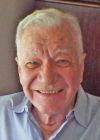
|
Jerry Merryman - Dallas, Texas. Graduated from Texas A&M and joined TI in 1963 and
retired after 30 years in 1993. Jerry did the logic design for the world's first hand-held
calculator at Texas Instruments, a prototype called "Cal Tech", using the Large Scale
Integrated circuit invented by TI inventor, Jack Kilby, and Van Tassel. While studying at the
Texas A&M School of Engineering, Jerry won the Freshman Eng'g Problems Slide Rule Contest
at 1945. In winning this test of slide rule speed, dexterity, and accuracy, Jerry scored a
record 279 out of a possible 280, which was never topped. He was a joint receipient of the Holley
medal in 1989 from the American Society of Mechanical Engineers. Other recipients of the Holley
Medal are Henry Ford, 1936, Edwin Land 1948, and William Shockley, 1963. Jerry shared a story with
us which dates back to his childhood: "I was walking along the street when I was about 8 years old,
and found a slide rule, one of the dollar jobs, minus the cursor, of course. I thought it was a ruler,
but noticed the measuring marks were not evenly spaced." This puzzle led to more study, and Jerry,
without knowing what a slide rule was, figured out how to multiply and divide with it. He says he's
still very fond of slide rules. His friend Ed Millis, a contributor to ISRM, wrote this
biography of Jerry Merryman.
|

|
Otto Meuter - (1892-1970) Berlin, Germany. Otto Meuter was constructor in the Addiator-factory. He left Addiator and
produced, with the aid of Jean Bergmann, the calculators Pro-Calculo and Correntator. In 1928 he founded Werkstatt Otto Meuter
in Berlin and produced the first Produx machines. After World War II Otto's son Claus went to Bremen (West-Germany) and Luzie Meuter
(the ex-wife of Otto) started producing calculators in East-Germany under the name Record LM.
|

|
Ross R Middlemiss - (1903-2001) In 1946, Middlemiss was a Professor of
Applied Mathematics at Washington University and edited the basic manuals for the
Acu-Rule slide rule company. Born in Marysville, Kansas, He received his advanced
training in mathematics at the University of Colorado and taught there until 1929.
Professor Middlemiss taught at Washington University for the next forty years,
During the period from 1936 through the 1950's, he authored several books including
a widely popular calculus textbook which was used in Washington University College
courses until the late 1970's. In 1966 he was presented with a Washington University
Distinguished Faculty Award (given annually at the university's Founders' Day
celebration). In 1969, he retired as Professor of Mathematics and was given the
status of Professor Emeritus.
|
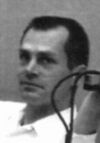
|
Ed G. Millis - Dallas, Texas. Collector. Attended Rice University in 1946 where he used a K&E 4081-3. After college, he joined Geophysical Service, Inc., predecessor of Texas Instruments (TI), and in 1950 he worked as an Electrical Engineer on military electronic equipment. Ed transferred in June 1954 to the Semiconductor organization and stayed with TI for 37 years. Author of several books including TI, the Transistor and Me which talks about his career as an engineer at TI and was endorsed by Jack Kirby, the inventor of the micro chip at TI and a Nobel Laureat. Ed was at TI while the electronic 'slide rule' calculator was developed and is good friends with Jerry Merryman, the designer of the first calculator in 1967. Ed has also written a book on hobbies Hither, Thither and Yawn.
Ed is a generous donor of over a hundred slide rules, calculators and ephemera to ISRM.
|

|
Marion Moon - Orange, California, USA. Member of the Oughtred Society.
Retired Software/Systems Engineer at Hughes Aircraft Co. BSEE University of Kanasas.
Collects End-of-Era Slide rules from worldwide manufactures. Contributor of scans to the ISRM.
|

|
John F. Morrison - ( ? - ?) Boonton, New Jersey, USA. Designer of the K&E 4138 Morrison Radio Engineers Slide Rule (1938) for Bell Telephone Laboratories, Whippany, N.J. He wrote 4 technical papers for the IEEE Journal between 1937 and 1948 while at Bell Labs. At Bell He was the author of 1940 US patent #2,359,916 Ultra Short Wave Antenna System and co-author of #2,575,799 High-Frequency power and Impedance Monitor in (issued 1952). In 1948 he co-authored the 1953 Canadian patent #494,130 Power and Impedance Monitor for Western Electric Co. in New York. In 1953 he filed a US Patent # 2,853,173 Capacity-Controlled Electronic Coil Totalizer (issued 1958) while working at Rowe Manufacturing,Whippany, N.J. In May of 1937 at the 25th Institute of Radio Engineers (IRE) Anniversary Convention, John Presented the Technical Paper "Simple Method for Observing Current Amplitude and Phase Relations in Antenna Arrays". and was on the IRE National Convention Record Commitee in 1956. At the 1958 IRE Convention, John F. Morrisone was the Chairman of the Aeronautical and Navigational Electronics Session. He was still listed as an employee of Bell Labs at that time.
|

|
John Mosand - ( ?-2013). Trondheim, Norway. Fellow of the Oughtred Society.
Advanced collector and researcher of Aristo slide rules, frequent contributor to the
Journal of the Oughtred Society and the Bulletin. Proofread the ISRM's Slide Rule
Terms and Encyclopedia. Retired architect. Education: Architecture, Art history,
Graphic design. Played 12 years as a professional oboist with the Trondheim Symphony
Orchestra. Appeared extensively in chamber music concerts.
He writes: "My favorite slide rule? That might be the one I worked with in my High
School and University days and in my profession until I bought my first calculator.
It is a pocket version of the Faber-Castell Darmstadt."
|

|
Matteo Munari - ( ?-?). Italy. Collector.
|

|
Mitsuo Kamiyama - ( ?-?). Japan. Associate professor of Civil Engineering Musashi Institute of Technology (1949), Yokohama, Japan (Renamed Tokyo City University in 2009). c1949 Author of the Relay/Ricoh slide rule manuals later rebranded by Alvin, Compass, Lafayette, Micronta, SIC and other OEMs part of the San-ai Keiki Co. group.
|
Top
A
B
C
D
E
F
G
H
I
J
K
L
M
N
O
P
Q
R
S
T
U
V
W
X
Y
Z

|
Kees Nagtegaal - Netherlands. (1949 - ) Collector. Member of the Dutch Circle of
Historical Calculating Instruments (KRING - Rekenlinialen).
Studied mathematics at Leiden University. Since 1970 has been a high school math teacher (HAVO and VWO).
He says: "I found my first calculator in 1999. It is an original Odhner 24. I saw it in Amsterdam in an antiques and collectible shop
This Odhner was the start of my calculator-collection (or calculator-obsession)."
Kees specializes in collecting and documenting mechanical calculators and slide rules on his website
Mechanical Calculator - I recalculate.
His collection has more than a hundred mechanical calculators (Odhner, Brunsviga, Facit, Addiator, Produx, etc.), addingmachines
(Comptometer, Burroughs, Plus, etc), counters (Durant, Record, Hengstler, Dux, etc), slide-rules (Aristo, Nestler,etc) etc.
|

|
Riki Nakamoto - Aiea, Hawaii. Collecter, Member of the Oughtred Society.
Engineer at Pearl harbor Shipyard. Collects whatever he thinks is a neat gadget.
Riki's favoites are the Picket B1, N904 and N901 Simplex Math.
He was born on the island of Lanai and graduated from the University of Hawaii-Manoa on Oahu.
He writes: "I first became
interested in slide rules when my father showed me his Pickett and Eckel 600-ES.
He later gave it to me, and I carried it through part of high school and my first
semester of college. I also carried it as a backup to my calculator when I took
the Hawaii professional engineering licensing exam in 1981. The slide rule I saw
most in college was the Post Versalog. I guess that is why I have an interest in
Japanese bamboo rules, especially log-log, and Pickett."
|
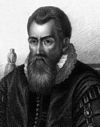
|
John Napier - (1550-1617) Edinburgh, Scotland.
- Lord John Napier (latinized Nepero), Baron of Merchiston.
Published the logarithm in 1614, after 20 years of developing the tables, which made
it possible to perform multiplications and divisions by addition and subtraction
and was the foundation for all future slide rule designs. Ex: a*b = 10^(log(a)+log(b))
and a/b = 10^(log(a)-log(b)).
|
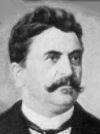
|
Albert Nestler - (1851-1901) Manufacturer. Founded Beck & Nestler in 1878 with Theophil Beck.
When Beck retired, the firm became just Nestler.
|

|
Albert Nestler - (1877-1961) Technical Director of Nestler AG.
Albert and his brother Richard Nestler were the sons of the founder Albert Nestler.
After the death of Albert Nestler in 1901, By 1955, both sons had expanded the factory with 600
workplaces. Note: In this painting he is leaning at a dividing machine for slide rules).
|

|
Jürgen Nestler - Hausach, Germany. (1940- ) Great grandson of founder of Albert
Nestler Co. in Lahr, Germany. Jürgen was a manager in factories providing injection
molds as a supplier for the automobile industry and was a member in
the german VDI (Verein Deutscher Ingenieure, Society of German
Engineers). His apprenticeship was in the Nestler factory and after his education, constructed constructed amny of the machines. A generous benefactor of the Oughtred Society, to which
he donated 50 new Nestler slide rules for inclusion at no cost to buyers in the OS
Slide Rule Learning Kit. Jürgen contributed the Nestler family portraits shown in this gallery
along with other useful information including some personally owned slide rules. He donated a large collection of Nestler slide rules to the State Museum for Technology and Labor in Mannheim, Germany.
|

|
Richard Nestler - Germany. (1878-1956) Commercial Director
of Nestler. He and his brother, Albert, were the sons of the founder Albert Nestler.
|

|
Sir Isaac Newton - Great Britian. (25 December 1642 - 20 March 1726/27) Newton was an English mathematician, physicist, astronomer, alchemist, theologian, and author (described in his time as a "natural philosopher") widely recognised as one of the greatest mathematicians and physicists of all time and among the most influential scientists. Concerning slide rules, he used three parallel logarithmic scales to solve cubic equations. He also suggested the use of a runner or cursor for the rule. More at Wikipedia.
|

|
Richard Nestler - Germany. (1878-1956) Commercial Director
of Nestler. He and his brother, Albert, were the sons of the founder Albert Nestler.
|
.
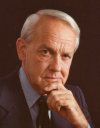
|
Fred C. Ninger - (1915-1992) ? Born in Hoboken NJ (home of Esser and Keuffel). Best known for 46 years in pharmaceutical research, producing over 20 patents and the research for Lipitor among other drugs. Developed the Medical Slyd-Rul in 1946, a measures conversion tool for doctors, offered as a giveaway by Ciba and other drug companies of the day. Over 15 years, developed other Ruls including Elemental for chemistry students, Pharmaceutical, Photographic and Colorist for chemical manufacturers. With his brother Harold, sold over half a million Ruls.
|

|
Hitoshi Nori - Tokyo, Japan. Collector. Engineer.
Member of Keisanjyaku
the Slide Rule Lover's Group. Hitoshi's Website
offers loans to teachers and is listed as part of ISRM's Slide Rule Loaner Program.
Note: use Google's
Lanquage Tools to translate this web page from Japanese to English or...
|

|
John W. Nystrom - (1825-1885) Philidelphia, Pennsylvania. United States. Born in Sweden, a
civil engineer, inventor and author. Nystrom received many patents for inventions such as a marine
steam engine, a refrigerator, and calculating machines. His slide rule invention
(U. S. patent #7961, the first in the united States)
was filed with the United States Patent Office on March 4, 1851. Nystrom is most noted for his proposal
to switch from base 10 to base 16 as defined in his 1862 publication titled Project of a New System
of Arithmetic, Weight, Measure and Coins, Proposed to be Called the Tonal System, with Sixteen to the Base.
|
Top
A
B
C
D
E
F
G
H
I
J
K
L
M
N
O
P
Q
R
S
T
U
V
W
X
Y
Z

|
Hisashi Okura - (1892-1960)
Hisashi Okura, the founder of Hemmi Slide Rule Co., Ltd.(1933) was born in Kumamoto prefecture, in the south of
Japan. Born in the Otsuka family, a family with a member in the government Cabinet during the Meiji era, he
married the oldest daughter of the Okura family, owner of the then Okura brewing company (now Gekkeikan Sake)
and became member of the family. In 1924, Hisashi had proudly found a Japanese Hemmi's slide rule in a shop in
London when was traveling around the world. Jiro Hemmi had experienced some business setbacks because of a
fire in his shop, and when Hisashi came to visit Jiro in 1925, he offered to help expand the business.
He assisted Jiro Hemmi in managing his shop and actively promoted exportation
to respond to demand from foreign countries. They formed a partnership in 1928.
Hisashi directed the development of slide rules which could compete
with the well-known ones from other countries. He also implemented a research department in which he
committed to developing original Japanese slide rules.
|
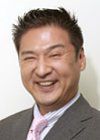
|
Takeshi Okura - Tokyo, Japan. Current President and CEO of
Hemmi Slide Rule Co, Ltd and
FT Okura Inc. It
is assumed that Mr. Okura is related to the founder of Hemmi Slide Rule, Hisashi Okura (1892-1960),
possibly his grandson.
|

|
Michael O'Leary - (1951-2003) Vermont. Was a prolific Slide Rule Collector and provided
stimulating and moderating internet discussions on the Yahoo Forum International Slide Rule Group (ISRG).
Researched and published comprehensive studies and catalogues, especially on Keuffel & Esser and Pickett slide rules. Oughtred Society Award 2002.
|

|
Arthur Orans - (1959-1989) Philomath, Oregon. Graduate of Pratt Institute School of Archetecture and a Masters degree in civil engineering from Oregon State university. He was an award winning Horticultural Photographer with over 10,000 subjects published in many forms of media. Founded the Philomath International Slide Rule Society (P.I.S.S. - now defunct) in 1983 after he found an 'orphan' slide rule at a
flea marke. His organization, the first collecting group, and prior to the internet, grew to more than 400 members worldwide.
Periodic newsletters were sent to members,
The society maintained manuals for slide rules with special uses - such as those for chemical, integral, and naval
engineering. Many sympathetic to his cause had sent slide rules to Mr. Oran - from high-tech to big classroom
models. In turn, he donated many of the specimens to the Oregon Museum of Science and Industry in
Portland. At the time, fellow slide-rule enthusiasts could join his society by sending a $7 membership fee to Philomath International Slide Rule Society, Box 892, Philomath, Ore. 97370. He passed in 1989 in San Diego
|
of

|
Robert (Bob) K. Otnes - Palo Alto, CA. Collector and advanced researcher of
slide rules and mechanical calculators. Member and Co-Founder of the Oughtred Society with Dr. Roger Shepard.
Bob was editor of the Journal of the Oughtred Society (JOS) for 18 years. Oughtred Society Award 1993.
Featured in 2001 LA Times article
He received a BA in maths, astronomy and English
literature, an MS in math and physics and a Ph.D in engineering specialising in communication theory and
applied math.He has co-authored some books, now out of date, on signal processing.
Excluding two years in the US army, his first job was as a programmer trainee at Douglas Aircraft in 1958.
So he was in computing in the early days (the IBM 794 in use had tubes),
He retired as an Electrical Engineer from the L-3 Com company.
Bob has a fair collection of slide rules, calculators (including 10 arithmometers), log tables,
planimeters, analogue devices, old books on these subjects, etc. He is in the process of
writing two books. One on K&E slide rules before 1915, the other on small adding devices,
with and without carrying mechanisms, with an emphasis on American designs.
|

|
William Oughtred - British (1574-1660) An ordained Anglican minister, is
considered the true inventor of the slide rule (1625) by taking two Gunter's lines
(scales) and sliding them relative to each other thus eliminating the dividers. He
also introduced the "x" symbol for multiplication, as well as the abbreviations "sin"
for sine and "cos" for cosine in his Clavis Mathematicae (1631), composed for
instruction of his pupil, the son of the Earl of Arundel. Oughtred was born at Eton,
and educated there and at King's College, Cambridge, of which he became fellow. Being
admitted to holy orders, he left the university about 1603, and was presented to the
rectory of Aldbury, near Guildford in Surrey; and about 1628 he was appointed by the
earl of Arundel to instruct his son in mathematics. He corresponded with some of the
most eminent scholars of his time on mathematical subjects; and his house was generally
full of pupils from all quarters. Oughtred published, among other mathematical works,
Clavis Mathematicae (The Key to Mathematics), in 1631; a treatise on navigation
entitled Circles of Proportion and the Horizontal Instrument, in 1632, which described
the first slide rules and also sundials, works on trigonometry and dialling, and his
Opuscula Mathematica, published posthumously in 1676.
|
Top
A
B
C
D
E
F
G
H
I
J
K
L
M
N
O
P
Q
R
S
T
U
V
W
X
Y
Z

|
Prof. Joseph (Joe) Pasquale - San Diego, CA. Professor at University of California, San Diego, Engineering.
Teaches a popular slide rule class to engineering students. Pasquale was recognized as
an exemplary teacher, mentor and leader within the Department of Computer Science and
Engineering (CSE) at the Jacobs School of Engineering. Joe's bio at UCSD.
|

|
Prof. Giovanni Pastore - Policoro (Matera), Italy. (1954 - ). Graduated in Mechanical Engineering at the Politecnico di Torino in 1978. Before graduating Fiat Mirafiori in Turin offered an employment contract, and worked for five years to design cars, dealing with structural calculations. Since 1982 he lives and works in Policoro (Matera), where he holds the professional engineer and a teacher Assistant at the Faculty of Engineering of the University of Cosenza. Wrote the book Antikythera E Regoli Calculatori Computers (2006) which covers Science and Technology of the Greek astronomical calculator and Instructions for using the mathematical logarithmic slide rules, reinforced concrete and special, with many examples of calculation. Giovanni's website (in many languages)
|

|
Eugene Paulin - Luxembourg. Collector. Member of Rechenschieber Sammler Treff (RST).
|

|
Samuael Pepys - (23 February 1633 - 26 May 1703 ) was an administrator of the navy of England and Member of Parliament who is most famous for the diary he kept for a decade while still a relatively young man. The detailed private diary that Pepys kept from 1660 until 1669 was first published in the 19th century and is one of the most important primary sources for the English Restoration period. It provides a combination of personal revelation and eyewitness accounts of great events, such as the Great Plague of London, the Second Dutch War, and the Great Fire of London. In his diary, he claimed that he was a pioneer in the use of the slide rule based on a logarithmic scale and was no doubt the first to apply the name "slide rule" to the invention. Science News Letter, Nov 19, 1938
|
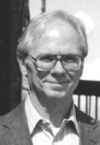
|
John Wickersham Pickett - (July 14, 1926 - ) Son of Roswell Colvert Pickett, co-founder
of Pickett and Eckel Co. Born in Chicago, John worked in the marketing of P&E after receiving his
MS in Business from the University of Southern California. He founded Pacific Leather Works to
make leather sleeves for Pickett in 1953 and became president of Pickett & Eckel in 1957.
|

|
Roswell (Ross) Colvert Pickett - (Mar 27, 1892 - Dec 23, 1969) Co-founder of Pickett
and Eckel Company in Chicago in 1943 with Arthur Eckel. His background skills were as a printer, which he used to
create printed scales on a cardboard model, then progressed quickly to all-metal bodied slide
rules. His oldest son was Allen Roswell Pickett. His second son, John W. Pickett, later took
over the reigns of the company. Ross was buried in Santa Barbara Cemetary, CA. (Geneology
information found in Margo Louise Pickett's family Bible purchased at a garage sale in Chicago
around 1980 by John Albert.)
|

|
Charles N. Pickworth - (1861-c1925) Mechanical engineer. Designer of slide rules produced in Fallowfield, Manchester. 190-1925. Wrote the
Instructions for the Use of A.W. Faber's Improved Calculating Rule
and The Slide Rule, A Practical Manual, LOGARITHMS FOR BEGINNERS,
THE INDICATOR: ITS CONSTRUCTION AND APPLICATION; THE INDICATOR DIAGRAM: ITS ANALYSIS AND APPLICATION ;
ETC. Both Albert Nestler and A.W. Faber made slide rules marked as "CN Pickworth" or "System Pickworth".
|
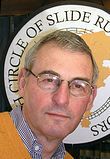
|
Otto van Poelje - Netherlands. Fellow of the Oughtred Society.
Oughtred Society Award 2008. OS board of directors. Active member, international
contact and webmaster of the Dutch Circle
for Historical Calculating Instruments (KRING);
frequent contributor to the OS Journal and to the OS Bulletin, which was his
original idea for the OS to publish; creator of The Oughtred Society Award program;
source of many new ideas for the Society. Has many contributions to the OS Journal
and Slide Rule Gazette, and is Regional Director-Europe for the International
Slide rule organizations. In late 2009, Otto became an associate editor of the
Journal of the Oughtred Society (JOS).
|

|
Etienne Pommel - France. Collector. He wrote Essay on the dating of Tavernier-Gravet rules by where references (addresses, medals, type of cursor, etc.) help date these ancient French historical rules.His collection of French slide rules are hosted at photocalcul.com
|
|
|
Andreas Poschinger - (1968- )Munich, Germany. Donor of several slide rules to the ISRM archives. He writes: "I grew up in the small plumbing company of my grand father, who used slide rules up to end of his business in the late 70ies. So I was already fascinated by slide rules as child, and I partially also used them at school, since for my teachers those were rulers only. I came back to slide rules in 2018 and since this time I am mainly interested in scale layouts and their history."
|

|
Antonio Pérez-Prados - Navarra, Spain. Collector of calculation instruments since 1980.
Professor at the Public University of Navarra, Spain in the mathematical
specialty of Operations Research.He admires John Napier, creator of logarithms and Neperian abacus
(Napier's bones). His specialty is the Spanish slide rules, circular slide rules and the
Neperian abacus. He is a member of ARC (Friends of the Slide Rules). Today he owns about 1,200 calculating devices in total.His collection comprises about 1200 specimens.
with 200 shown in a permanent exhibited in one of the
Public University buildings. His collection is on his website:
calculatinginstruments.com.
|

|
Osborne Ingle Price - (September 30, 1930 - June 3, 2008) One of the original founders
(and Fellow) of the Oughtred Society that met together in 1991, in which he acted as the publicty
director. Compiled the the list of American slide rule patents. He studied mechanical engineering
at the Stevens Institute in Hoboken, NJ, earning his degree in 1955. After a stint in the U.S.
Navy he ran his father's business, Magnetic Devices. He relocated to Los Altos, CA. He is survived
by his wife Elfried in San Jose, CA.
|
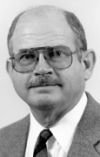
|
John Prince III - (November 13, 1941 - December 16, 2005) Born in Austin Texas. John
graduated from Southern Methodist University Magna Cum Laude with a B.S.E.E., and he earned an
M.S.E.E. and Ph.D. from North Carolina State University. Worked at Texas Instruments,
then as a professor at Clemson University. In 1983
became a Professor of Electrical & Computer Engineering at University of Arizona.
John specialized in collecting K&E rules, with a strong interest in Pickett. In 2002, John
described how he started with slide rules back in 1960: "I used a K&E 4181-3. We were mandated
to use either a 4081-3 or 4181-3 in our freshman slide rule class.
I chose the cheaper (very important to a married 18 year old) rule and never
regretted it despite the dire predictions from some faculty about dimensional stability and
durability." Among John's awards were the 1988 Inventor Award by Semiconductor Research Corp.,
the 1988 Semiconductor International Technology Achievement Award and the 1991 Arizona Innovator
of the Year. He is survived by his wife Martha in Tucson, AZ.
|
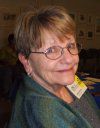
|
Martha Prince - Collector. Member of the Oughtred Society. Acquired her husband,
John Prince's collection after his passing in 2005. She has since attended several OS meetings
and hosted the 2013 Winter meeting in Tucson, Arizona. She is actively selling off John's collection,
and jokingly states "I have fulfulled.one of John's desires, to have me involved in his
slide rule collection".Martha lives in Tucson, AZ.
|
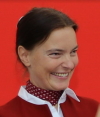
|
Prof. Ina Prinz - Bonn, Germany. 2018 Oughtred Society Award.
Dr. Korte is the director of the ARITHMEUM museum for historical calculating instruments in Bonn. She expanded its collection by donations, acquisitions and building replicas, and hosted events for collectors, such as RST meetings and the IM2017 international meeting of collectors and researchers of historical calculating instruments.
|

|
Bryan Purcell - Dearborn Heights, Michigan.
United States. Collector. High school math and physics teacher. Member of the Oughtred Society.
Contributor to the Journal of the Oughtred Society. He enjoys trips with his wife to various science museums, planetariums, and the like.
Created his educational website Cosmic Quest Thinker
Bryan says he is aspiring author of soon-to-be books on slide rules, math and science, and others.
|
Top
A
B
C
D
E
F
G
H
I
J
K
L
M
N
O
P
Q
R
S
T
U
V
W
X
Y
Z

|
Liu Qinglin - Bejing, China. Dealer. A mining engineer in the coal industry. Liu finds
Chinese slide rules and sells them on eBay. This is where most of the Chinese SR's that collectors
have came from.
|
Top
A
B
C
D
E
F
G
H
I
J
K
L
M
N
O
P
Q
R
S
T
U
V
W
X
Y
Z

|
David Rance - Sassenheim, The Netherlands. Collector/Author. Fellow and 2011
Award winner of the Oughtred Society. Member of the German Rechenschieber Sammler
Treffen (RST), the UKSRC and the Dutch KRING. Regularly presents at Int. Meetings
(IM's) and publishes articles in the JOS, SR Gazette and newsletters of the national
organisations. Now retired but previously worked 25 years for Shell International -
ending up as a Global I.T. Strategist. In 1991, while unpacking a moving box, David
came across his long-forgotten slide rule. He was intrigued and soon a schizophrenic
idea was born: "What else could a computer man collect but analogue slide rules!" He
is especially interested in acoustic and desktop slide rules but also in anything with
a "whacky" or unusual scale. David has his own website.
|

|
Joseph Griffith Reed - (1867-1969) Australian Physicist and Radio Engineer.
Designed the Reed Electronic engineer's slide rule (1935) made by the Service Slide Rule Co.Sydney in Sydney.
Trainee engineer, P.M.G.'s Department,
1913-21; engineer, Coastal Radio Service, 1921-22. Radio operator R.A.N. 1914-19. Engineer,
A.W.A. Ltd., 1922-50. Radio engineer, Overseas Telecommunications Commission, 1950-62.
|

|
Hermann Robert Reiss - (1844-1911) Original founder of East German precision
instrument company that was located in Bad Liebenwerda (1882) as a mail-order house
for office and drawing supplies. Later REISS developed into a well known maker of
precision instruments (eg. theodolites, planimeters, drafting machines) and the
largest manufacturer in the region. In 1912, after the founders death, their first
REISS slide rule came on the market. Models with extended root-scales (STELLFIX)
were made in 1920. This gave a 10" slide rule the precision of a 20". After WWII
the company became a GDR-run business and exported slide rules to the eastern and
western world. REISS was well known for their beautiful light metal slide rules.
|

|
David Riches - UK. Collector. Member of UKSRC. Fellow of the Oughtred Society.
Donor of scans of rare British slide rules for the ISRM galleries. His website is:
Mathematical Instruments
|

|
Ronald van Riet - Netherlands. Collector. 2009 Fellow of the Oughtred Society. Member of
Dutch Circle of Slide Rule Collectors (KRING). Ronald still has the Aristo 903LL that served him
through high school and Technical University Delft (Electronics) later supplemented by an HP calculator.
He spent his professional working life in software engineering and has not used slide rules other
than through his pastime passion of flying where he has been a proficient user of the E6B flight computer.
Ronald has always remained interested in technical tools and when he saw in a flea market a 2 metre
demonstration slide rule of his beloved Aristo, he became hooked on slide rules and they became his
new collecting passion.As a licensed pilot, his main interest in flight computers and their use in navigation.
|
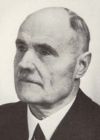
|
Max Rietz - (1872-1956) German engineer from Erfurtof who designed the
"System Rietz" layout of scales, a modification of the Mannheim set of scales,
which was patented (DRGM 181110) in 1902. The Rietz system becomes the universal
slide rule of mechanical engineering and was first produced by manufacturer,
Dennert & Pape.
|
|
|
Herman Ritow - (?-?) Frederick Post acquired the US Patent 1,405,333 issued to Herman Ritow of Chicago for 50- or 100-cm-long scales cut into 25cm segments which are placed side by side on a linear slide rule. Post used this design for slide rules from 1925-30 and were marked "Pat'd. U.S.A. 1/31/22" The few rules which don't carry the patent date are from early in the period when Koch, Huxhold & Hannemann was still using the same paper table ("Slide Rule Data Slips") that they had been using for other English production.
|

|
Willy Robbrecht - Denderbelle, Belgium. Collector. Member and 2013 Fellow of the Oughtred Society. Member of UKSRC. Member of the Dutch Circle Kring. Studied mathematics and finished a Ph.D. in astrophysics at Brussels University. Author of a series of innovative papers about less-known slide rules : Morin, Marc and Unis in Journal Mir of Kring, Arnault-Paineau in Journal of the Oughtred Society, Arici and Mono-Skala in Slide Rule Gazette.
|

|
William (Bill) K. Robinson - (1926-2018) Phoenix, AZ. Collector.
Fellow of the Oughtred Society. Boeing Engineer. Leading researcher of
slide rules with hyperbolic scales. Author of
Listing of all Known Slide Rules with Hyperbolic Scales (.xlx spreadsheet)..
Favorite SR is his 4088-3 purchased in January 1944
Bill's complete archive preserved by Rod Lovett on the OS website.
|
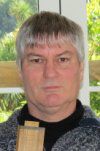
|
Phillip Rodley - New Zealand. Collector. Contributor and donor of slide rules to ISRM.
Phil used a slide rule for one year at high school before calculators came in.
He then spent 18 years working as a telephone linesman and
later 18 years assembling and testing 11,000 volt circuit
breakers. In all those years he never needed to use a slide rule, but recently
has begun enjoying relearning slide rules and logarithms.
|

|
Peter Mark Roget - (1779-1869), London, England. A physician who was also a professor of physiology, he wrote volumes in steadfast opposition to the cult of phrenology. In 1815, Roget developed a "log log" slide rule, which included a scale displaying the logarithm of the logarithm. This allowed the user to directly perform calculations involving roots and exponents. This was especially useful for fractional powers. He was duly elected a Fellow of the Royal Society. In 1824, he delivered a paper on the persistence in the brain of flickering images, the key concept behind motion pictures and animation, and may have later invented a stroboscope. A chess enthusiast, he solved the general form of the "knight's tour" landing on each chessboard square once and only once. In retirement, he compiled the first editions of the famous book of synonyms we know as Roget's Thesaurus (1852), it is said to combat bouts of deep depression.
|

|
Albert Rohrberg - (1887-1966) Berlin, Germany. Studies mathematics and physics at Technische Unversitaet Berlin Germany. Teacher of Mathematics in Berlin 1913-1942, than at Gauss-school for applied sciences Berlin. 1948 professor of mathematics Gauss-school Berlin. Publications about didactics of mathematics and about slide rules . Inventor of the Faber Castell No.342 "Columbus" and the Faber Castell No.307 "Kleiner Columbus".
|

|
Maurizio Romano - Bari, Apulia, Italy. Computer Science Degree in 1992 and post graduate specialization in Computer Vision and Robotics.
Currently involved in the development and support of an enterprise application framework, R&D Framework back-end manager at Talentia Software.
His main hobby is electronics and photography but for years he has been collecting slide rules from 1920 onwards. He's a contributor to ISRM's preservation projects..
|

|
Dick Rose - Columbus, Ohio, USA. Collector/Dealer. Sold new and used slide
rules on-line from an extensive inventory along with other drafting instruments at the now defunct
website:www.rose-vintage-instruments.com. The domain expired in 2018.
|

|
L.W. Rosenthal - United States. Inventor of the multiplex slide rule (Dietzgen).
Author of the manual Mannheim Multiplex Slide Rules (1905, 1908, 1911) and
Mannheim And Phillips Slide Rules: Theory and Practical Application (1915)
and others published by Eugene Dietzgen Co.
Associate member of American Institute of Electrical Engineers (existed between 1884-1963).
|

|
Paul Ross - Fair Grove, Missouri, USA. Collector. Fellow of the Oughtred Society.
World's leading authority on Post slide rules and perhaps also Hemmi slide rules, has largest
Post collection and possibly largest Hemmi collection; co-authored the Post slide rule
archive with Ted Hume (see
Slide Rule Universe; he authored the Hemmi Slide Rule Catalogue Raisonne, which may be viewed
on his website The Slide Rule
Trading Co., he also is a world class contract bridge player.
|

|
Joshua Routledge. - (1773-1829) UK. created the Routledge Engineer's
Slide Rule sometime before 1805 when he wrote and published the first-known
edition of "Instructions for the Engineer's Improved Sliding Rule." The Routledge
Rule combined a 12-inch brass slide using Edmond Gunter's (1581-1626) logarithmic
scale with an ordinary 2-fold, 2-foot rule. Routledge's interest in mathematics and
mechanics likely came by his father, William Routledge, a Yorkshire blacksmith and
Methodist lay preacher. By 1800, Joshua was working in Leeds as an associate of
Matthew Murray, a highly respected and innovative steam locomotive manufacturer.
Circa 1810, Routledge moved to Bolton Lancashire and established himself there as
an engineer and inventorii. In 1824, he undertook an engineering contract with A Evans
in Warsaw Poland. There, tragically, he took ill and died penniless, having, for
obscure reasons, been unpaid for his services. The Routledge Rule, however,
lived on and evolved into other useful devices such as the carpenter's rule and
the Eureka Slide Rule which was still widely used well into the 20th century. .
|

|
Gary A. Roark. - Pickett Company Sales Representitive.
|

|
Werner Rudowski - Bochum,Germany. Collector. Member of Oughtred
Society and Rechenschieber Sammler Treff (RST). Oughtred Society Award 2009.
Werner Rudowski studied process engineering and was involved in heat exchangers and special
equipment for the chemical industry for about 40 years. At the beginning of my career he was
posted to London for seven months and for about four months to Tokyo.
In the early 70s he developed a slide rule for designing air coolers. It was made by ARISTO.
Researched deeply (mainly English and German historical 17th to 19th century slide rules),
resulting in high quality ground-breaking publications for in the JOS, Skid Stick and
the SR Gazette as well as for the RST and Proceedings. Since 2004 he wrote 29 papers. Retired Engineer.
|
 < <
|
Harold (Dave) David Rueb - ( 1939 - 2009) Martinez, CA. Was an avid K&E slide rule collector.
Structural engineer for 40 years, 37 years as the owner of H.D. Rueb Structural Engineer.
Obtained his Architectural Engineering Degree at Cal Poly, San Luis Obispo ('61). Delta Sigma Phi Fraternity.
Upon graduation, he served our country as a Captain of the Civil Engineering Squadron in
the U.S. Air Force ('62-'68). Dave was stationed at Duluth AFB in Minnesota and Elmendorf AFB
in Anchorage, Alaska. Master's Degree in Structural Engineering at UC Berkeley ('69).
Dave engineered over 5,000 buildings in 10 states, including churches,
public schools, office buildings, retirement centers, country clubs, shopping centers, commercial
buildings, medical buildings and private residences. A few examples of his projects included the
Alhambra High School, Longs Drug Stores and the prison retrofit at Alcatraz Island.
He is survived by his wife Leslie Marie (Olson) Rueb and three sons.
See Harold David Rueb Obituary
|

|
John H. Runnels - Baton Rouge,Louisiana. Lawyer. Member of the Oughtred Society.John works for Taylor, Porter, Brooks & Phillips L.L.P. and is engaged primarily in the practice of patent law, including chemical patent prosecution, biotech patent prosecution, patent licensing, university technology transfer, and related matters. John sells slide rules on ebay using the moniker: Slide_Rule_Alley.
|

|
Thomas A. Russo, Sr. - Wilmington, DE. Russo was in the business equipment
and systems industry for over 45 years. He joined Remington Rand in 1954, holding
various management and executive positions. He left in 1971 to form the Delaware
Office Equipment Company, Inc. where he served as president until his retirement
in 1997. His second book on the subject of business machines, Antique Office Machines:
600 years of Calculating Devices, is a classic of its kind, and his collection
of office technology, including slide rules, is one of the largest of its kind in the world.
|
Top
A
B
C
D
E
F
G
H
I
J
K
L
M
N
O
P
Q
R
S
T
U
V
W
X
Y
Z

|
Washington Sabatini - (1923-1966). Italian inventor and manufacturer of
the Sabatini Concrete Calculator, first produced in 1930. W. Sabatini produced the second version in 1939.
The Ferrero Brothers of Savona, Italy acquired the Sabatini patents and produced a compact, handheld version.
|

|
Ryouta Saitou - Tokyo, Japan. Member of Slide Rule Lovers group in Japan.
|

|
Simon van der Salm - Hilversum Noord - Holland. Collector. Fellow of the Oughtred
Society. Member of KRING Historische Rekeninstrumenten. CEO at
Exact Education.
Concentrates collection on Pickett brands and Electric, Electronic and Statistical slide rules.
|

|
Warren Salomon - Miami, FL. Collector. Unusual combination of probate litigation
attorney and slide rule enthusiast. Avid researcher and collector of Hemmi 50 cm slide rules
|
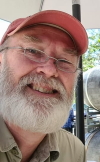
|
Darren Samphier - Melbourne, Australia. Collector. Member of Oughtred Society.
|

|
Robert Bruce Sandie - Melbourne, Australia. Collector. Member of Oughtred Society.Retired. He studied civil engineering at the University of Melbourne, worked in industry and was Head of the School of Civil Engineering and Building at Swinburne Institute of Technology/University of Technology for 24 years. From 1994 to 1997 he was Deputy Head of the Division of Science, Engineering and Design. In later years his research interests were in the behaviour of timber structures. He is interested in engineering heritage, is a past chairman of Engineering Heritage Victoria, and Chairman of the National Trust (Victoria) Bridges Committee, overseeing the assessment of Victoria's bridges for heritage significance.
He was elected to the Wallaby Club Committee in 2010 and Assistant Walks Secretary 2011.
|
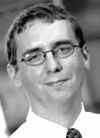
|
Chris Sangwin - Birmingham, England. Educator. Lecturer in Applied
Mathematics at the University of Birmingham. Created a
template for making Napier's Bones (Rods)
popular amongst collectors wishing to make replicas.
|

|
John J.G. Savard - Alberta, Canada. Nuclear Physicist. John says "My first slide rule was a Mannheim from
Engineering Instruments Ltd. of Peru, Indiana, but I received, also as a Christmas present, a better one while still in
Junior High, a Ricoh No. 121. While at University, I bought myself a Sterling Decimal Trig Log-Log, but wound up
sticking with the Ricoh until I could afford a pocket calculator. And I used several of those on my way to
earning a Master's degree in Nuclear Physics." John currently works as a computer programmer.
John Savard's Web Page has instructions
on slide rules along with with other topics in mathematics, science, computers, chess and
gaming. John has created several slide rule scale templates that may be used to construct
linear and circular slide rules available at ISRM's
Slide Rule Scales - Build Your Own SR
|

|
Wojciech Sawicki - Warsaw, Poland. Collector, Engineer, Author. Graduate of the
Warsaw University of Technology. Written over 150 books. His extensive slide rule (suwak
logarytmiczny in Polish) collection was displayed at Warsaw Polytechnic in 2005. His
website in Polish (use Google Translate tool to read
in other languages).
|

|
Daniele Paolo Scarpazza - New York City, New York.. Collector, Software Engineer. Born in Itay, Now in New York City where he works at D. E. Shaw Research and writes software for the Anton supercomputer. Formerly, I was a research staff member at the IBM T. J. Watson Research Center in Yorktown Heights. His
website in English and Italian.
|

|
Michael Scheffelt - (1652-1720) Germany. The earliest and most important inventor and maker of logarithmic and other scientific instruments in Germany. Born 1652 in the old South German city of Ulm. At the age of 14 he was sent to Nuremberg to learn the profession of a tradesman.
The portrait of 1691 shows him already with a "Proportionalzirkel" (sector) and other mathematical instruments. His first book on the "Proportionalzirkel" appeared in 1697. In his second book PES MECHANICUS of 1699 he described in detail a square ruler with many scales including logarithmical scales of numbers, sines and tangents to be used with a pair of dividers.
In all his books he described in detail the scales, how to construct and where and how to use them. He became a teacher for arithmetic and geometry at the Gymnasium academicum at Ulm .
Image used by permission from permission was given by "Stadtarchiv Ulm, Signatur F4-U0331".
More by Werner Rudowski PDF.
|

|
Robert Schembre - Anaheim Hills, California, USA. Collector. Member of Oughtred
Society. Donor to the ISRM Slide Rule loaner Program. Project Engineer on Defense Projects.
Prefers Pickett brand slide rules, electronic and pocket slide rules as well.
|
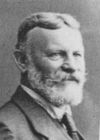
|
Daemen Heinrich Schmid - Manufacturer. Founder of the Swiss company Daemon-Schmid,
Zurich, Switzerland, which later became Loga. Asigned over 10 patents related to cylindrical
(roller) slide rules and mechanical calculators.
|

|
Dr. Werner H. Schmidt - Greifswald, Germany. Member of Ougtred Society.
Professor of Numerical Analysis and head of the computing technical library at Ernst Moritz
Arndt University Greifswald, Institut for mathematics and computer science. Shares the 2009 OS
Award with Werner Girbardt for organising four international science and technology
symposia at the Ernst Moritz Arndt University in
Greifswald, for setting up the
Rechentechnische Sammlung museum collection which includes an information rich on-line
catalogue of the slide rules and other calculating
instruments from the collection.
|

|
Georg Schreiber - Collector. Member of Rechenschieber Sammler Treff (RST)
|

|
Ir. IJzebrand Schuitema - (1929-2013) Netherlands. Collector/Author. Fellow of the
Oughtred Society. Oughtred Society Award 1995. Wrote several technical and historical
publications about slide rules and history, the
most known is Calculating on Slide Rule and Disc September 2000 and May 2003,
Astragal Press, coauthored with Herman van Herwijnen. Graduated as a Civil Engineer
from the Technical University Delft, South Holland, the Netherlands. Retired in 1986
from a career in civil engineering, management and university lecturer. Member of the
Dutch Circle of Slide Rule Collectors and one of the world's foremost authorities on
the subject of slide rules. Donor of slide rules for the ISRM slide rule loaner program in Europe.
IJzebrand donated his slide rule collection, the "Schuitema Kollektion",
to the Arithmeum in Bonn, Germany in 2008.
|

|
Conrad Schure - ( - 2020) - Freehold, NJ. Collector, Fellow of the Oughtred Society.
Oughtred Society Award 1994. OS 2nd VP and Treasurer.
One of the worlds most advanced researchers and collectors of rare slide rules and related
instruments; prolific contributor to the OS Journal. Has hosted the East Coast meetings of the OS.
|

|
A.R.(Dick) Schwartzer - (1933-2005) Professional Electrical Engineer.
Retired from the Salt River project in Arizona in 1991. Founder of the Slide Rule
Emporium in Scottsdale, AZ, and collector of scientific instruments, he had the
foresight to recover all of Pickett's slide rule inventory out of Mexico, before
they were to be scrapped for the aluminum, when the calculator created the demise
of the slide rule industry. In the last years, even though wheel chair bound and
on oxygen, Dick faithfully maintained sales of NOS Picketts out of his home until
his death.
|

|
Carl Schwent - Tucson, Arizona. Collector. Oughtred Society member. Found a cache of new
Pickett slide rules in the back of a store and bought the whole lot.
|
 -->
-->
|
Greg Scott - Brisbane, Queensland, Australia. Collector. Oughtred Society member.Provided Hemmi slide rule manuals to ISRM Library. Gregg is a CEO of a company that specializes in the field of cryptographic key management and produces software development kits to protect storage systems for data at rest and commercial transactions. The company also founded and continues to sponsor the most widely used open-source cryptographic toolkit used in a wide range of commercial products to protect users and their data.
His site is http://sliderule.ozmanor.com/
|

|
Steve K. Seale - Nashville, Tennessee. Collector. Oughtred Society member.
Ph.D. Chemistry, University of Alabama. M.B.A. with a focus in Finance and Accounting. Worked with X-ray diffractometry, nuclear magnetic resonance, scanning electron microscopy, thermal analysis, and instrumental analysis. Steve's chemical work has almost always involved math and computer programming. Now retired. Steve has contributed scans to ISRM from his own collection which can be seen at
Steve's Slide Rules.
|

|
Susan Shawlee - British Columbia, Canada. Hollywood actress. VP of Finance of Sphere Research Corp. Graduate of the University of California, Los Angeles. Susan and her husband Walter founded Northern Airborne Technology (NAT), an avionics and R&D company, which would later relocate to Kelowna. After transitioning NAT to new owners, they founded Sphere Research Corporation, which set the course for 30 years of enthusiastic research and development, test equipment metrology, and slide rule preservation. Upon Walter's passing, Susan Shawlee, has taken on the task to continue Walter's slide rule and electronic equipment sales on a new Sphere Research Corp website.
|

|
Walter Shawlee II - (1949-2023) British Columbia, Canada. Electronics engineer, teacher, entrepreneur, and slide rule aficionado. Fellow of the Oughtred Society, Oughtred Society Award 2006. Walter and Susan founded Northern Airborne Technology (NAT), an avionics and R&D company, which would later relocate to Kelowna. After transitioning NAT to new owners, They founded Sphere Research Corporation, which set the course for 30 years of enthusiastic research and development, test equipment metrology, and slide rule preservation. He was the recipient of the Commemorative Medal for the 125th Anniversary of Confederation (1992 - Given to 42,000 Canadians for significant contribution to their fellow citizens, to their community or to Canada). He chaired the BC Science Council, and mentoring young people on working in STEM fields as a teacher for OUC.
Slide Rule Universe.. His wife, Susan Shawlee, has taken on the task to continue Walter's slide rule and electronic equipment sales on a new Sphere Research Corp website.
|
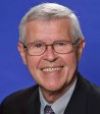
|
Thomas H Sheahan - Memphis, Tennessee. Research Geologist (retired). Designer of the
Ground Water Hydrology Computer (1967) for Layne Research Division, as well as numerous
other circular slide rules that he designed and has donated to ISRM.
|

|
Rodger Shepherd, M.D. - Oakland, CA. Fellow of the Oughtred Society. Oughtred
Society Award 1992. Original co-founder of the Oughtred Society,
advanced researcher and collector, retired physician. He started and published
the Journal of the Oughtred Society (JOS) in the early years. Was inaugural
recipient of the Oughtred Society Award. Translated Dieter von Jezierski's book,
Slide Rules: A Journey Through Three Centuries from German into English.
|

|
Derek Slater - Kettering, Northhamptonshire, United Kingdom. Collector.
Member of UKSRC and the Oughtred Society,
|

|
Carl E. Smith, P.E. - (b.? - d.?) Founded
Clevland Institute of Electronics (CIE) which commissioned
Pickett in 1969 to make a slide rule specifically designed for their radio electronics course, designed by Darrell L. Geiger,
and this became the Pickett N515-T. Carl Smith received the BSEE from Iowa State University
in 1930 and professional EE degrees from Ohio State University in 1932 and 1936. He founded
Smith Practical Radio Institute in Cleveland in 1934
which eventually became the Cleveland Institute of Electronics. His first class started
with 16 students and consisted of courses in radio and electronics engineering, which
utilized slide rules as part of the course. Since 1956,
when the CIE patented its "Auto-Programmed" self-study method, more than 350,000 students
in the U.S. and some 70 foreign countries have gotten their start in electronics through
the institute. Carl E, Smith later ran Carl E. Smith Electronics (8200 Snowville Road. Cleveland, Ohio)
and wrote many articles and books about antennas up through 1989. In 1985 he was the recipient of the
National Association of Brodcasters Engineering achievement Award. He was also awarded the
Jack Poppele Broadcast Award in 1995, for persons who have made important and long term
contributions to the improvement of radio broadcasting.
|

|
Burns Snodgrass - (1886-1954) Brighton, England. Founder of the Unique Slide Rule Company in Brighton in 1920
Burns Snodgrass M.B.E, A.R.C.Sc., was a mechanical engineering lecturer at Brighton Technical College. Unique specialized in a wide range of wood slide rules with celluloid covered paper scales and were most popular within the United Kingdom, and its colonies. The manufacturing process used fairly basic woodworking tools and printing presses, unlike their high end competitors which had mechanical tooling to make machine divided scales. This made possible relatively inexpensive slide rules that could also be customized to a broad spectrum of industries. The first Log Log slide rules were made around 1928-1929 and sold for 12 Shillings in 1931. Burns made these by himself on a part time basis until 1935, where he added a couple of employes, along with his son. In 1945, the last year of WWII, they sold 100,000 slide rules. In 1951 they became the Unique Slide Rule Company, Limited. Burns Snodgrass was also the author of Teach Yourself the Slide Rule ©1955 which was published in 1955, one year after his death. The book was popular for use in many schools and with other makers, although the graphics referred only to the UNIQUE brand. In 1954, The company was subsequently managed by his son, Donald Clayton Snodgrass. After an illness in 1981, Donald retired and his wife, Elain Snodgrass, took over as Managing Director. Various relatives worked in many aspects of the company making this a classic family business, much like all the other silde rule companies. It is estimated that they sold more slide rules in the UK more than any other maker, 2.5 million or more.
In spite of their cheapness, older wood versions have survived in large numbers. They invested in all plastic slide rules in the early 1970's but found themselves, like other slide rule makers, obsoleted by the electronic calculator, and stopped production in 1975. They continued manufacturing other mathematical instruments up until 1993.
Teach Yourself the Slide Rule ©1955 (45.78MB PDF scan) is available in the ISRM Library.
|

|
Donald Clayton Snodgrass - (1919-1993) Brighton, England. Son of Burns Snodgrass, the founder of the Unique Slide Rule Company in Brighton which was founded in 1920. He worked in his fathers shop as earloy as 1935 while still in high school. after 6 years in the RAF during WWII, he marketed slide rules and other math instruments around the world. He traveled to .all parts of the British Empire, the USA, Japan, Australia, the Middle East and South America.
After Burns Sndgrass died In 1954, Donald became the managing Director. . After an illness in 1981, Donald retired and his wife, Elain Snodgrass, took over as Managing Director, though Donald was still the Director of the Company. After his death in 1993 the family closed the business.
|
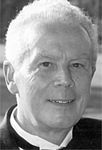
|
Joseph (Joe) L. Soper - Lakeville, Connecticut. Author of the book
K&E Salisbury Products Division Slide Rules, published by the Oughtred Society,
worked for K&E 29 years, managing the Salisbury Division and its slide rule manufacturing
for several years. Oughtred Society Award 2008. Joseph began working for Kueffel & Esser during the summers while in college, the went full time and was part of the transistion to the Azon/K&E Corp. One of his first assignments was the production of the Analon. He retired in 1995 when he closed the door for the last time on the K&E Salisbury Plant which was located in Canaan, Connecticut.
|

|
Elmer Ambrose Sperry -.(1860 - 1930) E.A. Sperry was an American inventor and entrepreneur, and slide rule collectors know him for inventing the Sperry's Calculator, a pocket watch slide rule that was made and distributed by K&E starting in 1903. He was most famous as co-inventor, with Herman Anschütz-Kaempfe of the gyrocompass and as founder of the Sperry Gyroscope Company. His compasses and stabilizers were adopted by the United States Navy and used in both world wars. He also worked closely with Japanese companies and the Japanese government and was honored after his death with a biography in his honor. More than fifty years of Mr. Sperry's life had been devoted to invention. At his death, he was said to have taken out nearly 400 patents, about double the number taken out by Edison.More at Wikipedia
|

|
Philip (Phil) S. Stanley - (1935 - ) Worcester, Massachusetts. Philip Stanley is a graduate of the Rensselaer Polytechnic Institute with a B.S. in engineering. He also holds an M.S. in computer science from Ohio State University. Stanley worked as a computer scientist until 1992, at which time he retired from engineering to become a full-time dealer in and appraiser of antique scientific instruments and tools as The Analytical Engine. He has written two books on antique measuring instruments, and numerous articles on instruments and technology, and has given several talks on these subjects. He is currently researching early U.S. patents with a view toward a book dealing with this subject. He is a member of the Oughtred Society (since 1993), the Scientific Instrument Society, the Early American Industries Association, and the Mid-West Tool Collector's Association. Phil appeared on the Antiques Road Show on PBS, as an appraiser, in 2012, 2013 and 2014. He is married, with three children and four grandchildren, and resides in Worcester, Massachusetts.
|

|
William Ford Robinson Stanley - (1829-1909) Holborn, London. Founded W.F. Stanley and Company,
manufacturers of mathematical, drafting and scientific instruments in 1854. It
became a limited liability company in 1900. In 1861, Stanley invented a prize-winning
straight-line dividing machine that was used to make accurate scales for slide rules
and other mathematical instruments. Among the slide rules manufactured were the Cooper
100 Inch Slide Rule (1923) and the Fuller spiral slide rule.
|
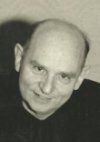
|
Leib (Leonid) Stern - (1914-1999) Ukraine. Inventor.
Designed the Stern Compressor Slide Rule for Soviet LFAI. Leib was born in the Ukraine and had a long
career as a metallurgical engineer in the USSR. He immigrated to Israel in 1987, and
lived out the rest of his life there. He had the knack for innovation that marks the best
engineers, and during his days as a metallurgist he had patented many inventions,
including the Compressor slide rule
shown in the ISRM Soviet Gallery.
Expanded Biography contributed by his daughter.
|

|
Larry Stewart - Canada. Collector. Artist.
|

|
Michael Stifel - (1487-1567) Germany. German Monk, Mathematician, Protestant Reformer. Ardent support of Luther.
Stifel invented logarithms independently of Napier using a totally different approach and was first to use the term exponent and clearly recognized related properties of multiplication and adding exponents.He published Arithmetica Integra, in 1544. He predicted the end of the world October 19, 1533 at 8 AM.
|

|
Michael Stoiko - (1919-2010) United States. Aeronautical Engineer and designer of the Martin Space (slide) Rule. He was an executive at the Martin Company when he designed the slide rule and was granted the patent. In 1940, he enlisted in the Marine Corps, and after completing flight training was assigned as a pilot and flight mechanic to Marine Aircraft Group 13 in the Pacific during World War II. He earned a degree in aeronautical engineering in 1949 from Brooklyn Polytechnic Institute, Stoiko's career began at General Electric Co. where he was a missile systems designer assigned to Project Hermes. He was a pioneer in the American Space Program, working on the captured German V-2 rockets (Operation Paperclip at White Sands missile Range), Proficient in German, he was able to study the captured V-2 documents. In 1954, Mr. Stoiko came to Baltimore and went to work for the Glenn L. Martin Co., later Martin Marietta, in Middle River, as a member of the team that designed the Viking, Vanguard, Titan 1, Titan 2 and Titan 3 missiles. He authored several books including a groundbreaking history of Soviet Rocketry based on never before source material sent to him by the Soviet space program. He was one of the first to strategize about the need for space rescue and presented his findings internationally and before Congress. After leaving Martin Marietta in 1970, Mr. Stoiko spent the last 19 years of his career as research and development program manager for the Navy's Naval Sea System Command and retired in 1989.
|

|
Edward A. Straker, Ph.D. - Reston, Virginia. Collector. Member of the Oughtred Society.
University of Tennessee. He earned his Ph.D. in Nuclear Engineering at the University of Michigan. His career, spanning more than 35 years, includes work at Oak Ridge National Laboratory, Science Applications International Corporation, and DESVentures, LLC. In 1984, he established the Slide Rule Collectors Association to create a community for individuals with similar interests. This organization was the precursor to the Oughtred Society. Ed has donated rare slide rule specimens to the Smithsonian National Museum of American History as recently as January 2012..
|

|
Carl Strange - Southbury, Connecticutt. Collector. Member and 2013 Fellow of the Oughtred Society. Past layout editor for the Journal of the Oughtred Society. Collects and restores early plastic and magnesium slide rules, especially interwar German and newer rules.
|
_th.jpg)
|
Chan Street - (1907-?) Electro-Optical Engineer, Owner of Street Laboratory and Industries of El Segundo, California. He designed the Pickett Electronic N-16-ES slide rule, circa
1960, which is labeled as having been "Designed by Chan Street, Los
Angeles" (California). This is a specialty slide rule having scales on one
side for electronic frequency and impedance calculations to determine tuned
circuits. He was issued two US Patents:US003193826 (1965) Wind Drift Recorder and US003609012 (1971) Optical Condensing System with Variable Effective Focal Length. His last known address was in 1974 was: Street Laboratory and Industries, 139 Nevada Street, El Segundo, California 90245.SLI Logo He wrote a Collective Optics column in the 1974 Optical-Engineering Magazine VOL.13, NO. 5). He published a 44-page booklet on Graphical Ray Tracing, mentioned in IEEE publication, September 1974. His company, SLI, manufactured and sold the Type 80 Photometer.(PDF)
|

|
Forster (Fang) Sun - (1988/11- ) Born in Luoyang, China. He studied at Yunnan University and then went to the Institute of Modern Physics, CAS, for his Ph.D. degree in the direction of heavy-ion radiation against cancer stem cells. He is also a flashlight collector.
|
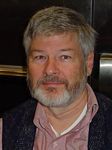
|
David Sweetman - (1948-2022) Dyer, Nevada. Collector. Member/Director of Oughtred Society. 2012 OS Fellow. Retired VP Quality and Reliability from Silicon Valley start-ups. Likes calculators like Thatcher, Curta, Arrow, Addiators, and various slide charts, along with Pickett and specialty slide rules. Has a solar electric, solar thermal, and wind powered home in Nevada. In late 2012, David became the Managing Editor of the Journal of the Oughtred Society (JOS).
David was given the 2014 Oughtred Award for his crucial role in all publication activities of the Oughtred Society. He was a great supporter of ISRM and he was the reason that I published the digital Kindle editions of the ISRM Slide Rule Instructions
Reprint Series since, with his inclusion body myopathy (IBMPFD), he could not hold a book in his hands. He will be sorely missed by all.
|
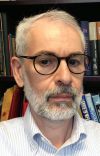
|
Daniel Swerdlow - Bethesda, Maryland. Collector. Daniel Swerdlow is a second-generation engineer from New York City and has degrees in electrical engineering from New York University and Michigan State University. He has done telecommunications engineering for major corporations and currently lives in the Washington, DC area and works at the United States Patent and Trademark Office. Dan has gifted most of his collection to ISRM to support the museum. Many specimens may be found in the various ISRM galleries.
|

|
Michael J. Syphers - Batavia, Illinos. Collector. Member of Oughtred Society. Mike is Research Professor of Physics at Northern Illinois University and a Senior Scientist at the Fermi National Accelerator Laboratory (Fermilab) in nearby Batavia, Illinois, USA. His career has been dedicated to the design and study of large-scale particle accelerators and charged particle beam transport systems, as well as to education in the field of accelerator physics. He has held scientific appointments at several national laboratories, including Fermilab, the Superconducting Super Collider Laboratory in Texas, Brookhaven National Laboratory in New York, and the National Superconducting Cyclotron Laboratory at Michigan State University. He has worked on a large variety of particle accelerator projects and is a frequent instructor at the U.S. Particle Accelerator School (USPAS). Mike is a Fellow of the American Physical Society. See his collection at Following The Rules.
|

|
Maciej M. Sysło - Warsaw, Poland. Collector. Professor of
mathematics and computer science at the University in Torun and Wroclaw and
is engaged in information technology education. His interest expands beyond
slide rules to mechanical calculating machines and has made replicas of
various artifacts. See his Mechanical Calculator Exhibit.
|

|
Jacek Szukowski - Poland. Collector. Technologist for Pratt & Whitney, Kalisz.
ISRM Associate (webpages under development). Jacek has collected slide rules and books
since 2000 and has over 500 specimens in his collection.
|
Top
A
B
C
D
E
F
G
H
I
J
K
L
M
N
O
P
Q
R
S
T
U
V
W
X
Y
Z

|
Andreas Tabak - Netherlands. Prolific ollector of almost anything technical. Beside slide rules, he collects computers, mouse pads, old stock certificates and many other interesting items. His website is
The Collection of Calculating Devices - TCoCD. Some of his collection appear in the ISRM galleries.
|

|
Masayuki Takahashi - Hokkaidou, Japan. Member of Slide Rule Lovers
group in Japan.
|

|
Paul J. Tarantolo Jr., PhD. - Houston, Texas. Collector and member of Oughtred Society.
Contributor of slide rule, pocket watch calculator, and manual scans for the ISRM galleries.
Paul is a retired ExxonMobil research geophysicist and executive and has been collecting
slide rules since 2005. He specializes in K&E slide rule variants and pocket watch calculators
and is also an avid mineral collector.
|

|
Edwin Thacher - (1839-1920) Pittsburg. United States. Best remembered as the inventor of the
Thacher cylindrical slide rule, sold by K&E as the model 4012. His patent for this slide rule was
U.S 249,117 issued November 1, 1881. The description include: The purposes of my invention are
to increase the length and accuracy of scales without increasing the length of the rule and to
render the use of such rule more convenient. Edwin Thacher was born in 1839 in a place called
De Kalb, in Lawrence County, New York State, in America. His father was a doctor, but Edwin studied
engineering at college. His first main job as an engineer was in 1864 as a military railway builder
during the American Civil War. Later on he took up making bridges and worked for the Louis Bridge
and Iron Company. A lot of his job as a bridge engineer involved doing mathematical calculations
to work out how strong the steel girders and concrete beams in bridges needed to be. It was because
he spent a lot of time doing calculations that he invented his cylindrical slide rule. He died in
New York in 1920.
|

|
H. Loren Thompson - (1912-1976) United States. Co-authored (with Ovid W. Eshbach) most of the modern post-WWII era Dietzgen Instruction manuals. Also co-authored a 1943 Engineering drawing textbook with Issac Newton Carter. 1967 recipient of the Arthur Sidney Bedell Award, named for the second president of the Water Environment Federation. He was a corporate officer for Stevens, Thompson & Runyun, Inc. In 1972 H. Loren Thompson, Class of '34, was given the Honor Alumni Award from Rose-Hulman Institute of Technology.
|
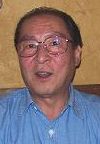
|
Atsushi Tomozawa - Asao-Ku Kawasaki, Japan. Collector of electronic gadgets, programming,
collecting/studying slide rules. Member of Slide Rule Lovers group in Japan.
Collects all slide rules, but his favorite is Sun Hemmi. His website (in English)
is has many pictures of Japan. His slide rules are displayed on
his SR-Annex.
Atsushi has worked in the USA in the 1970's and 1990's. He is a contributor to the
OS Bulletin and avid aurora borealis observer, for which he travels the world.
|

|
Marc Thomas - Nantes, France. Collector. Member of the Oughtred Society. 2013 Oughtred Society Fellow.
Marc was a math professor at Lycée in Nantes, until his retirement in 2010. He has since been preparing a Ph.D. Thesis in the History of Science and Engineering at the Nantes University on the French manufacturers of slide rules.
|

|
Daniel Toussant - (1947 -2019) Aulnay-sous-Bois, France. Collector. Member of the Oughtred Society. His website (archived) LINEALIS.ORG was focused on the restoration of slide rules and French slide rule history. Daniel had a complete catalog of French manufactured Graphoplex and Koh-i-Noor Slide Rules. He was a contributor to ISRM.
|

|
Forrest Milton Towl - (1864-1946) United States - Entrepenuer, Author, Petroleum Engineer.
Designed and copyrighted (1889 & 1910) a Pipe Line Flow slide rule which was used in calculations involving the pumping of oil A 1910 version was used in the transportation of
oil. These hand divided and stamped slide
rules were marked as "COPYRIGHTED 1889, and later 1910.COMPUTED BY FORREST M. TOWL. C.E."
and on the edge by the maker "KERBY & BRO. N.Y."
Forrest M. Towl graduated from Cornell University in 1886 and in 1911
was a consulting engineer for the Standard Oil Company (later to be called Exxon and
Esso). In 1909 he was a member of the Shelter Island Yacht Club, New York He was President and Director of the
Cumberland Pipe Line Company, Eureka Pipe Line Co. Oil, and President of the Southern Pipe Line Company (1921)
which became part of Southern Group of Pipe lines, Standard Oil Company subsidiaries, in Oil City, Pennsylvania
He was still writing on oil industry matters in 1934. (Some text written by Peter Delehar, UK). See the 1937 article in Cornell's THE TRANSIT magazine on Forrest Milton Towl, Proffesor.
|

|
Bennie Tschoerner - (1941-2014) Paris, TX. Collector. Member of Oughtred Society.
Career: Teacher at Community College Teacher, Product Engineer at Texas Instruments,
Systems Engineer at E-Systems (Raytheon), Technical Director at Paris IGD.
Collection focusing on Addiators and mechanical adders.
cs and Math degrees from West Texas State University. He received his certification in Engineering Technology from the University of Illinois and did post graduate work at the University of Wyoming, Bucknell University, Trinity University, and East Texas State University. Bennie was a member of Phi Delta Kappa and Sigma Pi Sigma and recipient of the EPDA Grant Award for the State of Texas and Summit Award for Outstanding Commitment to Excellence in Videoconferencing. For those of you old enough to know what a slide rule is, Bennie was also World Slide Rule Champion for many years. He won the 2007, 2008, 2012, 2013 Slide Rule competition in Irving, Texas and the 2009 International
Slide Rule Museum championships in Las Vegas at the Oughtred Society meeting. Bennie was a 1959 graduate of Temple High School and received his B.S. and M.S. with honors in Physi Bennie's profession in life was a teacher. He taught physics, math, and electronics to those wanting to learn or those having to take his class to graduate. He was also a Product Engineer for Texas Instruments, Senior Electronics System Engineer for E-Systems, and Technology Director for PISD in Paris.
|
Top
A
B
C
D
E
F
G
H
I
J
K
L
M
N
O
P
Q
R
S
T
U
V
W
X
Y
Z
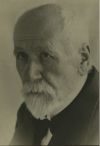
|
Franciscus Johannes Vaes - (1867-1943) Rotterdam, The Netherlands. Passed Engineers exam at Polytechnic School in Delft in 1888. From 1888-1893 was employed by the Maatschappij tot Exploitatie van Staatsspoorwegen (the Dutch Railway Company). From 1893-1895, taught
theoretical and applied mechanics and kinematics at Polytechnic, then accepted a position at the H.B.S. (middle school) at Gorkum and later in Rotterdam. In 1914 he took his last teaching position as an instructor of mechanical sciences at the Academy of Design and Technical Sciences in Rotterdam. He retired in 1933. He was issued the German patent 163933 in 1903. It described an ingenious slide rule design which offered an unlimited number of scales using stackable dove-tailed stocks. Vaes was the first Dutchman to write an instruction booklet on how to use this slide rule. His grandson owns an original prototype. See Oughtred JOS Vol.8,No.1, Spring 1999 by IJzebrand Scuitema. Vaes is also mentioned in Cajori's 1910 book, History of the Logarithmic Slide Rule and in the 1905 Calcul Simplified by French author M. d'Ocagne.
|

|
Franciscus (Frans) Johannes Vaes, Jr. - Rotterdam, The Nethelands. 1995 joined KRING, the Dutch Circle of Slide Rule Collectors. Grandson of Franciscus Johannes Vaes (1867-1943). Portrait is from 2009.
|

|
Panagiotis (Pano) Venetsianos - Greece. Collector. Fellow of the Oughtred Society.
Oughtred Society Award 2008. Researched Gauge Mark names and values and wrote the
Pocketbook of the Gauge Marks Published by the Oughtred Society in 2006.
|

|
Jorge Luis Victoria - Argentina. Collector. Member of the spanish-speaking SR group (ARC). Graduate of Universidad Tecnológica Nacional Buenos Aires, Argentina in Information Technology Engineering. Currently works as the Technology Manager at SL International Cargo S. A.
Parallel to his computer career, he designed and built several machines for the wood industry, including a complete small sawmill plant. His hobbies over time include model aircraft (design, build and fly), photography, electronics, woodworking, ironworking and recently 3D design and print. He began collecting SRs in 2004 after inheriting his father's slide rule, who had taught him the basic operation. In 2017 the research journal Pensamiento Matemático of the Universidad Politécnica de Madrid published his article on "Precisión en las Reglas de cálculo". In 2022 Jorge translated the ISRM SR_Terms and Encyclopedia page into a Spanish (Español) version.
|
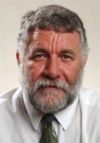
|
Adriaan Vorster - Johannesburg, South Africa. Collector.
Analog electrical systems engineer currently employed at the University of Johannesburg as the Chief Information Officer. MSEE from RAUHe with a post graduate certificate in Data Resource Management from the University of Washington, Seattle. Adriaan has spent much of his life solving complex engineering problems before entering the information systems field in 1991. He has designed, written, implemented and life cycle managed information systems specializing in enterprise architectures. He has contributed to international and local conferences and has published on the use of the Zachman Framework in mine planning. He actively studies, teaches and consults and his current interests include enterprise architectures and the study of complexity and chaos theory, as well as slide rules.
|
Top
A
B
C
D
E
F
G
H
I
J
K
L
M
N
O
P
Q
R
S
T
U
V
W
X
Y
Z

|
William (Bill) Walker - Saulte Ste. Marie, Ontario, Canada, Member of Oughtred Society.
Consulting Engineer. Has a braod spectrum of about 400 slide rules in his collection.
He is particularly interested in Circular and Spiral slide rules,
along with Hydraulic and Open Channel Flow rules.
|
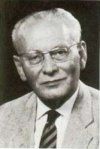
|
Dr. Alwin Walther - (1850-1920) Germany. As part of Technische
Hochschule Darmstadt (Institute for Practical Mathematics in the Darmstadt
College of Science and Technology) modified
and enhanced the "System Rietz" for the needs of engineers in 1936: A
Pythagorean scale on front was added. The mantissa scale was
transfered to the rear long side and the sine and tangent
scales to the front long side. The back side of the slider was
now free for the exponential scales. This "System Darmstadt"
became the base model for all future improvements.
|

|
Mike Weaver - United Kingdom. Electrical engineer, Engineering manager with Sony (UK) ltd at their Pencoed TV manufacturing plant until 2004. Works part time for the Welsh Assembly Government.
|

|
Mendell Penco Weinbach - (1881-1947). United States. Born in Romania, studied at Romanian
Lyceum before immigrating to the United States at age 20. He received A.B (1905),
B.S. (1907), and A.M. (1907) degrees in mathematics and engineering from the University
of Missouri in Columbia. He became a full professor in 1923. Pofessor Weinbach invented
a number of devices and held several patents, his most succesful being the Log Log Vector
slide rule that made computations easier for electrical engineeers. He authored the
instruction manuals for the Keuffel & Esser K&E 4093 and K&E 4083 vector slide rules.
He was paid a royalty by K&E for every slide rule of this model that was produced. See more at
Mendell Penco Weinbach and
the K&E Log Log Vector Slide Rules By William K. Robinson (5.3MB).
|

|
Stephan Weiss - (1947 - ) Germany. Collector. Fellow of the Oughtred Society. Graduated
from the TH Vienna and the TU Munich with a M.Sci. (Dipl.Ing.) in Mechanical Engineering.
After further studies worked as an expert in the fields of vehicles until 2007.
His special interests apply to the development of a collection of calculating machines
and devices as well as handling of freely selected topics of the history of computing aids.
Author of a series of articles and in-depth papers and presentations at International Meetings
(IM's). Maintaining the acclaimed website
Contributions to the History of Mechanical Calculation where you can see his many publications.
|

|
W. M. Welch - 1856-1940. Founder of W. M. Welch Mfg. Co. Chicago, Illinois
in 1880 by W. M. Welch (1856-1940). Name changed to Welch Scientific Company
in 1930 and located at 1516 Orleans Street, Chicago, Illinois. Specialized in
Scientific Instruments, Laboratory Apparatus and Supplies for Physics,
Chemistry and General Science. Made a four foot teaching slide rule
for hanging in classrooms Size: 2x23x125 cm. One sided, black background
with four white scales, out of Masonite, with Hangers. W. M. Welch later
became part of Sargent-Welch Scientific Co. Pumps were spun off and became
Gardner Denver Welch Vacuum Technology. Medard W. Welch, son of W.M. Welch,
was an original founder the American Vacuum Society in 1953.
|

|
Wern Brothers - Sweden - Carl R. Wern and George H. Wern had a company that specialized in
heating, plumbing, ventilation and air conditioning consulting. The company was started in 1963.
Carl R. Wern created in 1966 the slide rule design layout together with his two younger
brothers George H. Wern and Lars A. Wern. The Units were produced by IWA in Germany and
sold as the IWA 1638 System Wern ABC. It was a new approach to simplify slide rule computing work
for all categories including decimal point location.
The brothers also specialized in calculators that involved thermodynamics, all rather involved
calculations that were not easily solved. They developed several straight and circular slide rules
which solved specific problems and were made by the Swedish manufacturer INPLASTOR AB.
|

|
Edmund Wingate - (1596-1656) English mathematical and legal writer, one of the
first to publish in the 1620s on the principle of the slide rule, and later the author of
some popular expository works. He was also a Member of Parliament during the Interregnum.
More at Wikipedia.
|
 |
Jeff White - Teton Valley Idaho.Oughtred Member since 2000. Collector of Mechanical and Electrical Calculators and Slide Rules. Retired rangeland scientist, civil engineer. Attendeed the US Air Force Academy in 1974 where he was issued a Post versalog. He has a collection of over 750 slide rules.
|

|
Dr. Robert P. Wolf - sliderule.org Creator of Slide rule emulators
|
 |
John Wolff - Melbourne, Australia. Collector of Mechanical and Electrical Calculators and Slide Rules.
Maintains his John Wolff's Web Museum. John is a retired electrical engineer from Melbourne, Australia. His background is in electronic
instrumentation, control systems, and computers. He has worked in private industry, public utilities,
and academia for over 35 years, most recently as an IT manager in a government research laboratory.
For a second full-time job he is a sole parent to two teenage kids. For hobbies, he tinkers with
pianolas and mechanical music, and reverse-engineers antique calculators. For occasional light relief
he sometimes builds robots with the kids at an "alternative" school.
|

|
Thomas (Tom) S. Wyman - Palo Alto, CA. Collector. Fellow of the
Oughtred Society. Oughtred Society Award 2005.
Tom served in the U.S. Navy aboard USS Lexington. He graduated from Stanford University with
degrees in mining engineering and geology. He joined Standard Oil Company of California now
Chevron as a petroleum engineer and was involved in field operations in California and Alaska
and later represented his company's interests in its Saudi Arabian and Iranian operations.
He retired in 1992 as Chevron Shipping Company's manager of maritime affairs where he
represented his company's interests on industry boards, in UN organisations and in testimony
before committees of the U.S. Congress. He has received a series of industry and local awards and
remains active in local politics while also serving on several boards of directors of local civic
organizations. He has written extensively for publication on a variety of topics. He served as
president of the Oughtred Society from 1997 to 2007 and continues to be a frequent contributor
to the Journal of the Oughtred Society.
|

|
William Hyde Jackson Wollaston - (1766-1828) United Kingdom. Chemist. Physicist. Physiologist. Practised medicine from 1789-1801. Wollaston became wealthy by developing the first physico-chemical method for processing platinum ore in practical quantities, and in the process of testing the device he discovered the elements palladium (symbol Pd) in 1803 and rhodium (symbol Rh) in 1803. Also known for Camera lucida and Dark lines in the solar spectrum. Developed the Wollaston Slide Rule of Chemical Equivalents in 1814. Made discovery of absorption lines in solar spectrum; 1793 - elected a fellow of the Royal Society (FRS); 1795 - elected a fellow of the Royal College of Physicians; 1802 - The Royal Society awarded him the Copley medal;
|

|
Edward T. Wright, Ph.D - United States. Mathematician. Edward Wright received his B.A. with Honors in Mathematics from Rhodes College (formerly Southwestern at Memphis) in 1968, followed by his
Ph.D. in Mathematics from the University of Notre Dame in 1973. Ed's thesis was on compact Kahler manifolds that admit Killing vector fields.
After graduate school Dr. Wright was a visiting assistant professor at Notre Dame for one school year,then worked as an (applied) mathematician for the Department of Defense for 39 years. Ed retired 2014. Ed writes: "The only time I ever used a slide rule was in high school physics (1963/64). I started collecting them off of Ebay in the 2004/5 time period. I continue to marvel at how much was accomplished with these instruments. I am in the process of down sizing the modest collection that I have, and wanted them to go some place that will preserve this part of the technology."
|

|
Philip J. Wyatt, Ph.D - United States. Physicist. Dr. Wyatt founded Science Spectrum in Santa Barbara, California in 1964 which was awarded a government contract to use lasers to detect bacteria used in biological warfare. Using this company name, Wyatt later co-authored the design of the Octal-Decimal and Hexa-Decimal Circular slide rule 1969 which was awarded two US patents in 1972.
Prior to this, he attend Christ's College in Cambridge and received his Masters degree from the University of Chicago, Dr. Wyatt earned his Ph.D. at Florida State University. He was enamored with lasers that first appeared in 1960. In 1982, he founded Wyatt Technology Corp.(WTC) in Santa Barbara, which was initial funded as part of an SBIR (Small Business Inovative Research) whose scientists invented the very first commercial light scattering instruments incorporating lasers as their light source. WTC is currently is involved in the research, development, and commercialization of absolute macromolecular characterization techniques and their instrumentation.
|

|
Thomas Yorker - Troy, NY. Collector. Member of the Oughtred Society. Favorites are
scientific slide rules. Programmer/Analyst by profession. A long term patron to ISRM.
|

|
Nathan Zeldes - Jerusalem, Israel. Collector. Member of the Oughtred Society.
He prefers home-made or low volume manufactured slide rules. His website
History of Computing
was started when he became a collector in 2001, when he used a long vacation to create an exhibition of computing history for his workplace.
|
Top
A
B
C
D
E
F
G
H
I
J
K
L
M
N
O
P
Q
R
S
T
U
V
W
X
Y
Z

|
GuiSheng Xu (Xu GuiSheng) - Shanghai, China. Collector. Guisheng has been collecting slide
rules for over 30 years and used to maintain a Chinese website,
http://www.sliderule.com.cn Slide Rule Zone, which was written in English
and Chinese, and provided information about the history of Chinese made slide rules. The URL is no longer active. He gets most of his specimens from
the antique market on Fuyou RD. in Shanghai. GuiSheng says "This market is the biggest antique market in East China area . Unearthed artifacts from the
imperial court, and from people to people exchange all over the country flow into this market continuously".
|

|
Nathan Zeldes - Jeruselum, Israel. Collector, Member of the Oughtred Society. Nathan Zeldes is applied physicist by education, engineer by vocation. He is a globally recognized thought leader in the search for improved knowledge worker productivity. After a 26 year career as a manager and principal engineer at Intel Corporation, he now helps knowledge-based organizations solve core problems at the intersection of information technology and human behavior.
Nathan's History of Computing website.
|
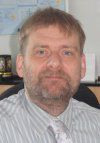
|
Dr. Detlef Zerfowski - Germany. Author. Collector.
Member of the Oughtred Society and UKSRC. Studied Computer Science at the
University of Karlshrue, Germany. Finished Phd in 1988 in the domain of signal
transformations in medical imaging. During this time he became interested in
mechanical calculators and slide rules. Detlef is currently working for the German based ETAS Group, an
automotive supplier in Bangalor, India, where he lives with his family.
Detlef has recently published his 1574 page book, an effort of 13 years, titled:
Our World-wide Knowledge on Calculating Machines, Slide Rules and Calculating Tools.
An Approach for a Comprehensive Overview of the Knowledge from Past until Present.
that can be purchased directly through
Detlef's website.
|

|
Skip Zogopoulos - Exeter, NH. Collector. Member of the Oughtred Society,
Contributor of scans for the ISRM galleries, Donor of the Fedra slide rules to ISRM's
SR Loaner Program. Skip teaches a homegrown free slide rule class and has been
a drummer for a 60's band, The Wayback Machine.
|

|
YOU - Add your story!
|
Top
A
B
C
D
E
F
G
H
I
J
K
L
M
N
O
P
Q
R
S
T
U
V
W
X
Y
Z
|

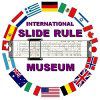 HOME
HOME

















_th.jpg)



































































































































































































































 <
<




































_th.jpg)





































